36 BEST Places to Visit in Algarve Portugal + Free Map Included!
Wondering where to go or what to do in Algarve? Get some inspo here!
The Algarve, on the south coast of Portugal , is one of the most popular destinations in Europe for lots of reasons.
While its golden beaches, internationally acclaimed for their beauty, are the primary draw for most visitors, the region offers a diverse range of activities beyond the sun-soaked shores. Whether you’re looking for a relaxing vacation or a chance to do some exploring, staying in the Algarve is sure to be unforgettable.
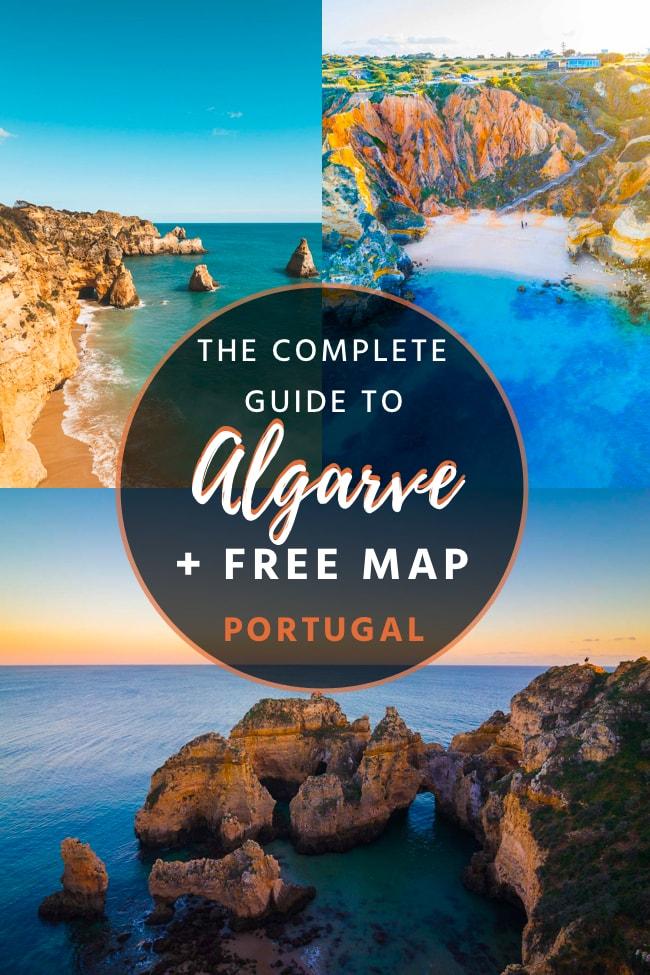
TABLE OF CONTENTS

Where is the Algarve Region Located?
Where to stay near the best spots in algarve, map of the best places in the algarve, the best places to visit in the algarve, tips & info to travel algarve.
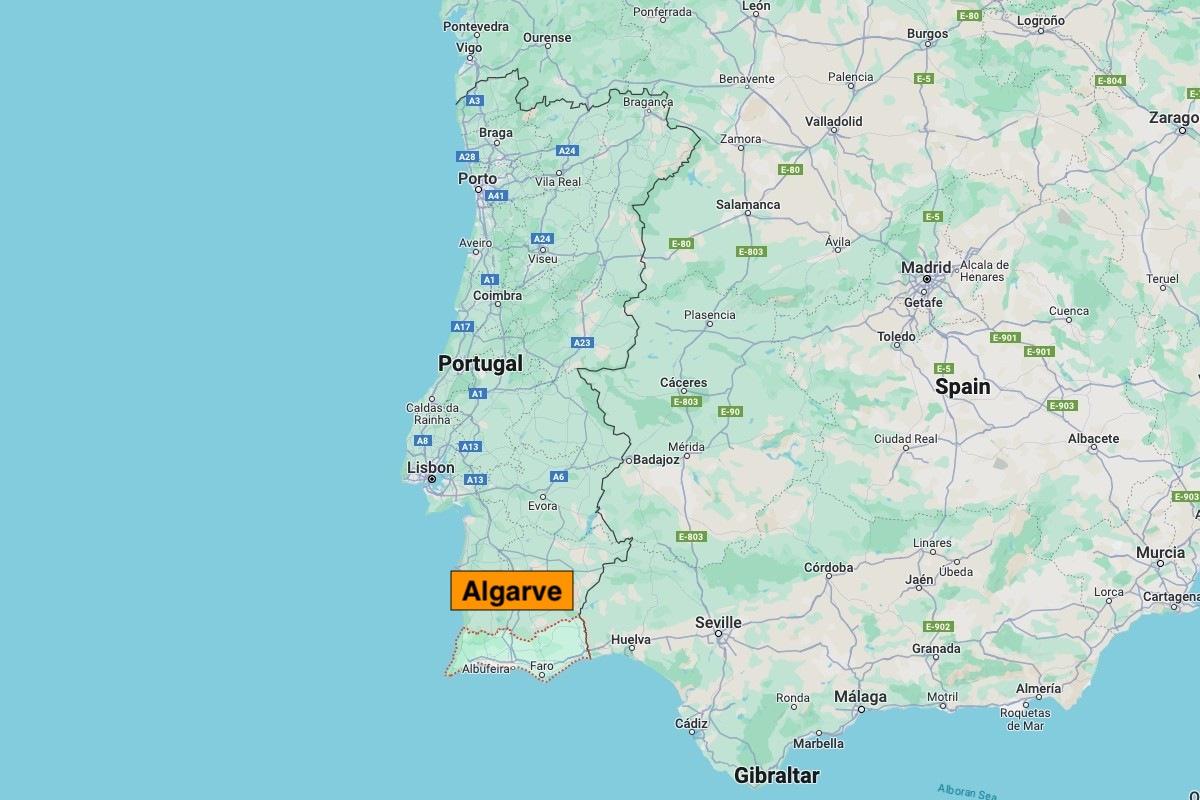
The Algarve coastline spans over 2,000km (1,243 miles), full of amazing beaches and hiking trails with spectacular views. But there’s more to see: castles, churches, ruins… The area has it all for a perfect holiday!
If you’re wondering what are the best places to go in Algarve and what to do, then this guide is for you.
Ready to discover the Algarve? Here are the 3 main locations I recommend for your stay in Algarve:
⭐️ Best Overall – Lagos: It’s THE best place to stay for visiting the Algarve region! I recommend the Cascade Wellness Resort as the perfect home base for further visiting, or the Hotel Lagosmar for a budget option.
❤️ Best for Couples – Tavira: The most romantic town for couples, book the very central Maria Nova Lounge Hotel – Adults Only for the best stay.
👨👩👧👦 Best for Families – Albufeira: For the best family vacation, Albufeira is the right pick, especially if you choose this hotel.
I’ve gathered the 36 best places to see in Algarve on a map to help you travel the region easily and make sure you don’t miss anything. Get it right in your inbox for free. 👇
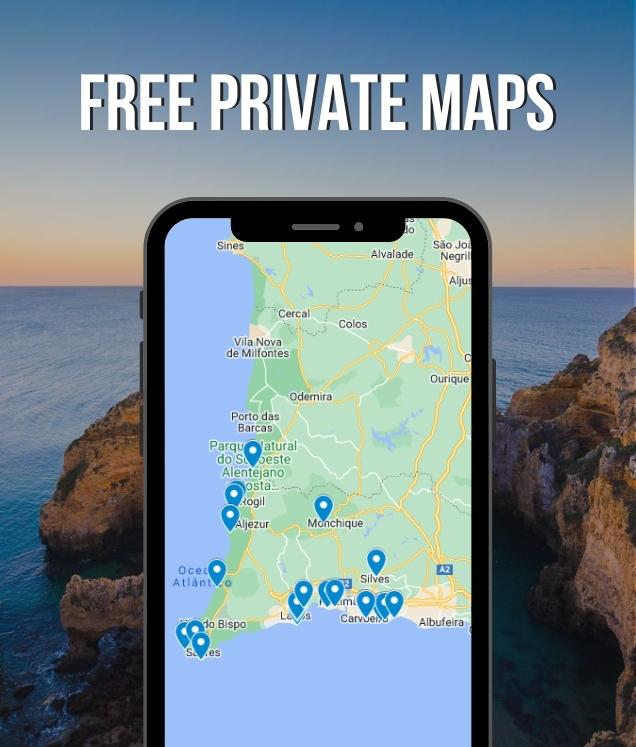
Get your FREE Private Map
Ready to travel Algarve? Don't miss the best places to visit there thanks to my map I've created myself after my road trip throughout the region. Get it straight to your inbox now!
If you want to know more about these best places in Algarve, keep reading below. You’ll find information about each spot, along with photos, so that you can easily decide if you want to visit or not.
1. Praia da Marinha
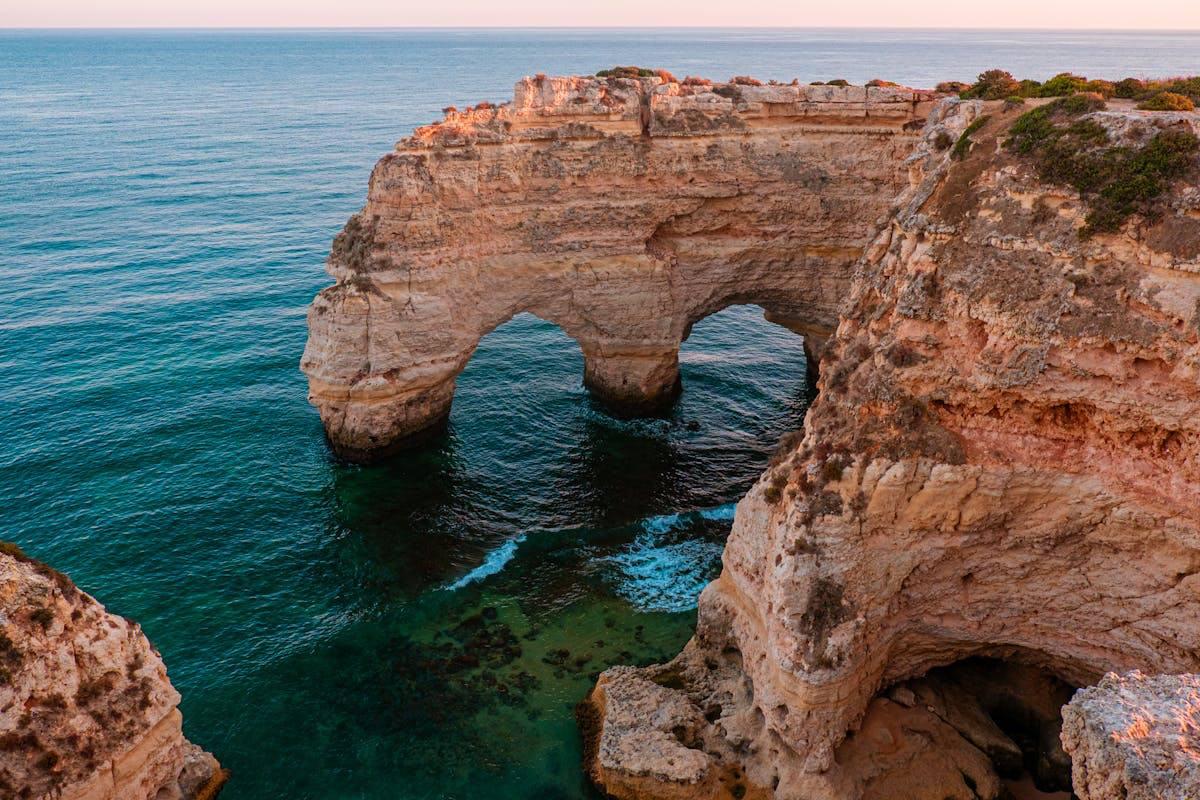
Praia da Marinha ranks among the 100 most beautiful beaches in the world, thanks to its exceptional setting and impressive rock formations.
This rock formation in the photo is called “Arco Natural”. It makes for an epic backdrop while you relax on the beach, or you can discover it from above hiking the famous Seven Hanging Valleys Trail.
2. The Seven Hanging Valleys Trail
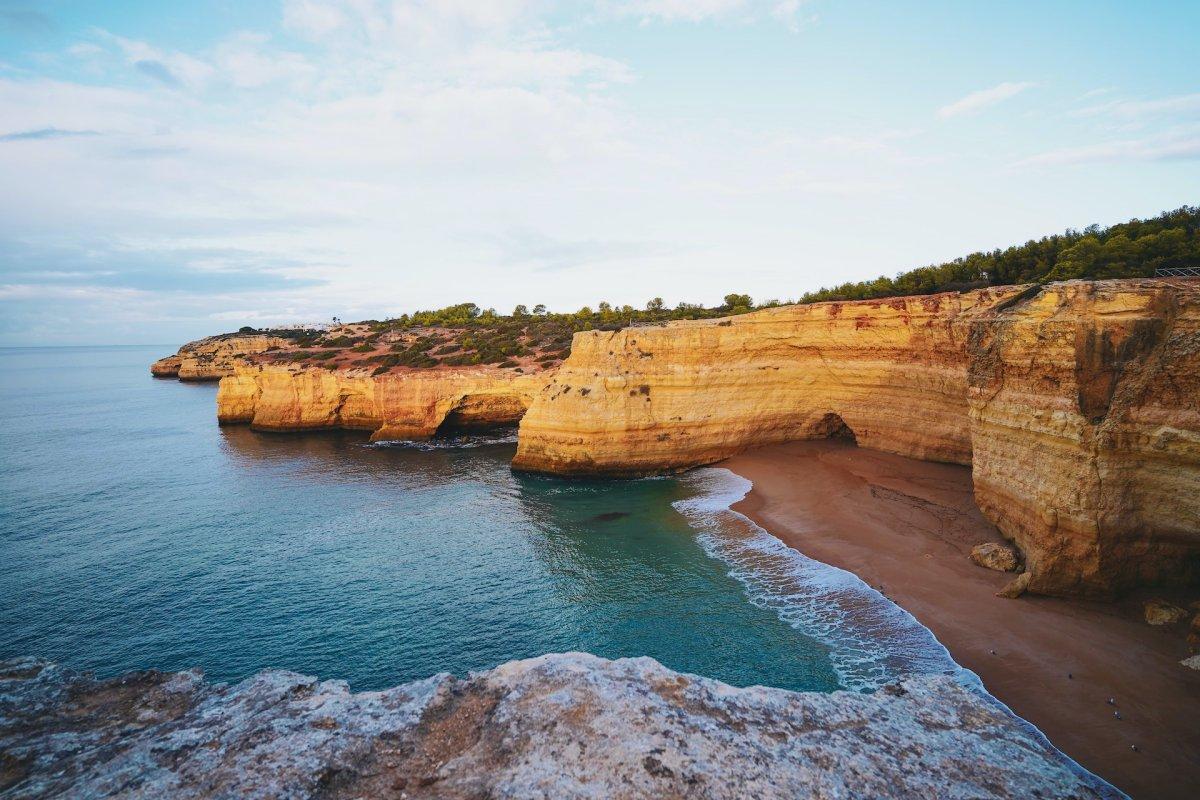
This route covers a total of 6 kilometers each way, taking you through a jaw-dropping landscape that’ll have you in awe the entire time. Honestly, it’s a must-do in the Algarve for me.
The trail runs parallel to cliffs with some of the best views to be seen in the Algarve, with impressive scenery over beautiful crystal-clear pools with turquoise waters, the impressive Praia da Mesquida, and the whole coastline of Lagoa, the Vale de Engenhos and its huge rock formations.
Read more : Complete Guide to Hike the Seven Hanging Valleys Trail .
3. Benagil Cave
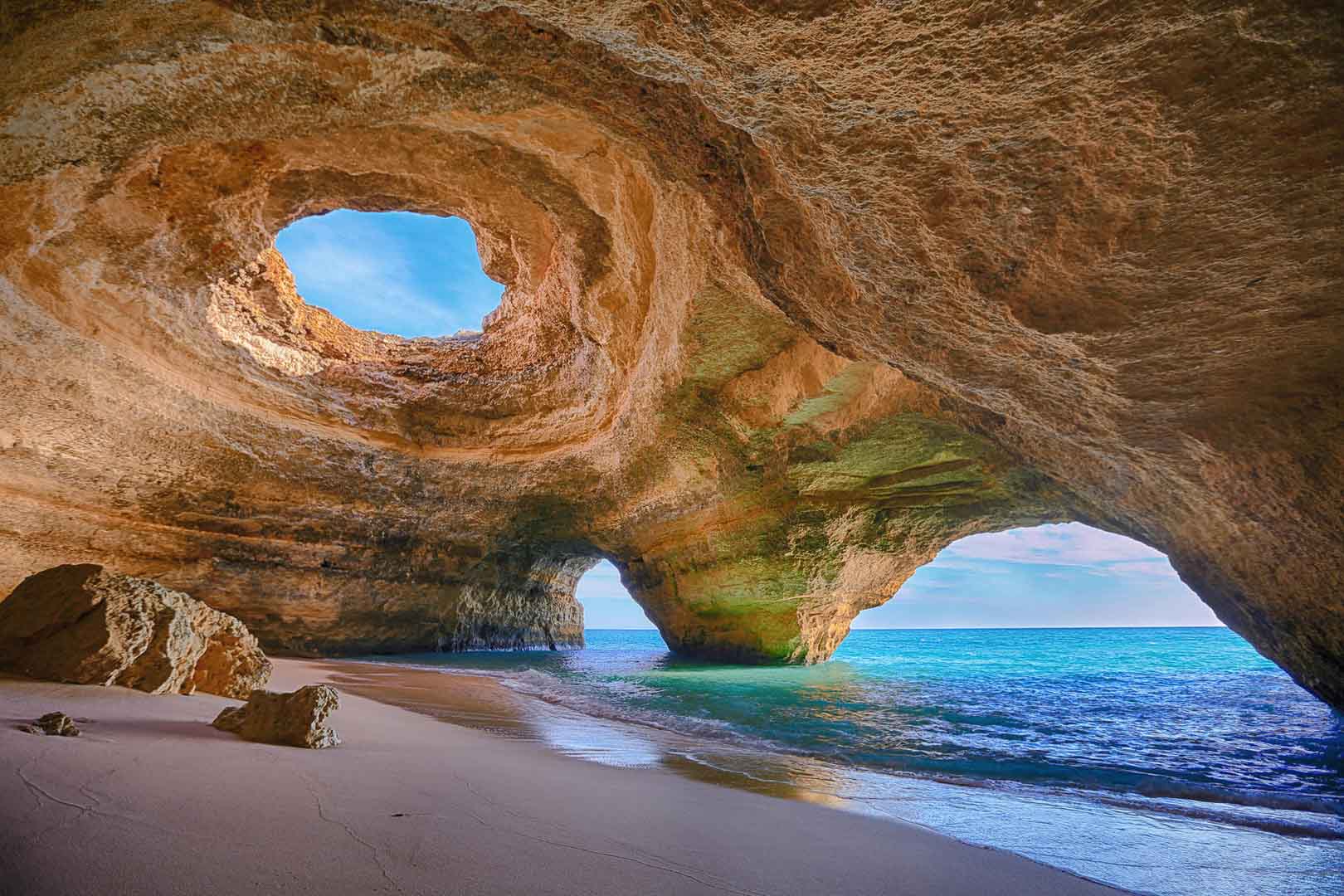
The Benagil Cave looks impressive from above, but it looks even more impressive from down below. You can reach the inside of the cave only by sea, whether you swim to it or use any other floating device (boat, stand-up paddle, kayak, …).
It’s usually called a secret beach, but it’s not so secret now. Benagil Caves still remain fantastic, and I would totally recommend visiting.
Read more : Complete Guide to Visit Benagil Cave
4. Ponta da Piedade
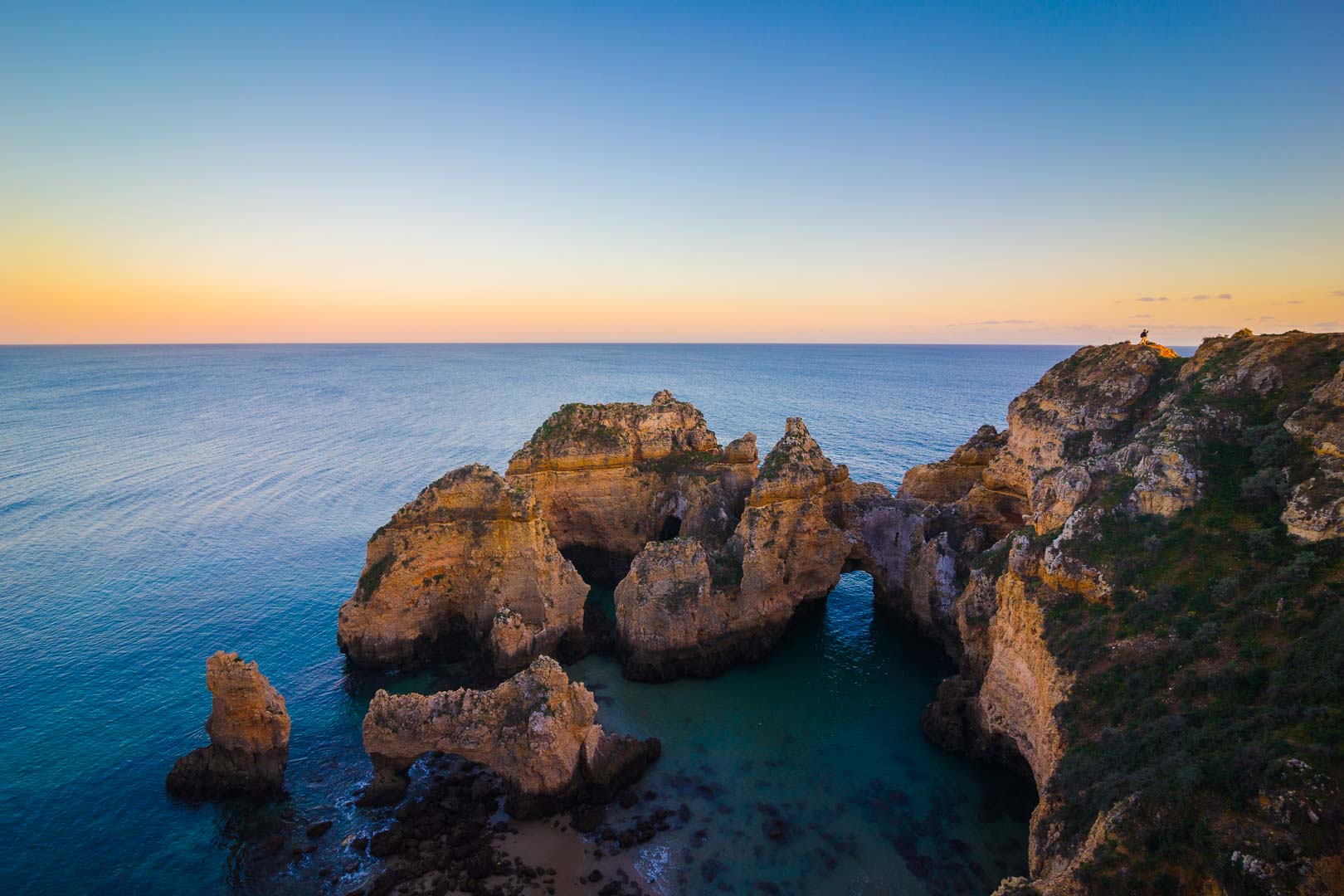
In Ponta da Piedade, you’ll find epic rock formations like the ones you can see in the picture above (did you spot the tiny person? Yeah that’s how massive this place really is!). You’ll also find nice caves that you can explore by foot at low tide.
Read more : Guide to Discover Ponta da Piedade
5. Camilo Beach
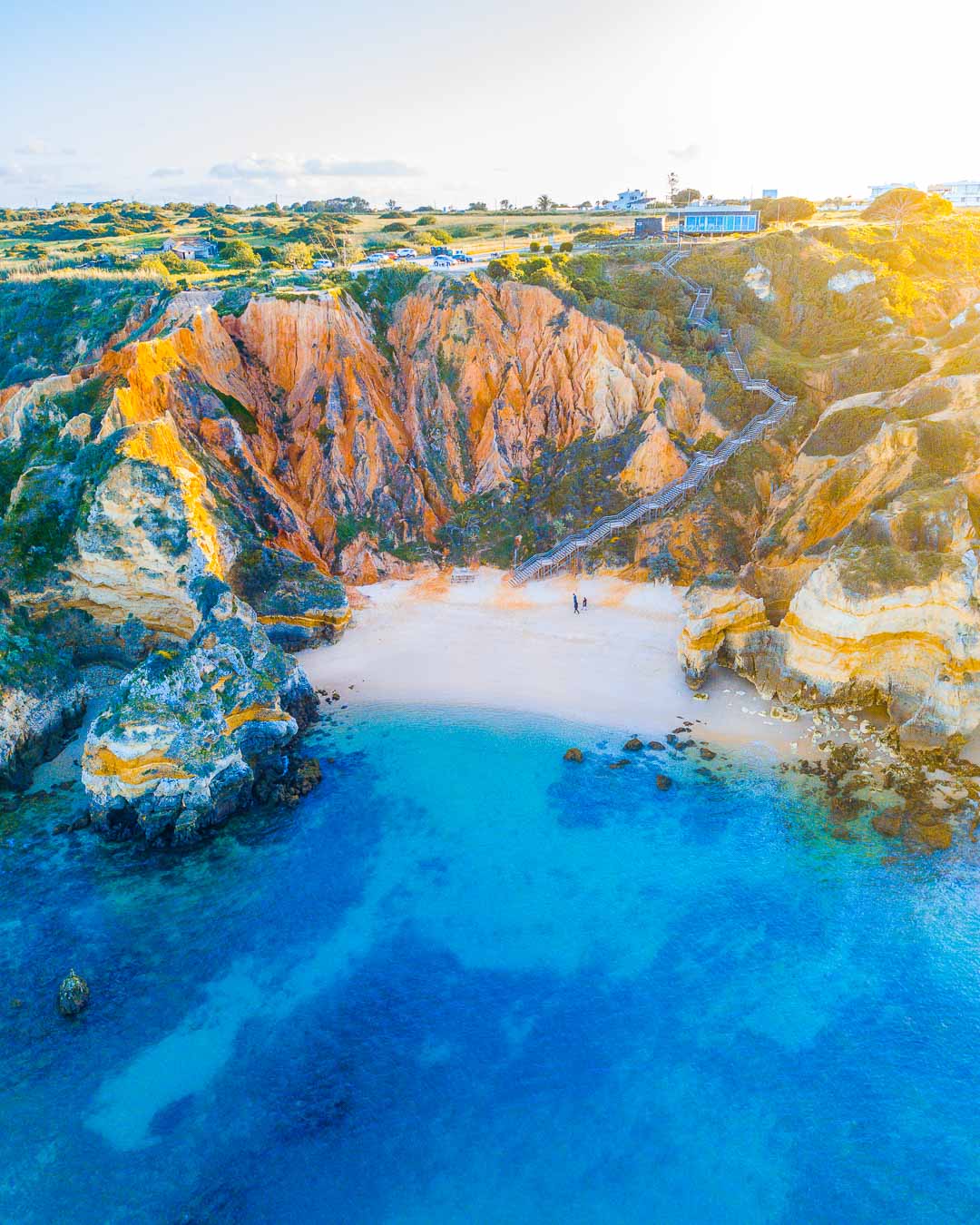
Camilo Beach, or Praia da Camilo, is one of the most unusual beaches in Algarve. It’s hidden from plain sight by big cliffs. You have to climb down 225 steps to get all the way down to the beach, and that’s what makes its charm. Down on Camilo Beach, you’ll feel isolated from the world.
Read more : Guide to Discover Praia do Camilo
6. Student Beach
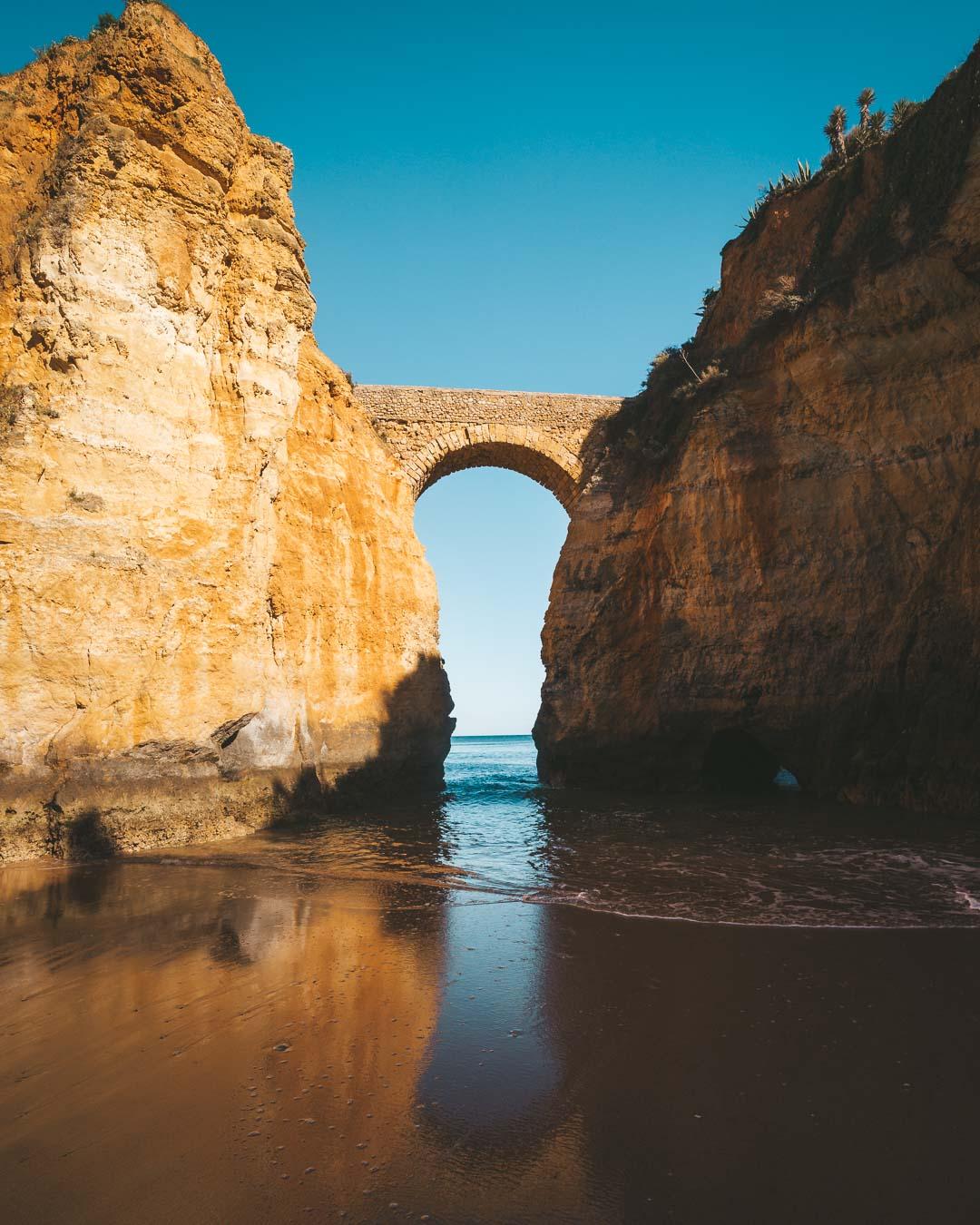
Let’s start with the obvious: there is a badass stone bridge above the beach. That’s pretty cool in itself if you ask me! In addition to that, you also access the beach through a tunnel in the cliffs. The two together make Praia dos Estudantes the perfect beach to soothe your need for unusual places.
7. Tres Irmaos Beach
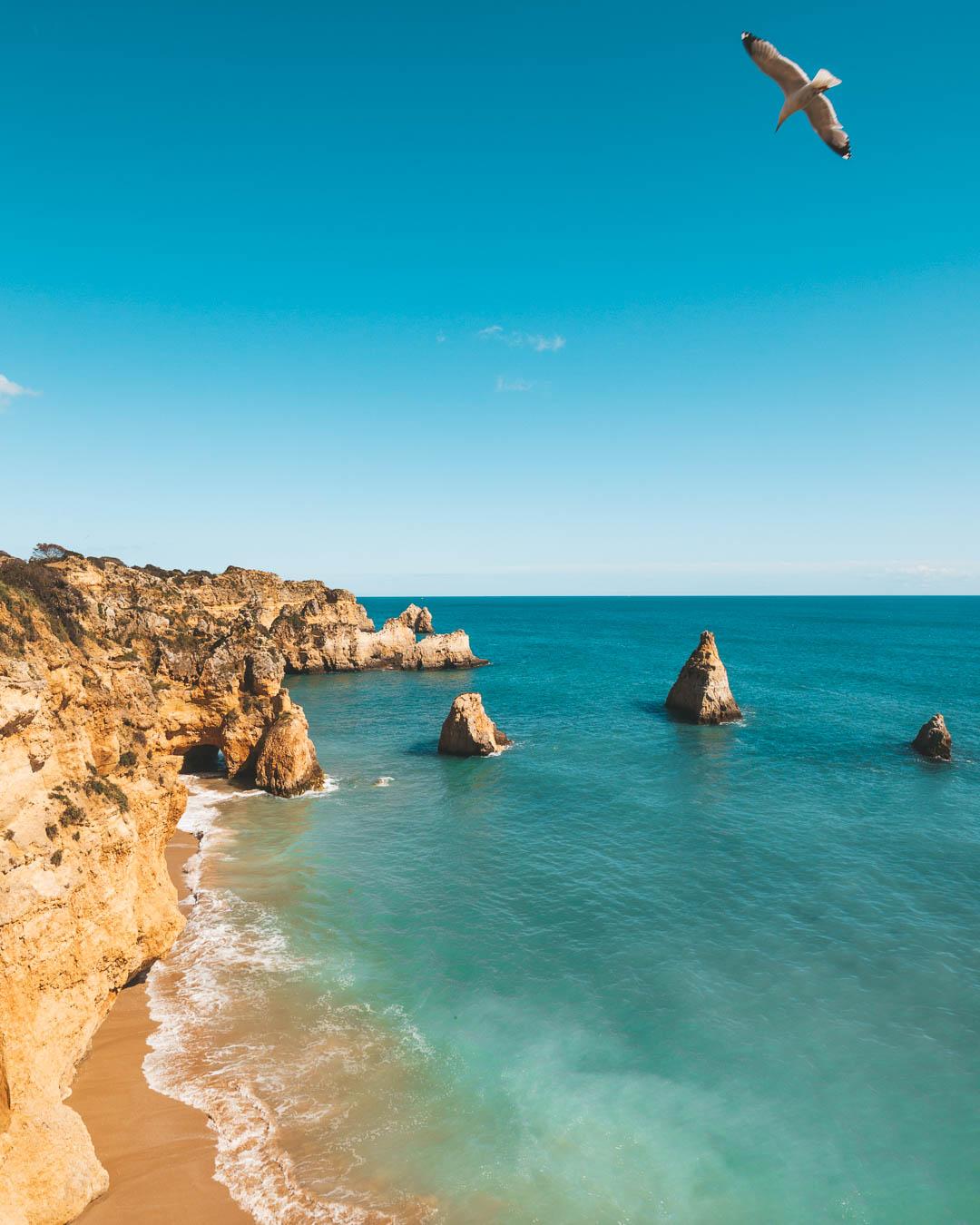
There is also a nice cave on the beach that you can see on the left side of the picture above. You can walk through it, and access another beach!
8. Praia de Albandeira
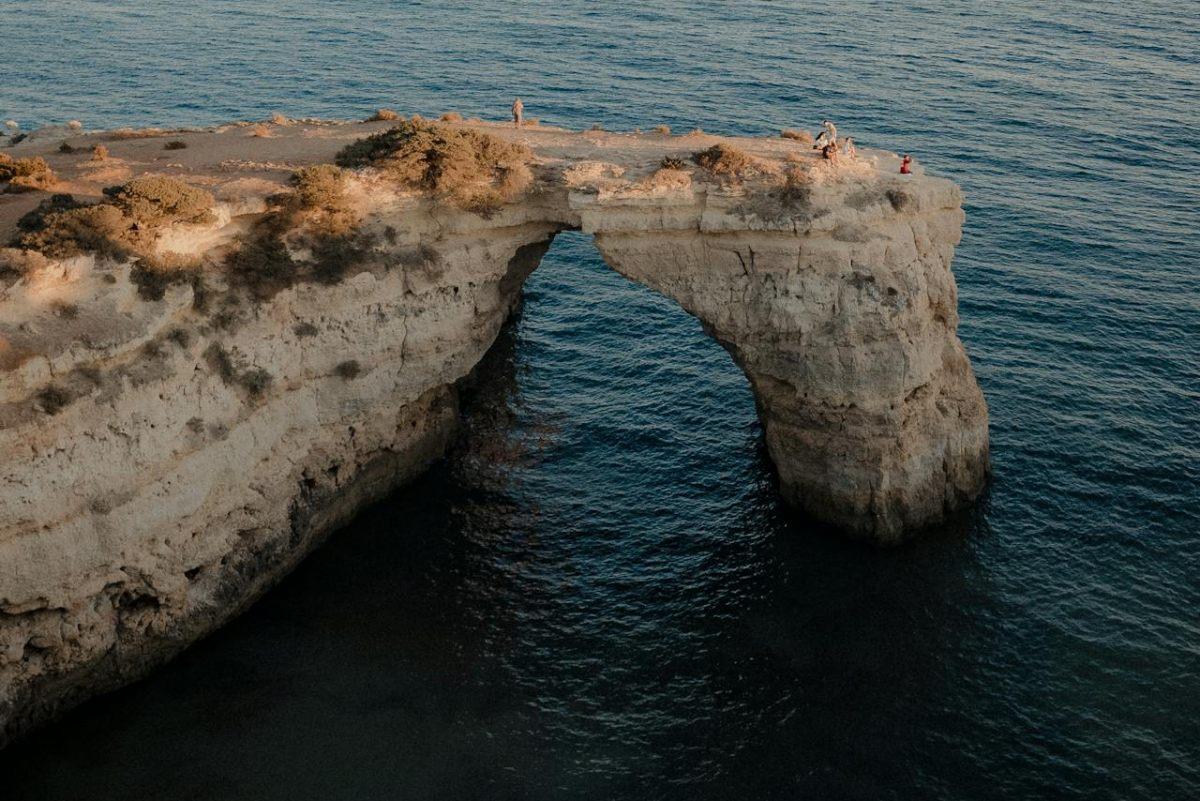
Albandeira Beach is another cool rock formation on the Algarve coast of Portugal.
This natural arch over the sea makes Praia de Albandeira a really cool beach to visit, even if only for the view. In addition to this rock formation, you will also find a nice sand beach and a cave.
Read more: Complete Guide to Visit Albandeira Beach
9. Praia do Vau
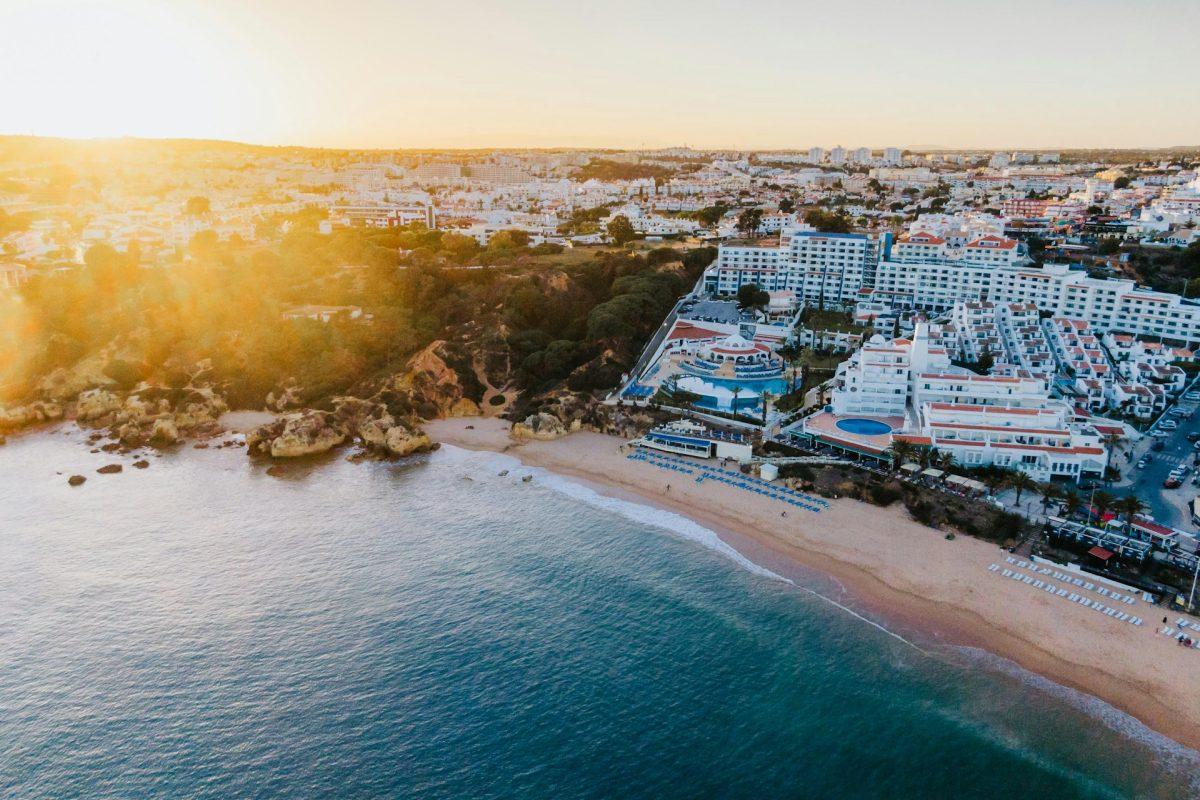
I mean, just looking at the turquoise water… makes me want to jump right in!
And if you want to make sure you won’t walk too long to reach the beach, make sure to book one of these hotels on the beach .
10. Ria Formosa
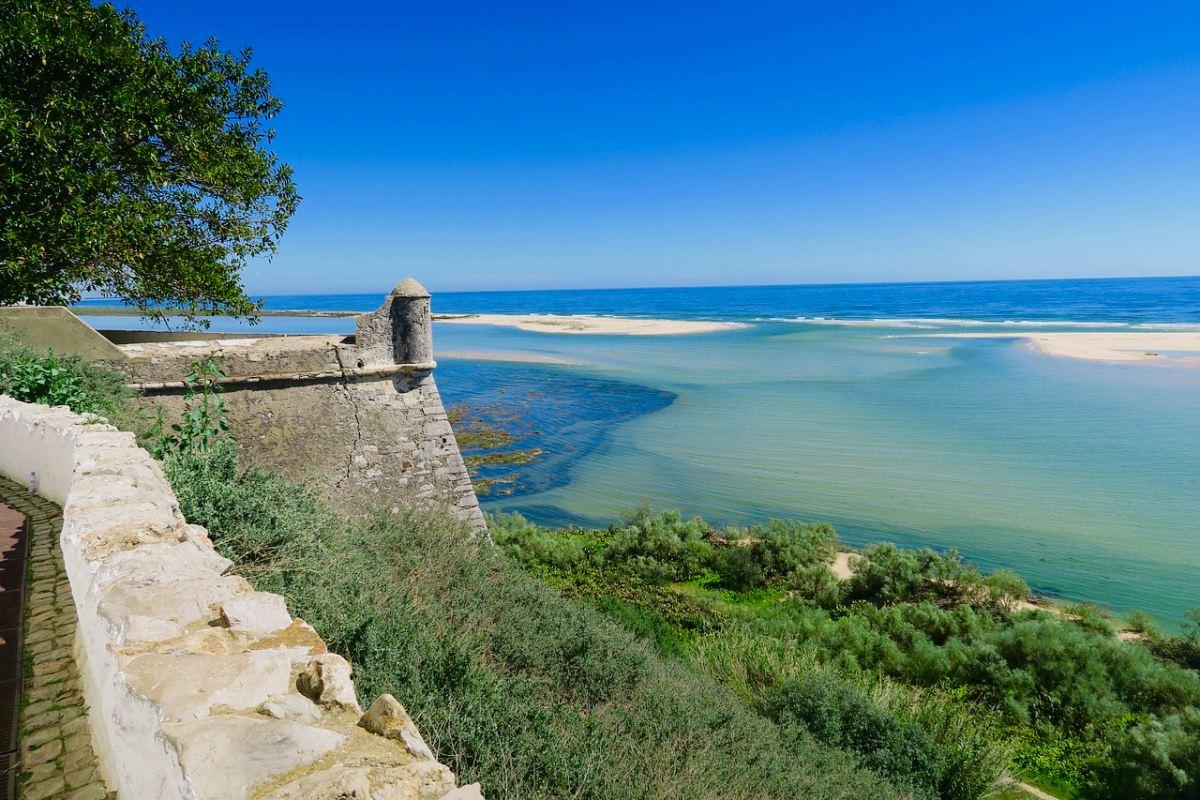
I don’t have any pictures from this location, but a quick Google image search will blow you away: click here to see all the images from Ria Formosa.
11. Praia de Odeceixe Mar
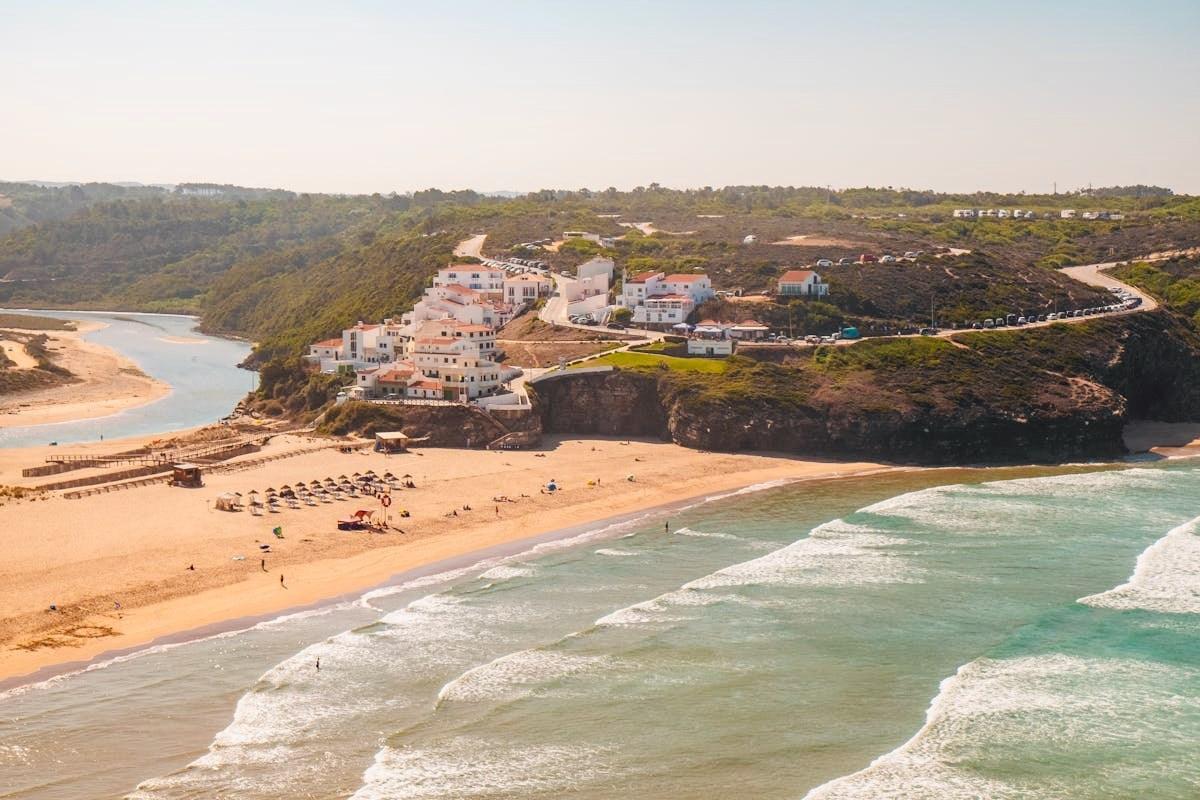
Even if there seems to be no one on the beach in the photo above, the location can get pretty crowded during high season, and it’s easy to understand why. Nonetheless, Praia de Odeceixe is a must-visit in the Algarve!
12. Praia da Amoreira
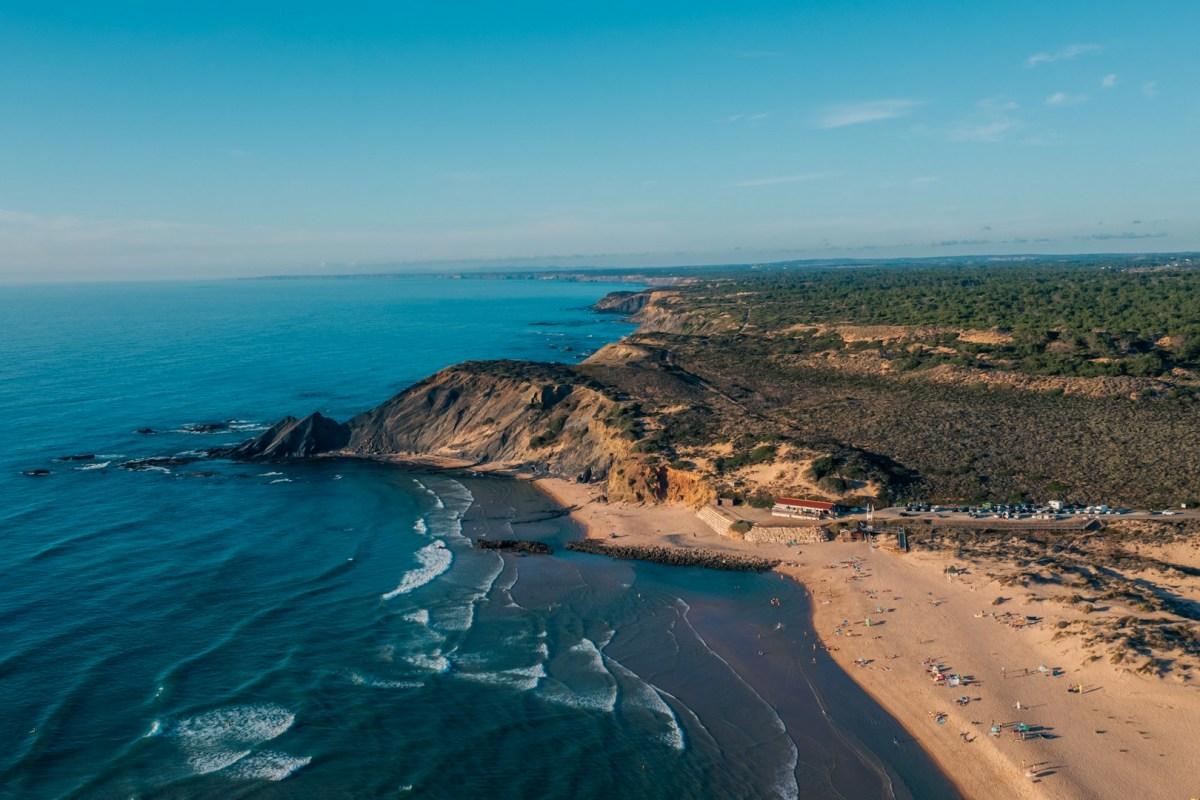
This beach looks absolutely fantastic, and I will definitely visit the next time I’m in the Algarve!
13. Monte Clérigo Beach
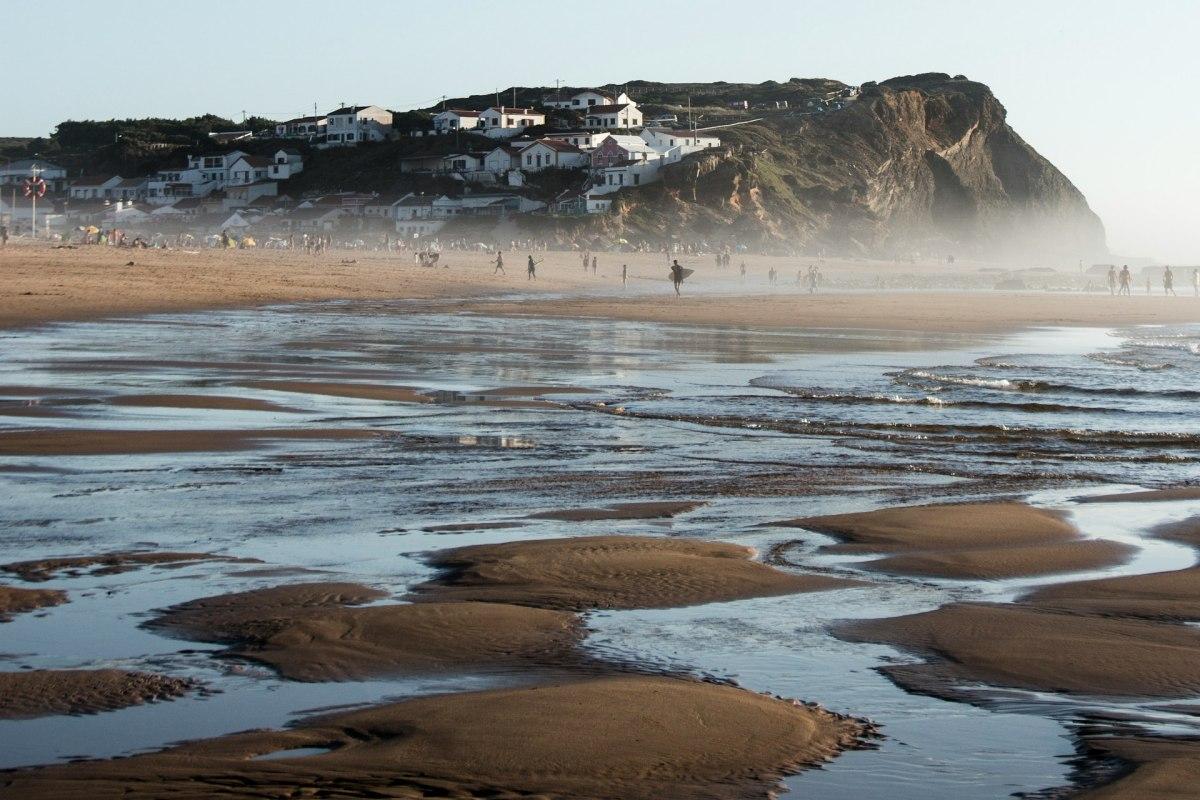
The little village of Monte Clérigo is made of red & white houses, family-owned for more than 80 years. It’s in danger of demolition so visit while you can!
14. Arrifana Beach
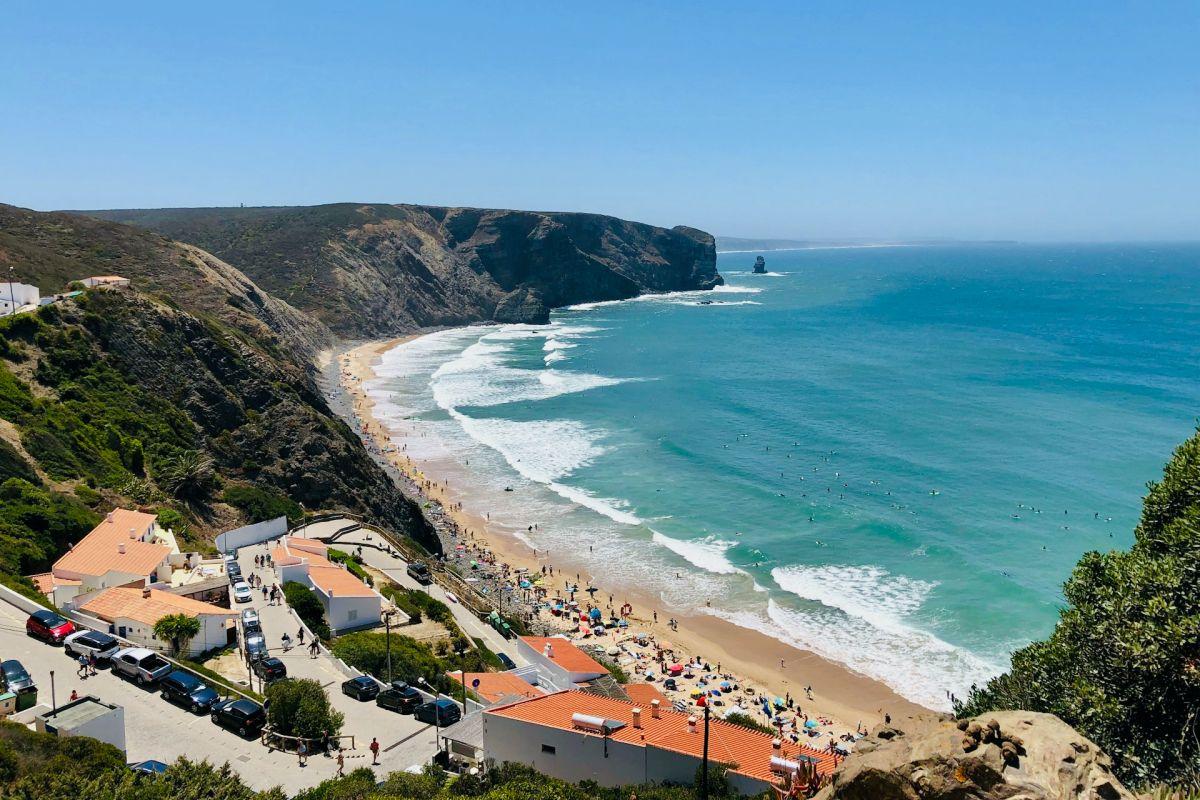
If you’re looking for epic views, you’ll get one from the top of the cliffs, or from the top of Arrifana fortress.
15. Praia do Amado
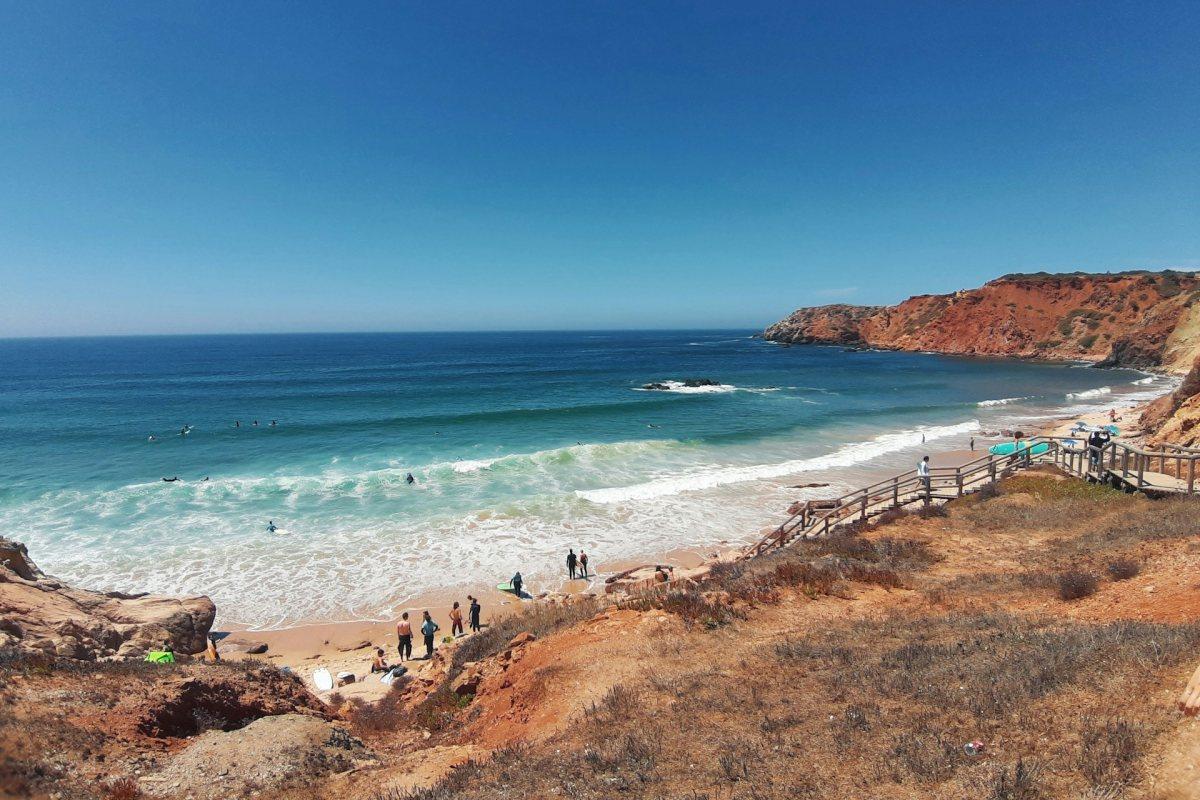
Praia do Amado is regarded as one of the best beaches for surfing in Portugal. If you don’t feel like surfing, you can still go to the beach to watch other surfers, try to photograph them, or simply enjoy the view from one of the viewpoints in the area.
16. Cape Saint Vincent
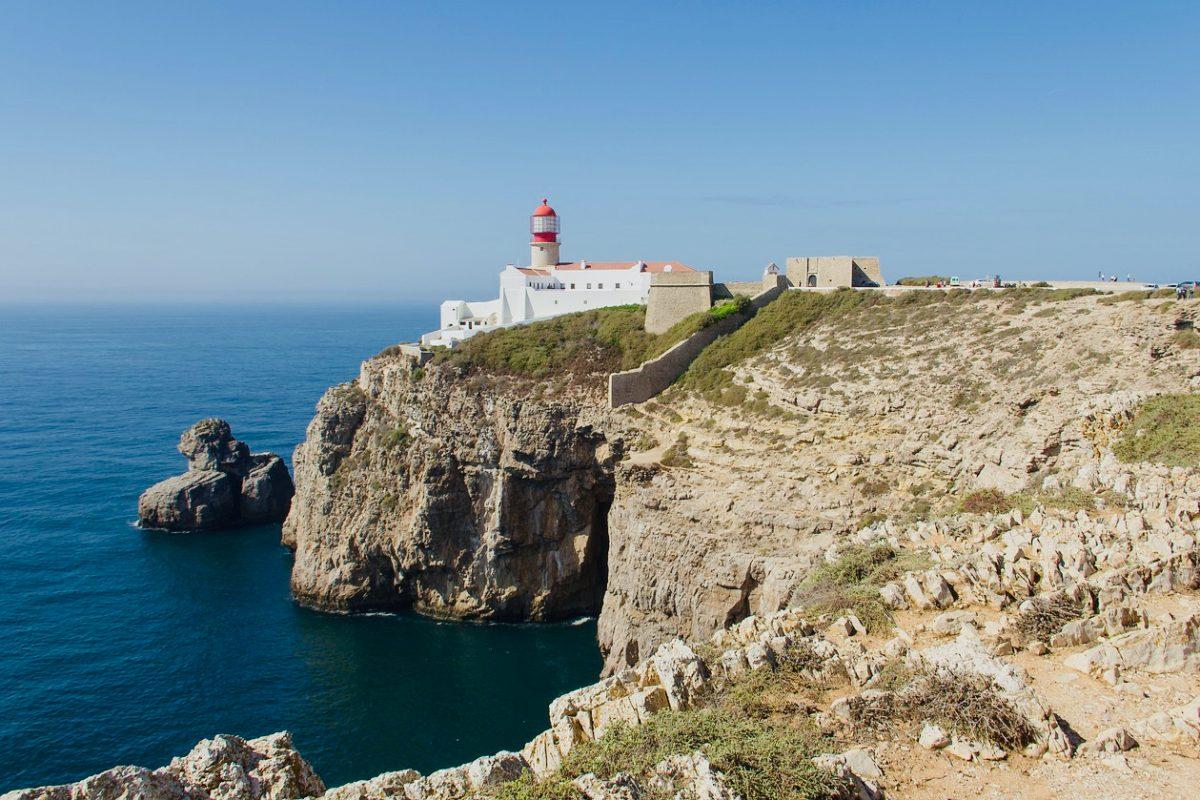
Cape Saint Vincent, or Cabo de Sao Vicente, is the southwesternmost point of Europe. There is a beautiful lighthouse on the edge of the cliffs that makes for a wonderful view, especially at sunset.
Next to the lighthouse, there is a food truck named “Last Sausage before America” which I find funny enough to be mentioned here. Let me know if you end up eating there!
17. Beliche Beach
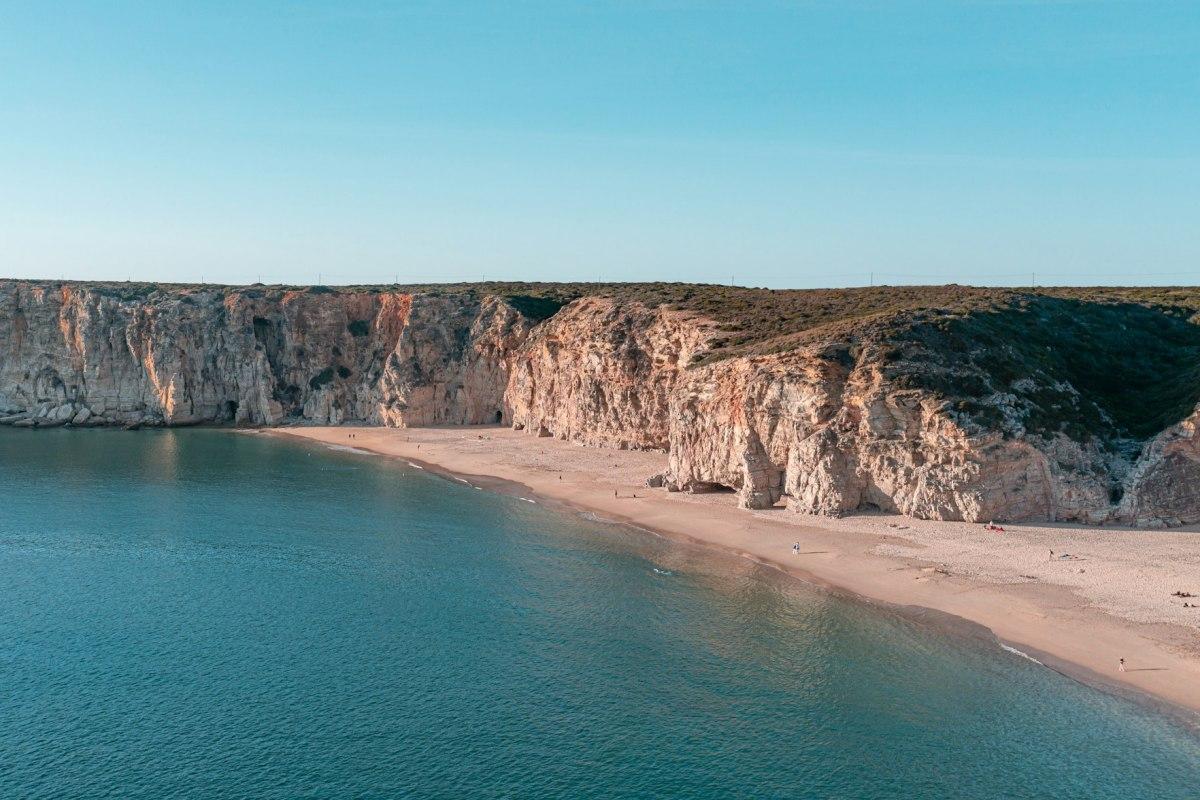
Praia do Beliche is isolated from the winds by high cliffs. It’s also far enough from the main spots, so fewer tourists visit this beach. You should find some peace on this beach (except during the peak season, of course).
18. Fortaleza de Sagres
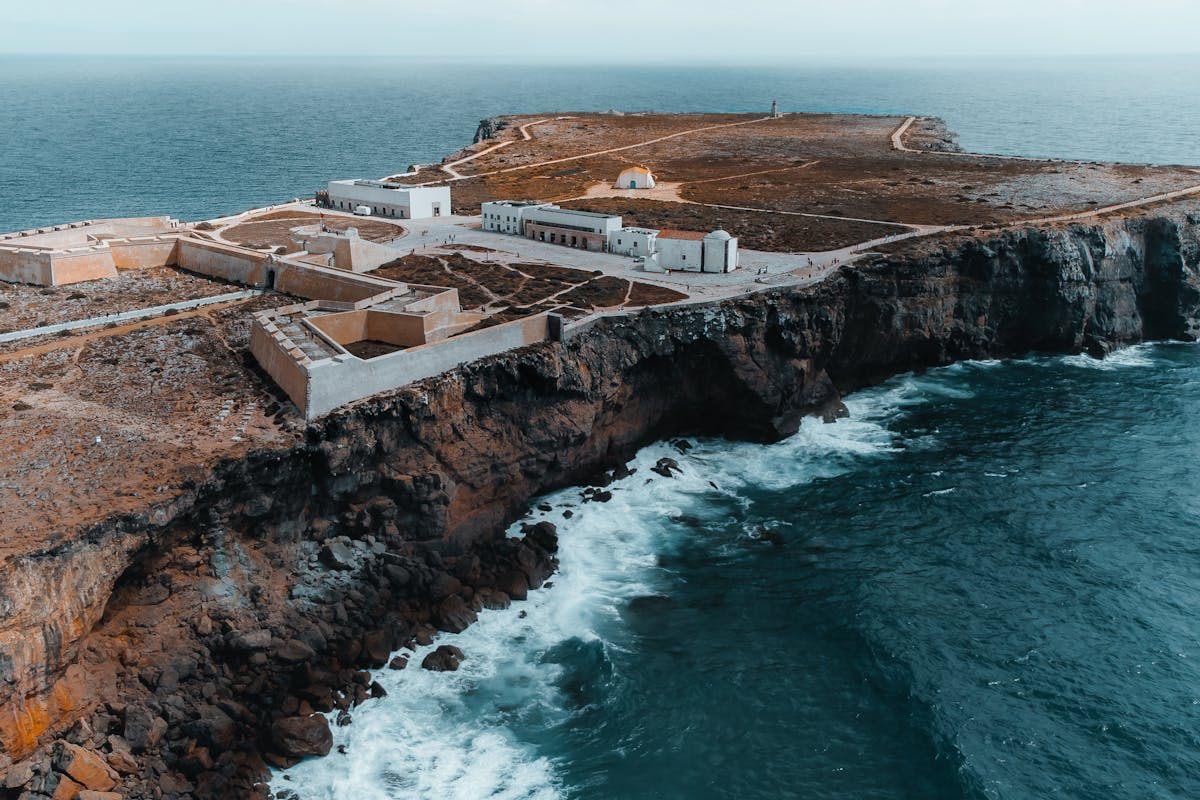
In addition to visiting the Fortaleza de Sagres, you can also explore the area, go check out Praia do Tonel or enjoy the view over at Cape Sagres viewpoint.
19. Praia Dona Ana
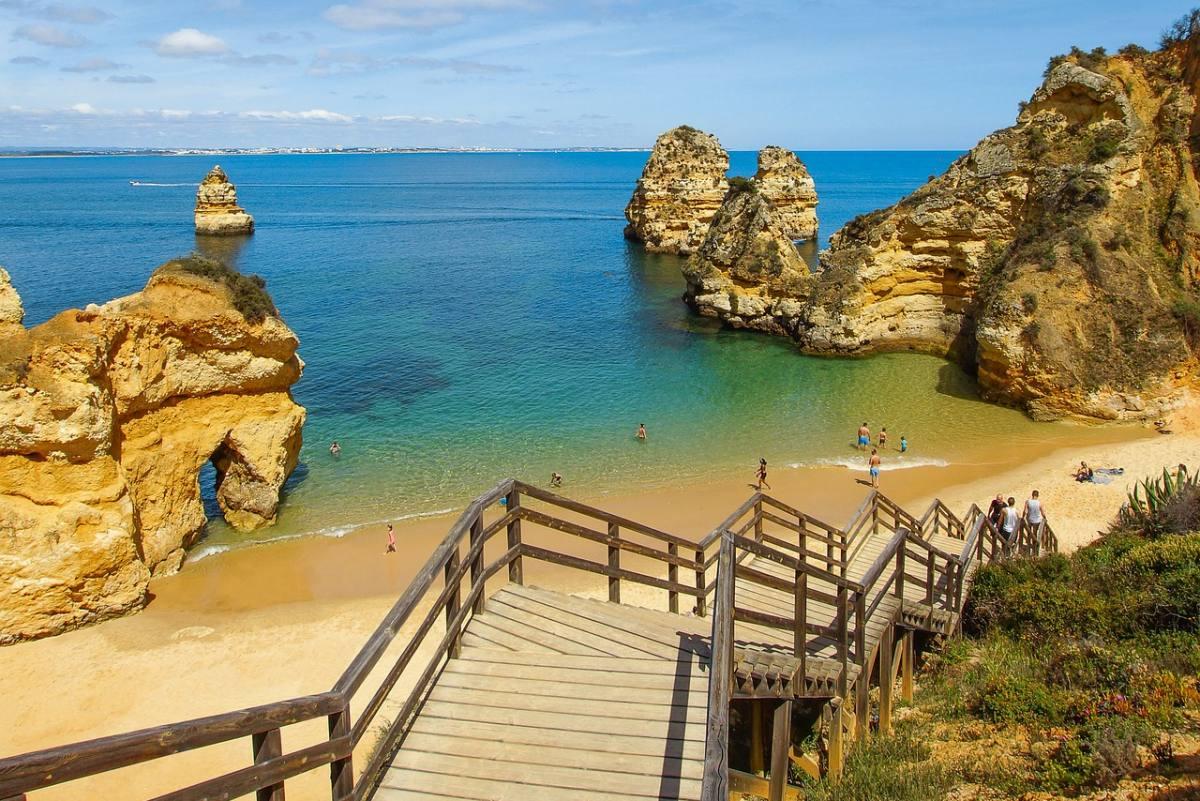
The beach is only a 30 minutes walk from Lagos. The sand is a golden color, the water is as clear as it gets, and the cliffs shelter the beach from the wind. Praia Dona Ana is one of the best beaches in Algarve to relax and swim; the only downside is that it gets pretty crowded during summer .
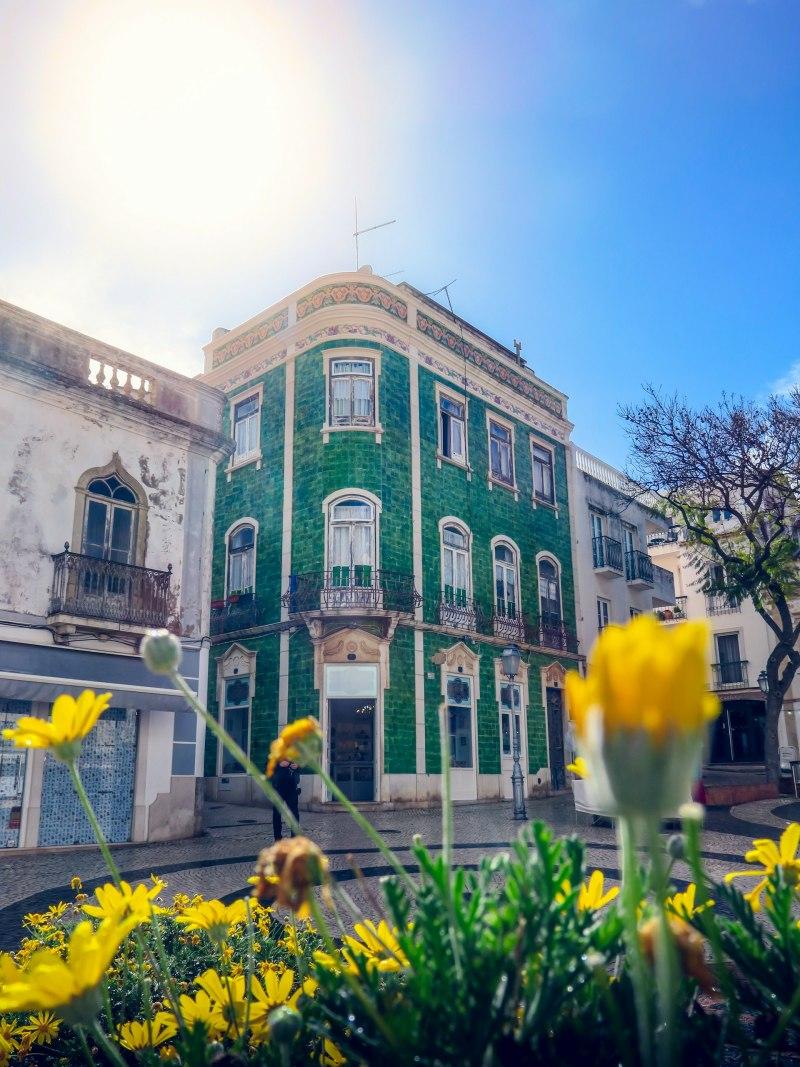
Lagos, situated not far from Portimão, is a must-see destination in the Algarve. Boasting a quaint and charming historic center, as well as stunning rocky beaches, it offers an unforgettable experience.
If you have a car, make sure to hit up the top spots like Ponta do Piedade, Praia Dona Ana, Praia do Camilo (mentioned earlier), Praia da Balança, Cao Raivoso and Praia dos Pinheiros. Trust me, these beaches are the real deal and totally worth checking out.
Lagos deserves a whole day of your time. Picture this: charming streets paved with those classic Portuguese mosaics, a charming fortress right by the ocean, and relaxing strolls leading from the sea to the marina.
See 19 more best cities to visit in Portugal
21. Portimão
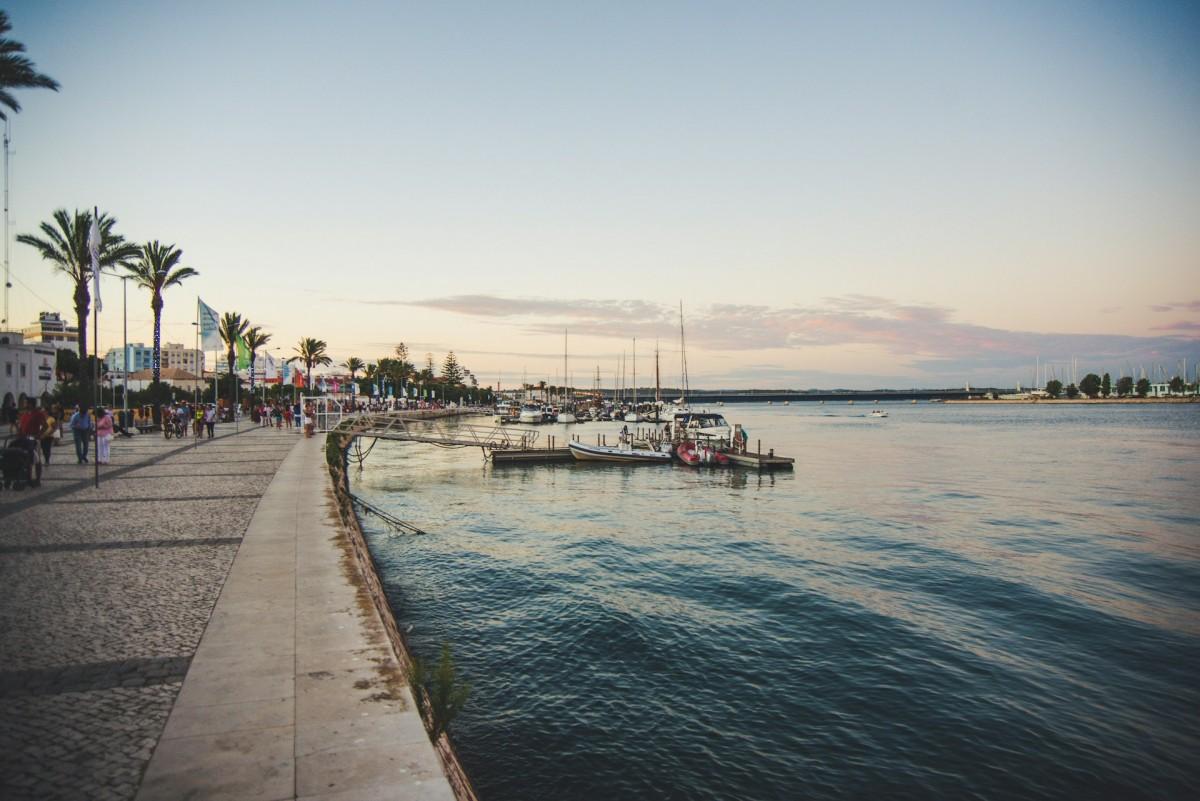
The city was once the region’s main fishing center and famous for its canning factories. But it has gradually developed as a tourist destination, largely thanks to the fantastic Praia da Rocha and its marina.
It’s also a best place to go in Algarve for nightlife. In the evening, the waterfront turns into a party with seafood restaurants and bars adding to the good vibes.
22. Meia Beach
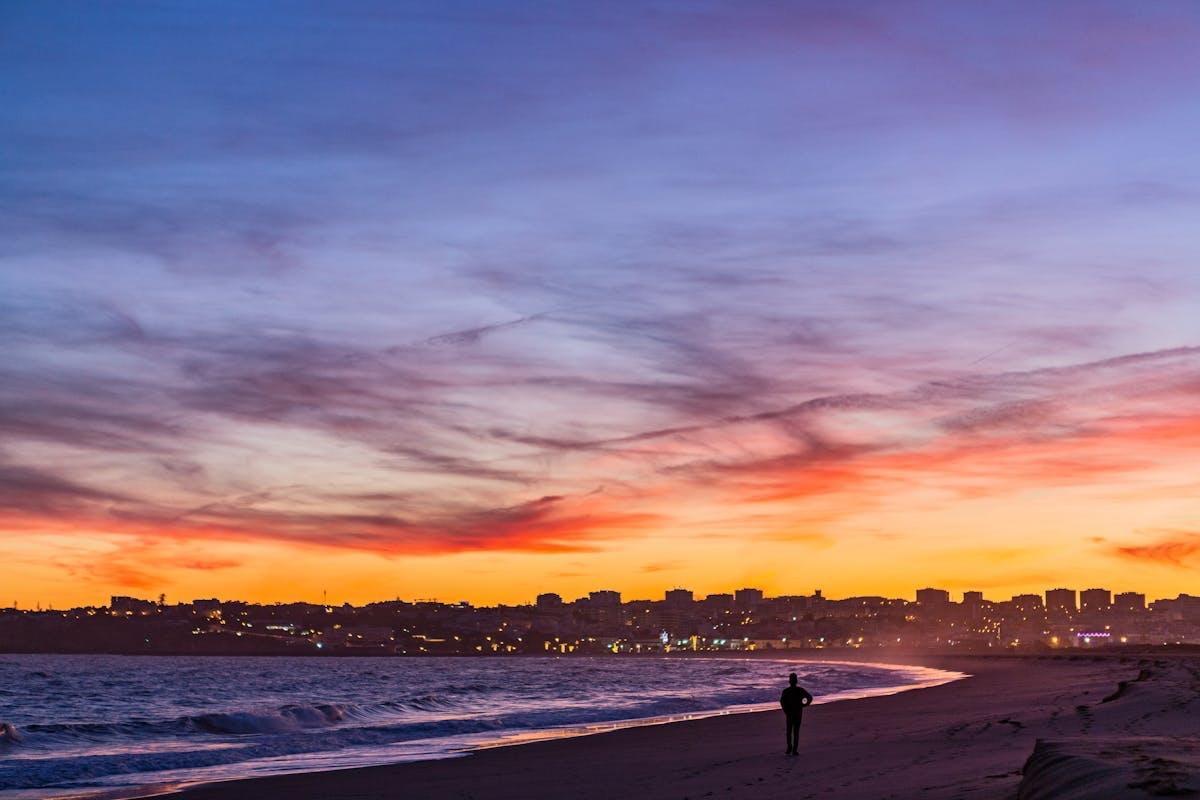
Are you looking for a beach with extra room, without a crowd of people right around you? Chances are that you might find a spot for yourself on this 4 kilometers (2.5 miles) long beach.
23. Carvoeiro
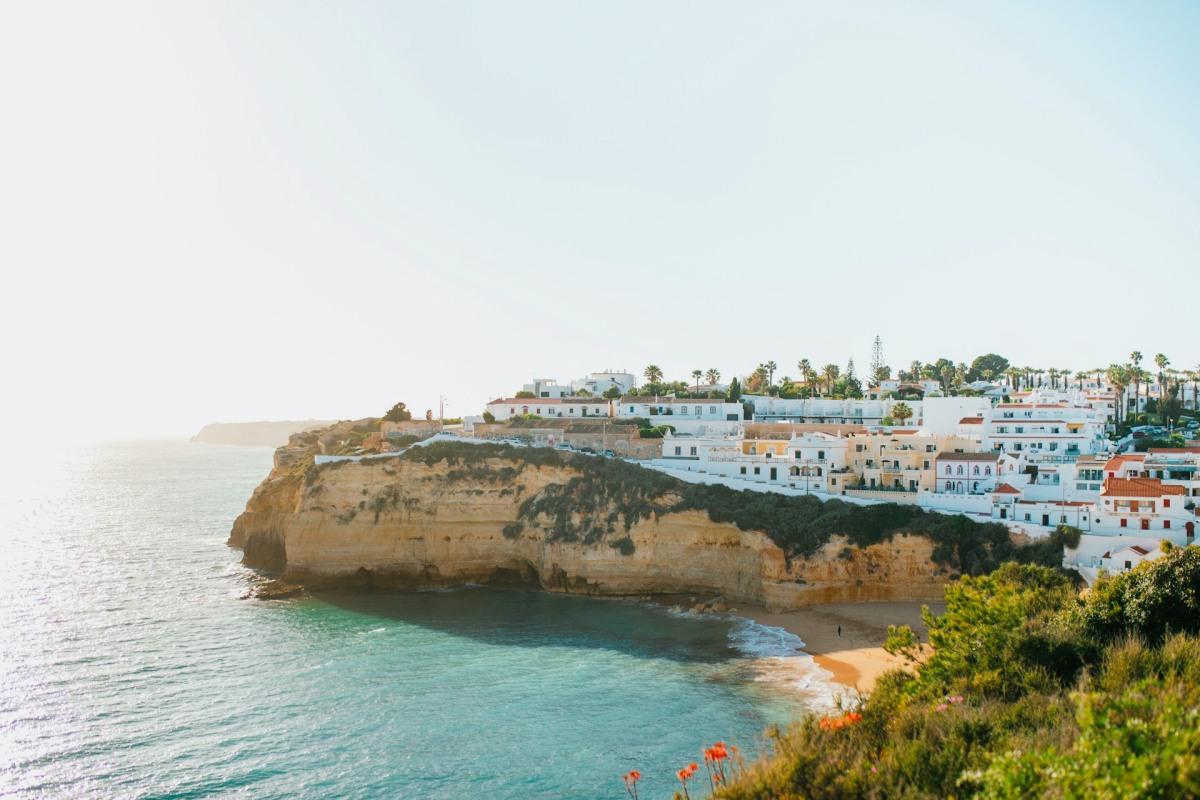
On top of the beauty of its beach, you can explore the Nossa Senhora da Encarnaco Fort, located on top of the cliff: it’s the white building on the edge of the cliff in the image above. The original fort was mainly destroyed by an earthquake in 1755, but you can still visit the fort that was rebuilt in 1825.
24. Algar Seco Caves
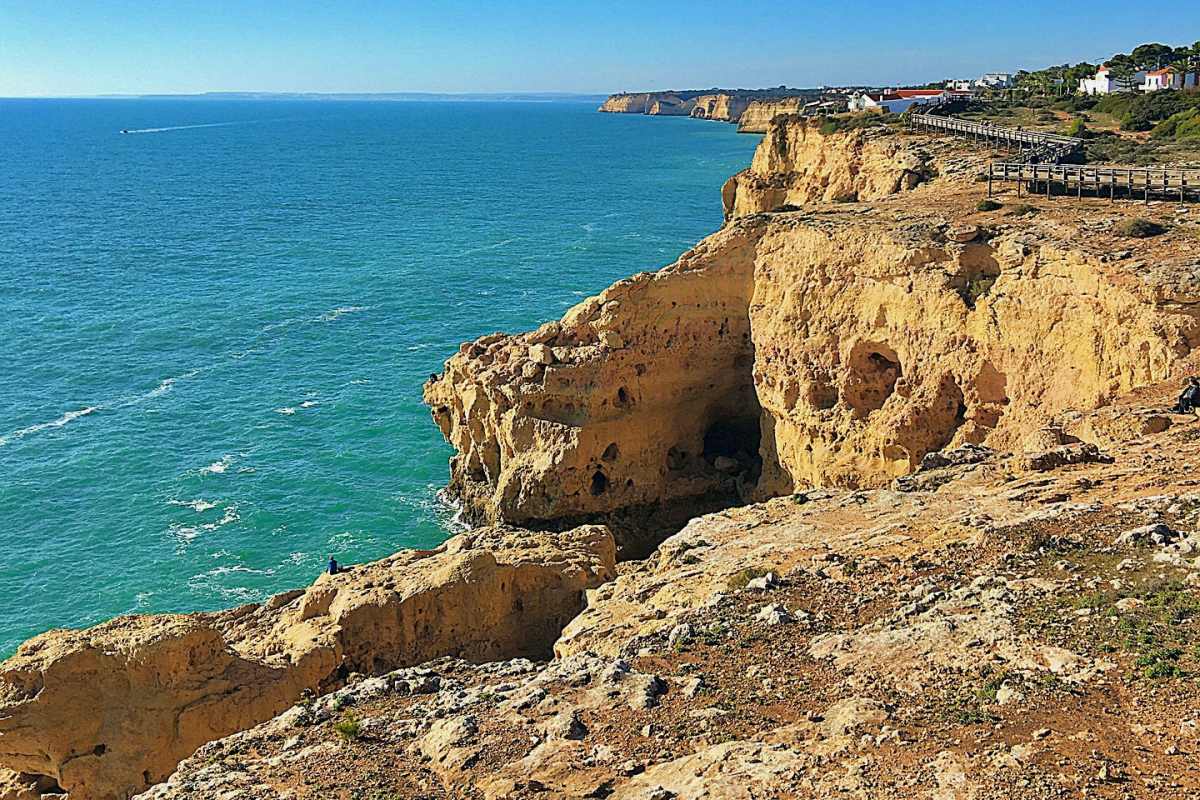
In Algar Seco, you’ll find crazy rock formations, and the most famous location in the area, the A Boneca cave (pictured above). Through the cave, you’ll end up with this view over the blue water.
25. Fort of Nossa Senhora da Rocha
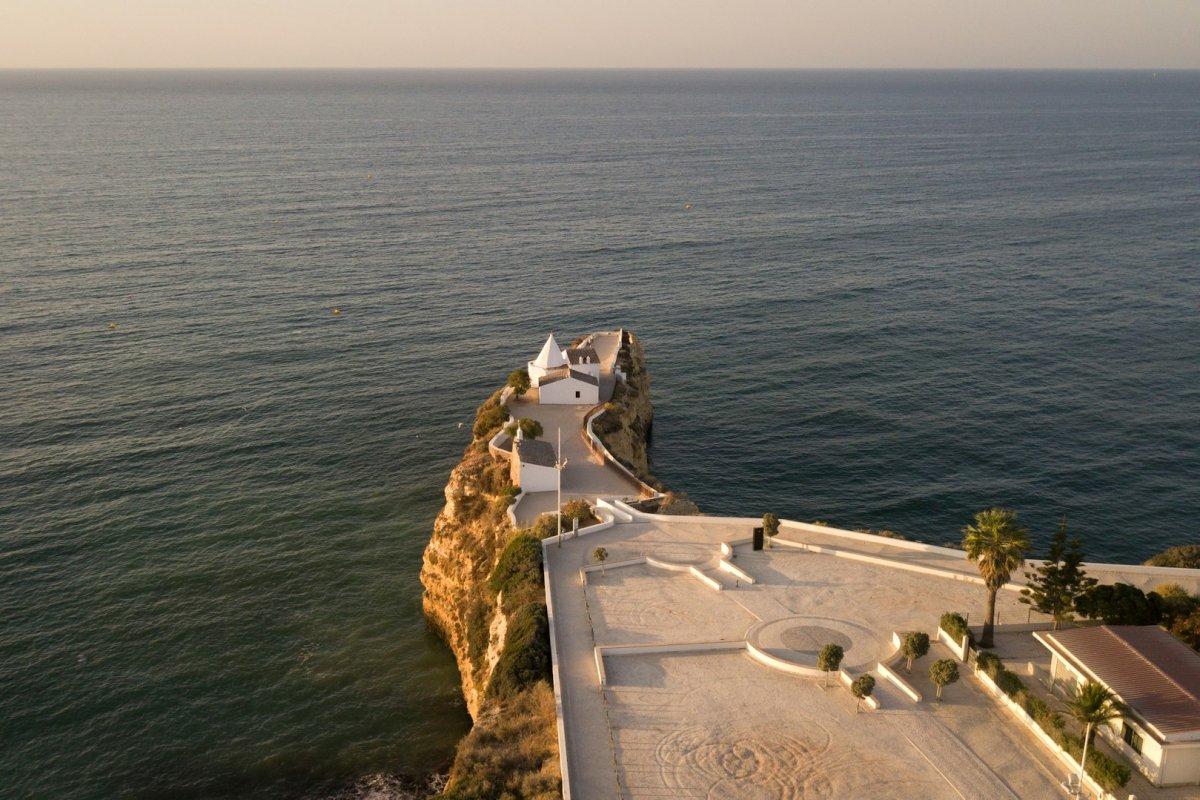
The Chapel was a point of pilgrimage back in the days. In the 13th century, a fort was built around the Chapel to protect the heritage site.
26. The Red Cliffs of Praia da Falésia
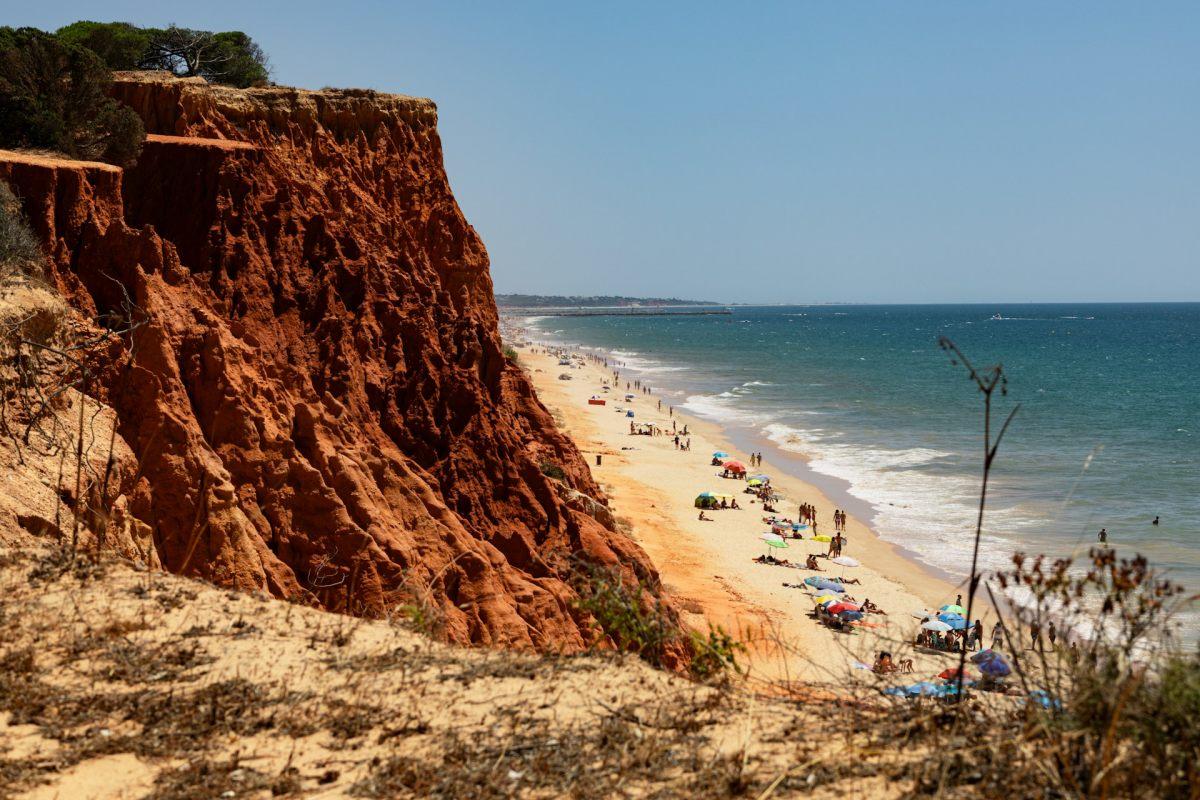
Praia da Falésia is ranked as the best beach in Portugal, 3rd best beach in Europe, and the 6th best beach in the world in 2023 according to TripAdvisor .
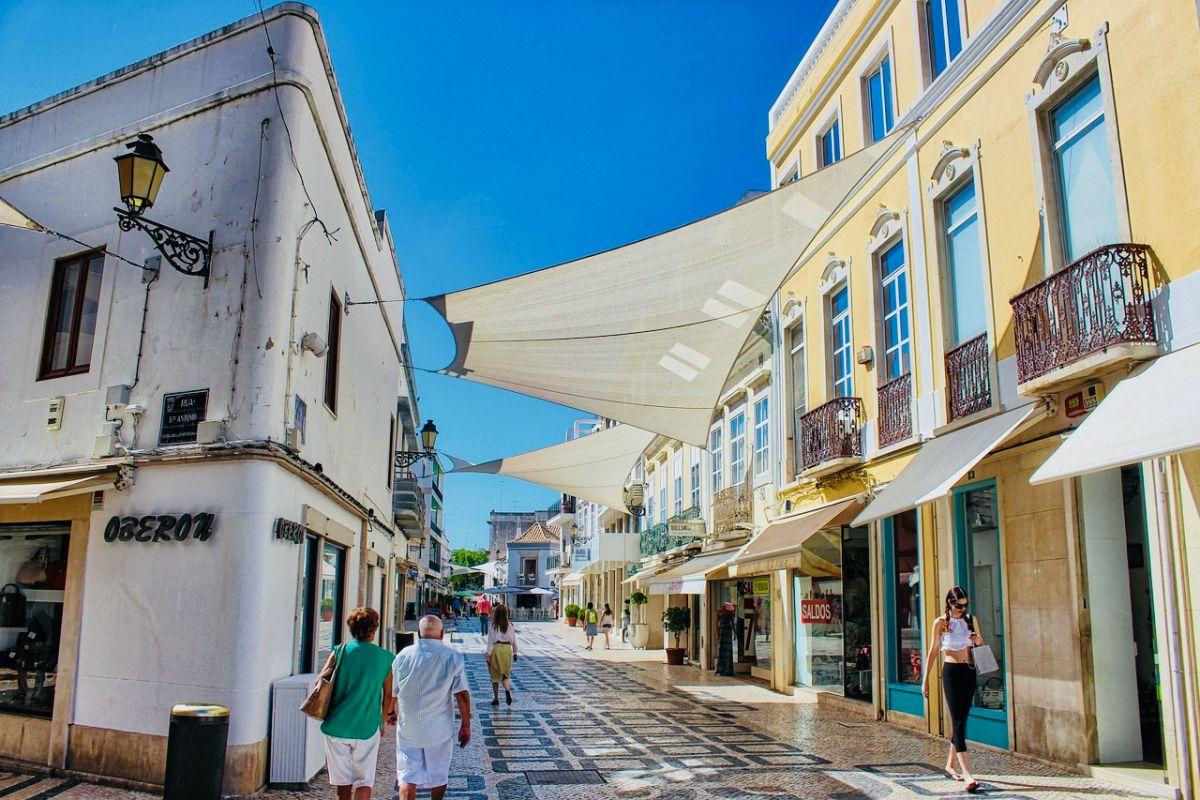
It boasts a lovely marina, parks, pretty squares, and a historic old town full of pedestrian lanes and terraces. Make sure to check out cool spots like the Igreja do Carmo and the Chapel of Bones – they’re total must-sees!
When the sun goes down, the city comes alive with a vibrant vibe, perfect for those seeking to party all night long.
28. Palace of Estoi
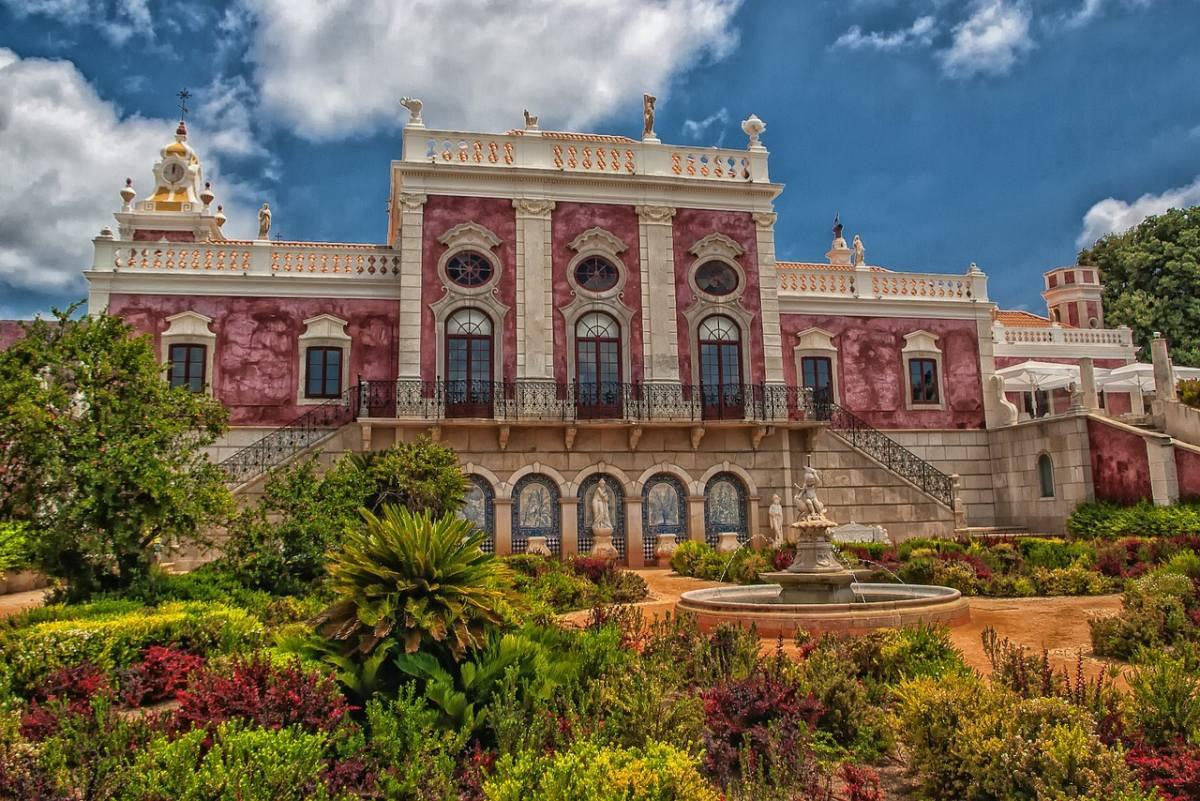
The palace and its gardens are renowned for their ornate decorations, including azulejos (Portuguese-painted tiles), stuccos, statues, fountains, and charming walkways.
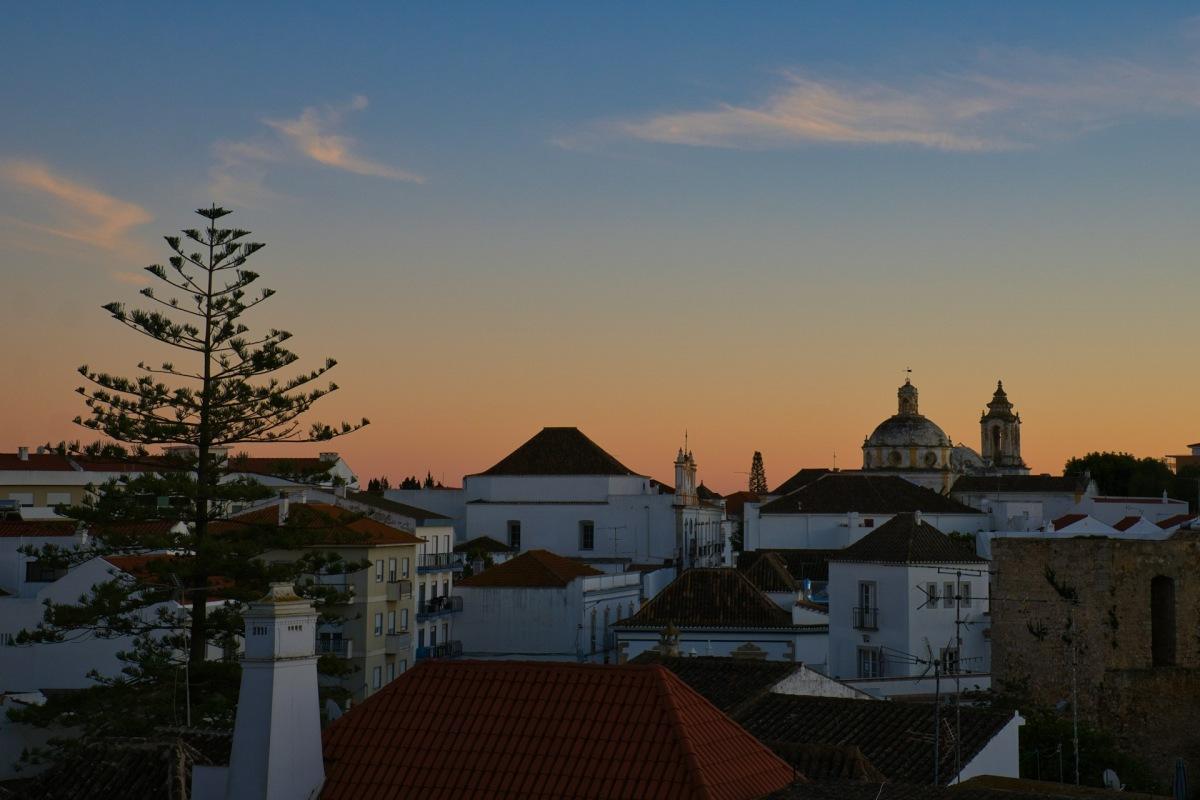
With its rich architecture reflecting its Arab heritage, the Gilão River flowing through town into the Ria Formosa, its historic buildings, and pretty cobbled streets, Tavira is indeed a charming town well worth a visit. Plus, you’ll soak in that real Portuguese culture without the tourist hustle.
Don’t skip out on checking the church of Santa Maria do Castelo, exploring the Castelo de Tavira ruins, and crossing that Roman Bridge.
30. Albufeira
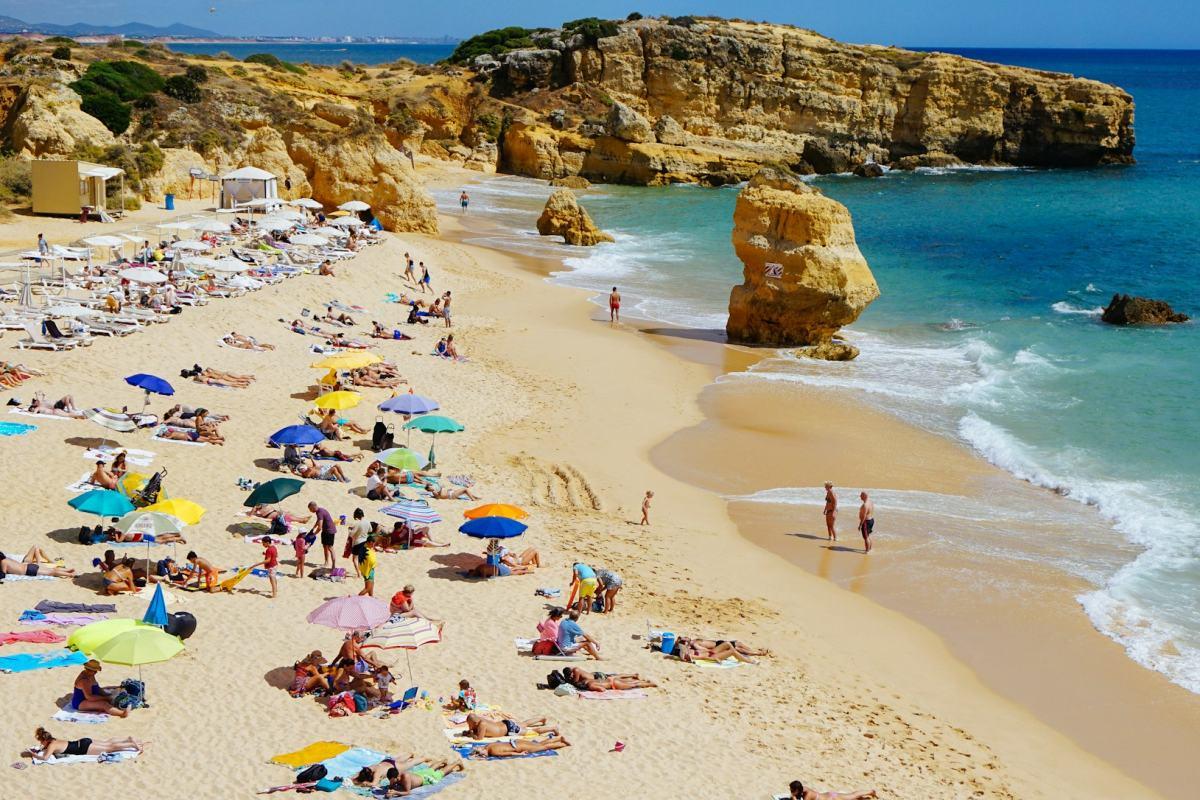
In Albufeira’s old town, dive into seafood restaurants dishing out Portuguese specialties , hit up the shops, and get ready to vibe in the bars. It’s the whole package, but you’ll have to put up with the tourists!!
31. Roman Ruins of Milreu
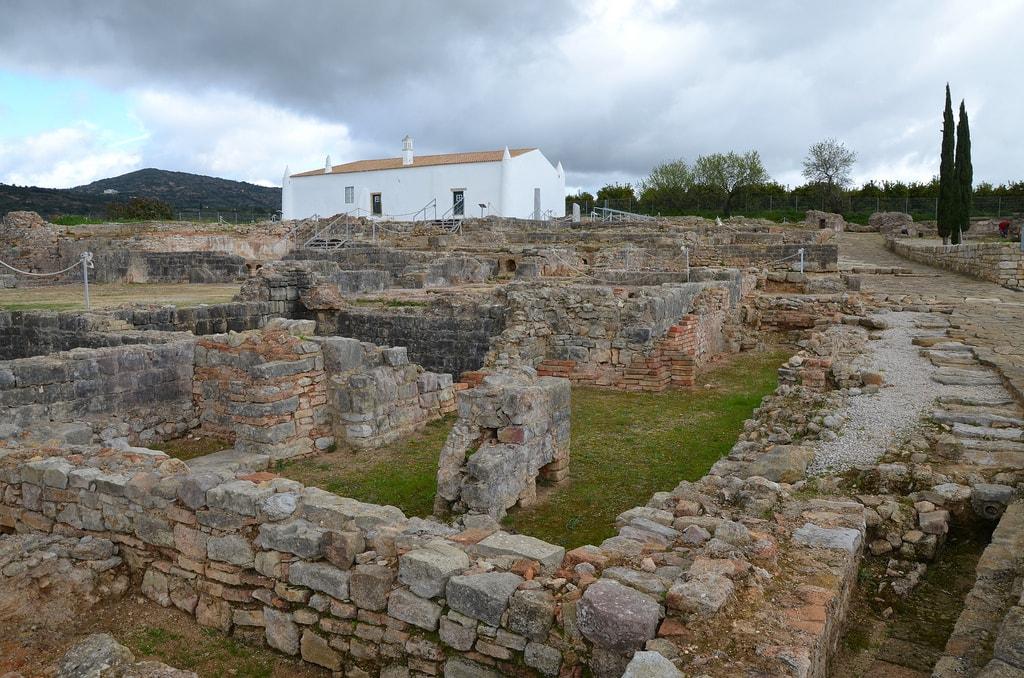
Carole Raddato under CC BY SA 2.0
If you have an interest in history and architecture, you can visit the Roman Ruins of Milreu.
The ruins are what remains of a massive Roman villa, dating from the 1st century.
32. The desert island Ilha da Barreta
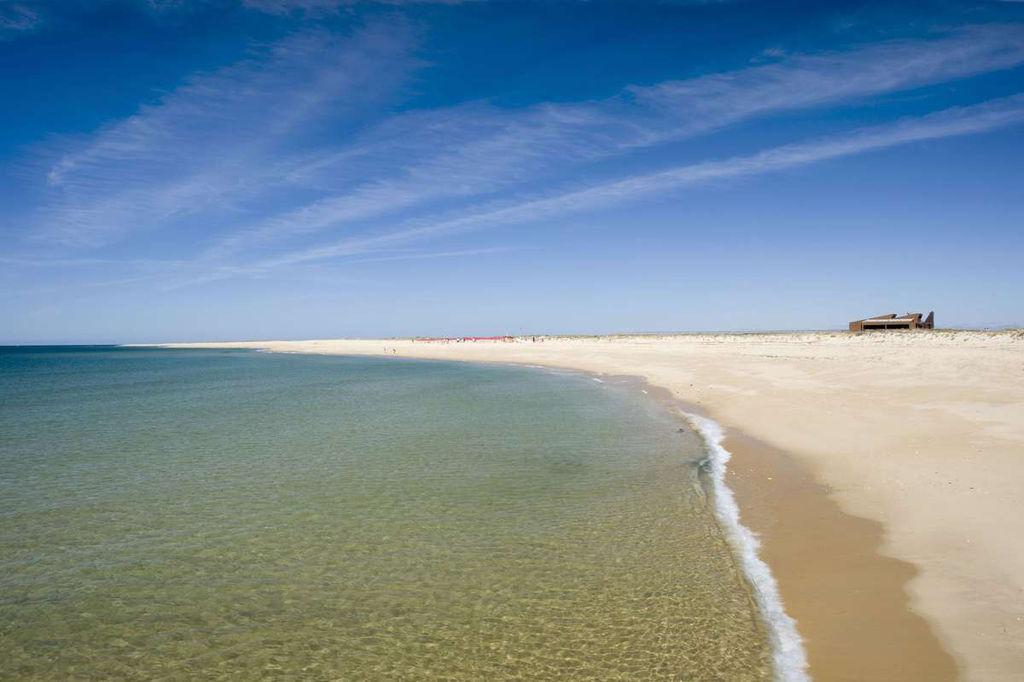
You can reach the island by ferry from Faro, for a small fee of 10€. It takes 35 minutes to reach the island, and departures/returns are at a set time. Make sure to check the times before going:
- Departures : 10am ; 1:15pm ; 4:45pm
- Returns : 12:45pm ; 2:30pm ; 4pm ; 5:30pm
Times changes often so make sure to check the time at the information booth on the spot.
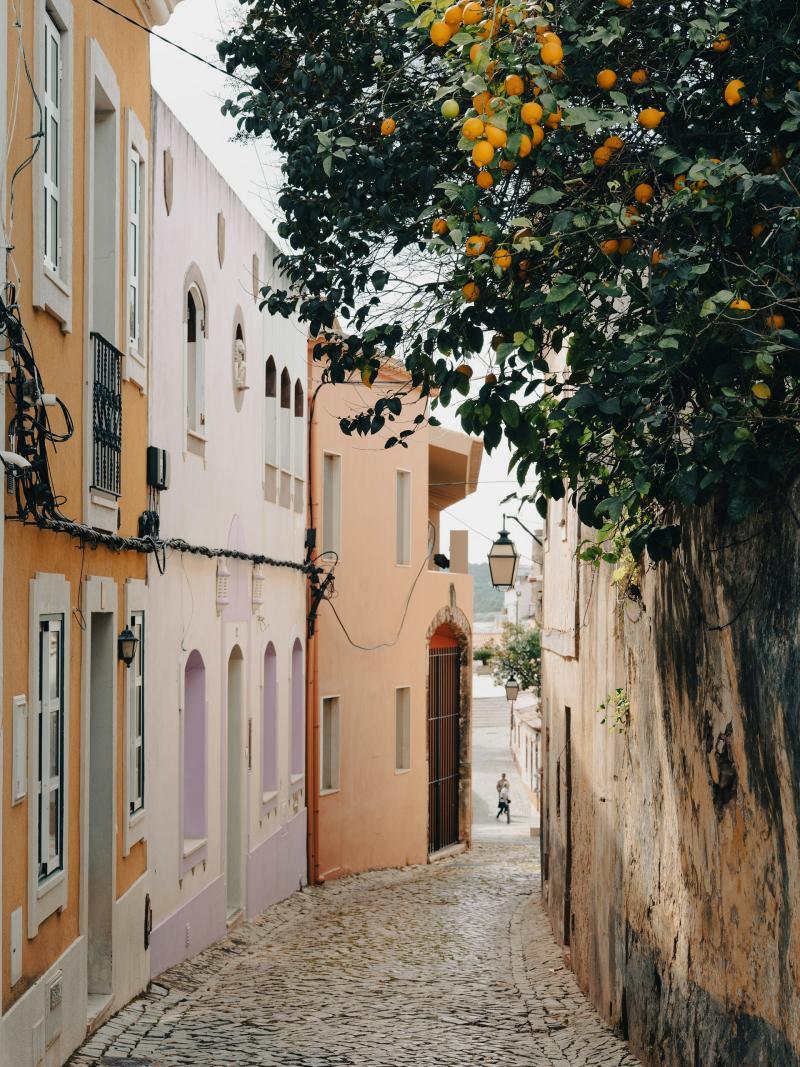
Silves stands out as one of the region’s most historic towns. It’s mainly famous for having one of the very few castles in Algarve, Castillo de Silves.
It’s an imposing Moorish-style castle perched on a hill and offering nice panoramic views from its ramparts. A Gothic cathedral of great charm and numerous vestiges of the medieval era complete this captivating picture.
The town itself is lovely and you’ll love wandering through its cobbled streets to discover craft stores and local produce.
34. The classic Portuguese town of Loulé
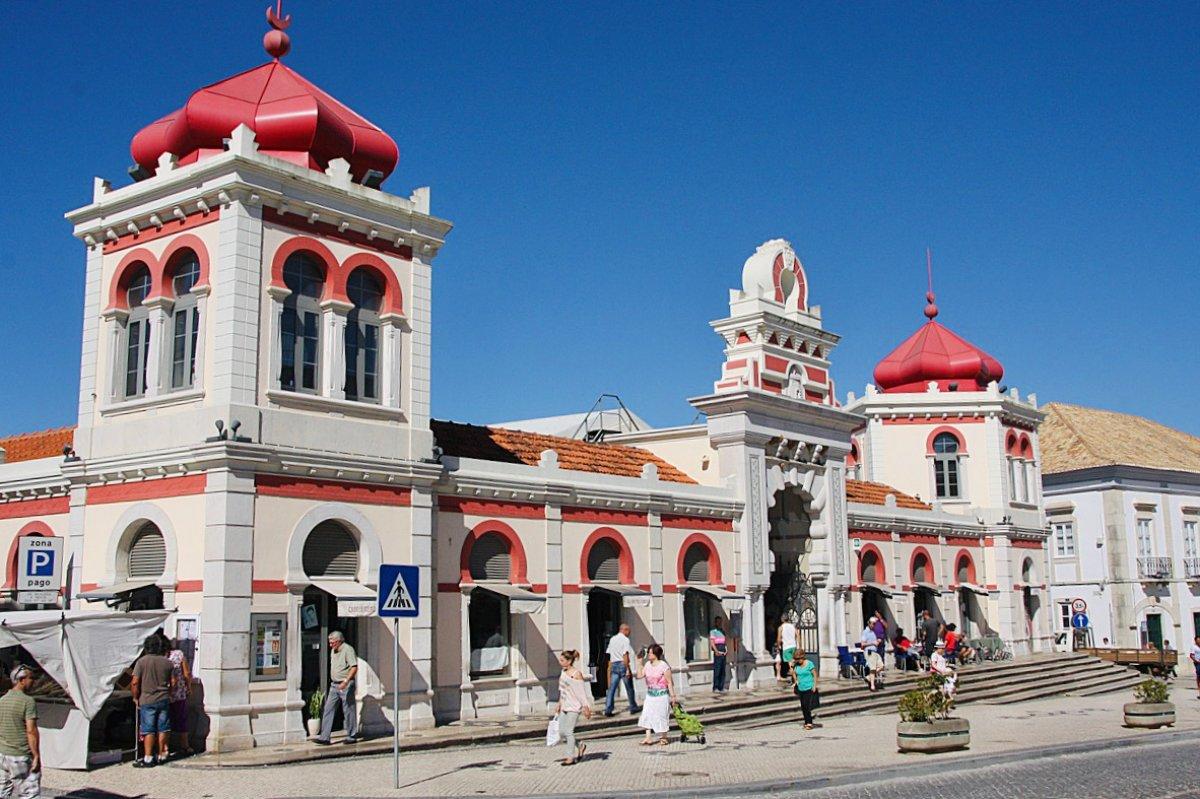
There are plenty of things to visit in Loulé: many churches (Igreja de Sao Francisco), the market, Loulé Castle, …
35. Igreja Sao Lourenço
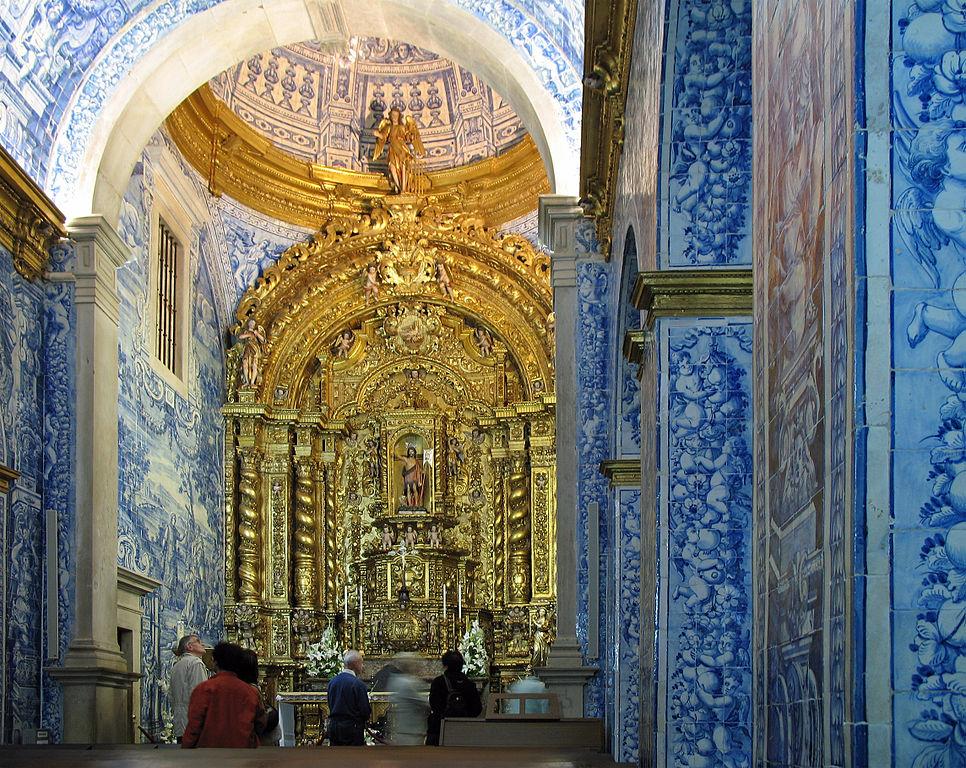
Marc Ryckaert under CC BY 3.0
If you visit Loulé, you need to visit the Igreja Sao Lourenco, an 18th-century Baroque church.
The church looks great from the outside, but it’s even more stunning inside! Traditional azulejos (blue and white tiles) cover the walls and ceiling inside the church, and it’s absolutely beautiful.
36. Monchique and the Serra de Monchique
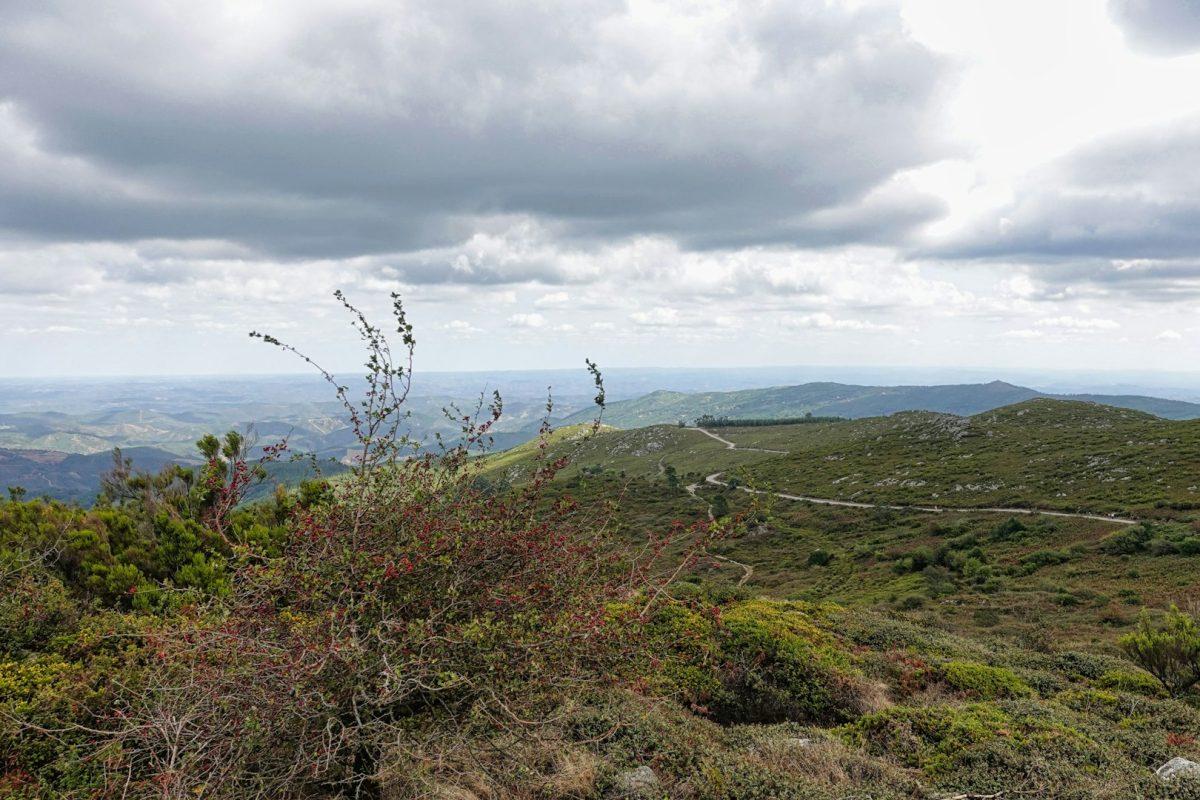
Monchique is a mountain town nestled in the Serra de Monchique, north of Lagos. You’ll find beautiful landscapes with mountains completely different from the rest of the region, and also hot springs and SPA!
☀️ Best time to visit Algarve : The best time to visit the Algarve is between April and October, with July and August being the peak tourist season. To sidestep the scorching summer temperatures and the crowds, plan your trip during the quieter months of April to June or from September to October. Keep in mind, however, that the Atlantic Ocean is cold and rarely exceeds 19°C (66.2°F), even in midsummer!
📆 How long should you stay : The ideal time to discover the Algarve and all its secrets is to spend a week here. This will allow you to visit many beaches, go hiking, and discover beautiful towns. But if the Algarve is part of an itinerary through Portugal, then you can devote 3 to 4 days to it.
🚗 How to get around Algarve : Although many buses are crisscrossing the region (especially in summer), the best way to get around Algarve is by car. Public transport doesn’t reach the smaller, tucked-away beaches and coves, and the journeys are much longer. Renting a car not only provides greater freedom but also allows you more time to explore and make the most of your trip.
🧳 What to pack : Packing for the Algarve depends on the season you’re traveling. But what you’d always need whatever the season is sun protection, sturdy walking shoes, swimwear, sunglasses, and a sweater. If you’re visiting during the winter, make sure to have warm clothes and a raincoat as the wind is strong.
Get my favorite travel gear here to make sure you pack well for Algarve!
So there you have them, the 36 best places Algarve has to offer. There are just so many things to see in Algarve: whether you’re going for a weekend, or for longer, you now have a full list of things to see and it will be a while before you run out of spots to discover 🙂
✋ Before you go, make sure to check out my best Algarve photos here to get more inspiration for your trip.
What is your favorite spot in Algarve? Let me know in the comments below!
Travel Tools
Use any of our recommended links below to book your trip. You pay the same, and we earn a small fee; a great way to support us!
- Find the Best Hotels
- Find a Rental Car
- Insure Your Trip
- Book Your Activities
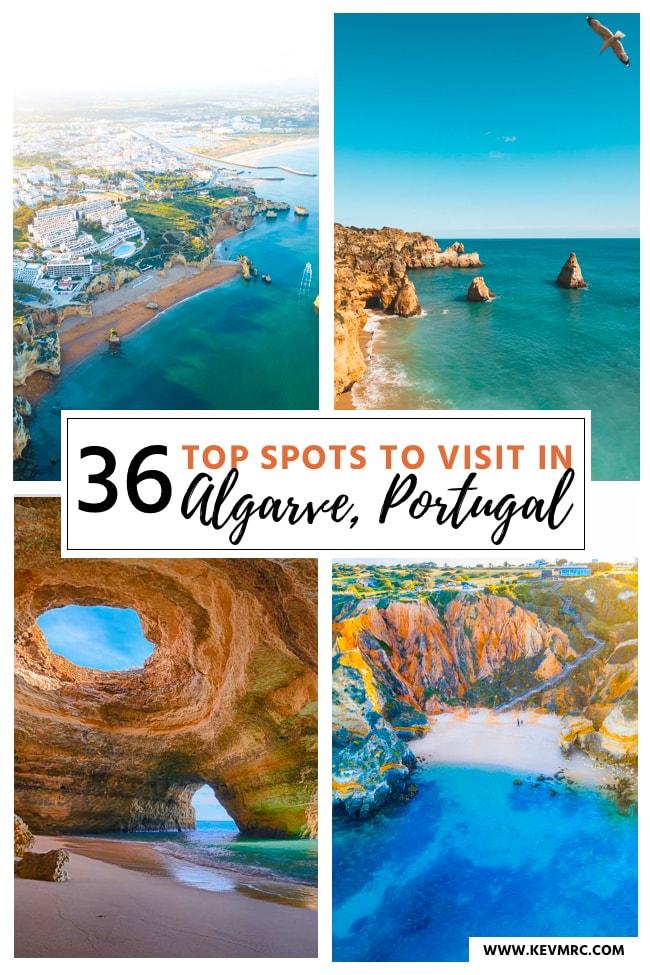
Pin this to Pinterest!
Enjoyed this guide? Then help a fellow traveler and pin it! They'll most definitely love you for it, 100% guarantee.
Pin It Now Follow Me on Pinterest
Hey, I'm Kevin

I'm a professional photographer, with over a decade of experience in the travel industry. I worked with countless travel brands, and my travel advice has been featured in major publications such as CNN, Forbes & the New York Magazine. But the best travel advice is definitely found here on my website! I'm all about adventure travel, hiking and exploring the outdoors - even if I often find myself exploring cities with my wife Nesrine. If you have any questions, leave a comment on this post or reach out by email at: [email protected]
Come say hi on social!
Countries I've visited
Recommended Reading
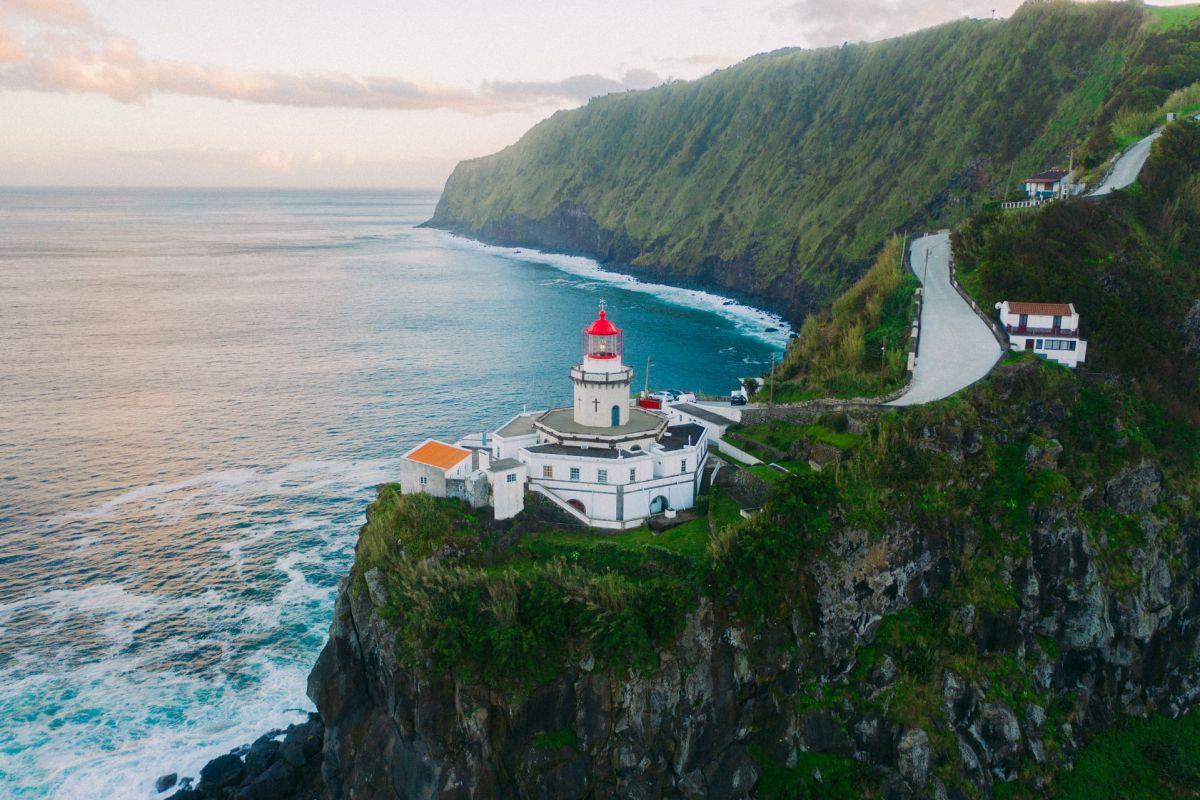
I visited the Algarve last month and loved it! It is such a beautiful and diverse region! My biggest regret is not visiting Tavira, I didn’t have enough time but it looks so beautiful…
Hello would you mind letting me know which webhost you’re working with? I’ve loaded your blog in 3 completely different internet browsers and I must say this blog loads a lot faster then most. Can you recommend a good hosting provider at a reasonable price? Thank you, I appreciate it!
Hello! My website is hosted on bluehost, but speed comes from all the optimizations made after (cdn, lazy load plugin, cache plugin, compressing images, …)
Perfect pictures!
Thanks! Feel free to share as long as you include a link back to the post 🙂
A great place to stay is Faro, it’s pretty central and there’s an airport (Faro Airport). My favorite 5 star hotel is the Iberostar Selection , or you also have the Castelo Guest House , my favorite place to stay for couples.
Promoting Hotels you clearly have an interest in or receive a ‘ Kick Back ‘ from is plain to see in the above post and so embarrassing !
My favourite places are Hotels and Guest Houses which don’t use these underhand fraudulent tactics to entice guests.
Thanks for your feedback! To be honest, I can receive a “kick back” from any hotel. The choice of hotel is absolutely not based on whether or not I can make money with them, but rather on how great they are based on several factors (location, comfort, extra features, …). Btw, what are your favorite hotels?
Where would be a good place to stay in order to explore all these amazing places in southern portugal?
Hello Kelcy, A great place to stay is Faro, it’s pretty central and there’s an airport (Faro Airport). My favorite 5 star hotel is the Iberostar Selection , or you also have the Castelo Guest House , my favorite place to stay for couples.
Leave a Reply Cancel reply
Your email address will not be published. Required fields are marked *
Notify me when new comments are added.
- Portugal Map
Map of the Algarve
Map showing the Algarve region of Portugal. Click on major towns for more information.
Related articles
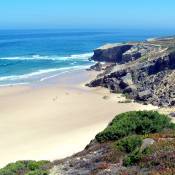

©Juampiter/Getty Images
The Algarve
Soaring cliffs, sea caves, golden beaches, scalloped bays and sandy islands draw over four million visitors to the Algarve each year. Surrounded on two sides by the Atlantic, it's a paradise for surfers, especially along the refreshingly undeveloped west coast.
Best Time to Visit
Best places to visit, attractions, must-see attractions.

Benagil Caves
One of the Algarve's – and Portugal's – most emblematic sights, this huge natural seaside cave has a hole in its ceiling through which streaming sunlit…

The centrepiece of the Cidade Velha, the sé was completed in 1251 but heavily damaged in the 1755 earthquake. What you see now is a variety of Renaissance…

Parque Natural da Ria Formosa
Encompassing 18,000 hectares, this sizeable system of lagoons and islands stretches for 60km along the Algarve coastline from west of Faro to Cacela Velha…

Igreja de Nossa Senhora do Carmo & Capela dos Ossos
One of the Algarve's most dazzling churches, this twin-towered baroque masterpiece was completed in 1719 under João V. After the 1755 earthquake, its…

This russet-coloured, Lego-like castle – originally occupied in the Visigothic period – has great views over the town and surrounding countryside. What…

Igreja de São Lourenço de Matos
This baroque masterpiece was built on the site of a ruined chapel after locals, while digging a well, implored Saint Lawrence for help and then struck…
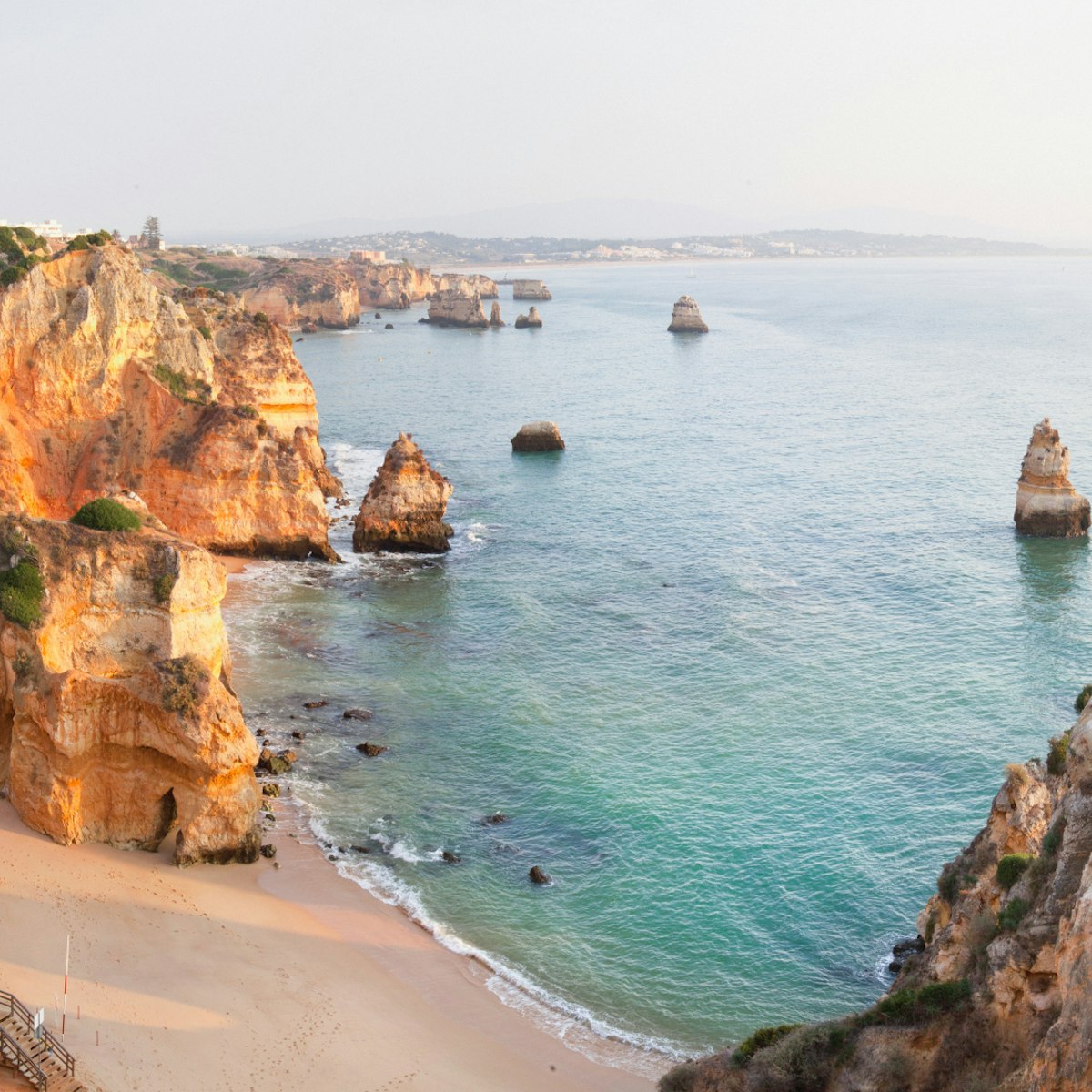
Ponta da Piedade
Protruding 2.5km south of Lagos, Ponta da Piedade is a dramatic wedge of headland with contorted, polychrome sandstone cliffs and towers, complete with a…

Just below the castle is the sé, built in 1189 on the site of an earlier mosque, then rebuilt after the 1249 Reconquista and subsequently restored several…
Top picks from our travel experts
13 best things to do in the algarve.

Cabo de São Vicente
Europe’s southwesternmost point is a barren headland 6km northwest of Sagres' town centre that was the last piece of home that Portuguese sailors once saw…

Built to look like a crab when viewed from above, this remote restaurant rises up on boardwalks from the Ilha da Barreta as its sole building. It's an…
Beach hopping, festivals and more free things to do in the Algarve
Tavira's ruined castle rises high and mighty above the town. Possibly dating back to Neolithic times, the structure was rebuilt by Phoenicians and later…

The 902m Fóia peak, 5.5km west of Monchique, is the Algarve’s highest. The road to the summit climbs through eucalyptus and pine trees and opens up views…

Praia da Ilha de Tavira
This huge white-sand beach at the island's eastern end, opposite Tavira, has operators for water sports (such as windsurfing and kitesurfing), beach bars…

Praia de Faro
On the Ilha de Faro, 9km west of the centre, the town's beach has sweeping sand, windsurfing and kitesurfing operators, and a handful of cafes. It's…
Planning Tools
Expert guidance to help you plan your trip.
Best Things to Do
Fill up your senses in the Algarve. Incredible beaches, world-class restaurants and scenic walks are among our top things to do in the Algarve.
Things to Know
Make the most of your visit to Portugal’s Algarve with these local tips, ideal for first-timers.
Money and Costs
When planning a trip to the Algarve region in southern Portugal, you can save money with these top 10 tips.
Best Road Trips
If you’re looking for the best road trips through the Algarve, don’t miss these five top drives, taking in hilltop villages and stunning coastal scenery.
Plan with a local
Experience the real Portugal
Let a local expert craft your dream trip.
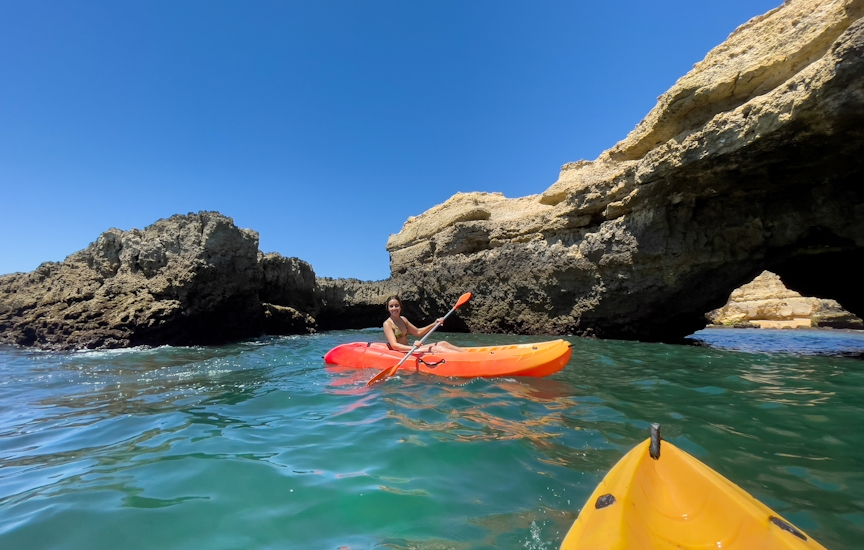
Latest stories from The Algarve
Filter by interest:
- All Interests
- Adventure Travel
- Art & Culture
- Beaches, Coasts & Islands
- Food & Drink

Destination Practicalities
Mar 3, 2024 • 6 min read

Feb 27, 2024 • 6 min read

Jul 23, 2023 • 6 min read

Jul 12, 2023 • 6 min read

Jul 12, 2023 • 7 min read

Jul 4, 2023 • 5 min read

Jul 6, 2022 • 5 min read
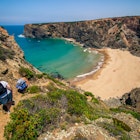
Jun 28, 2022 • 7 min read

Jun 22, 2022 • 6 min read

Jun 20, 2022 • 6 min read
The Algarve and beyond

World Map » Portugal » Region » Algarve » Algarve Tourist Map
Algarve tourist map
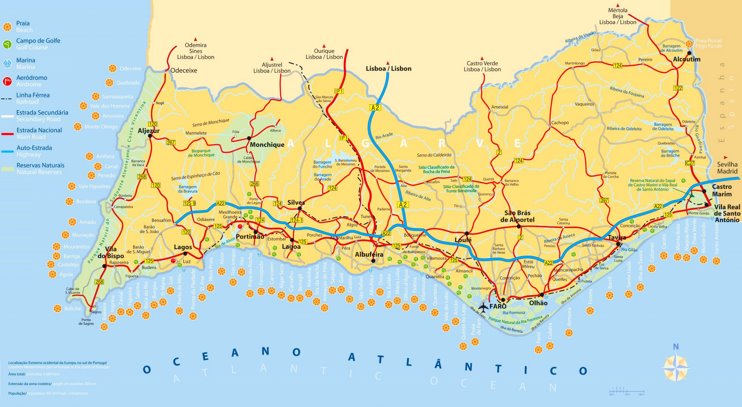
You may download, print or use the above map for educational, personal and non-commercial purposes. Attribution is required. For any website, blog, scientific research or e-book, you must place a hyperlink (to this page) with an attribution next to the image used.
Portugal maps
- Portugal map
Cities of Portugal
- Praia da Rocha
Regions of Portugal
- North America Map
- South America Map
- Oceania Map
Popular Maps
- Australia Map
- Germany Map
- Singapore Map
- United Arab Emirates Map
- United Kingdom Map
- United States Map
- New York City Map
- Los Angeles Map
U.S. States
- California Map
- Colorado Map
- Florida Map
- Georgia Map
- Illinois Map
- New York Map
- North Carolina Map
- Virginia Map

Faro, Portugal: 14 BEST Things to Do & Places to Visit (+Map & Tips)
By Author Jurga
Posted on Last updated: December 13, 2023
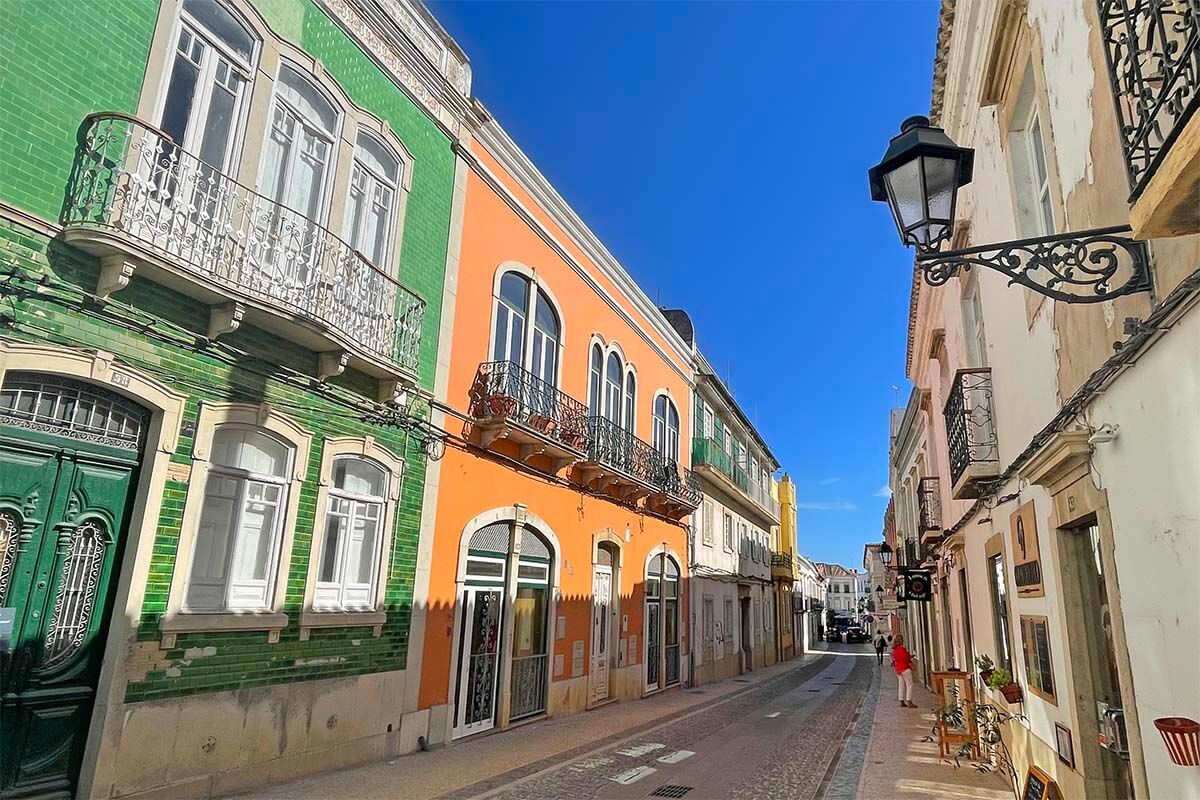
Faro is the capital city of Algarve in Portugal and a gateway to the region. If you are arriving in Algarve by plane, you’ll be landing at Faro airport. The majority of tourists immediately head to their beach destination and don’t spend any time in the city. However, if you want to see a couple of the nicest towns in Algarve , Faro is definitely worth a visit.
But what to expect and what is there to see and do in Faro?
In this guide, you can read about all the best places to see and things to do in Faro for first-time visitors . These are the main sights and activities in Faro town and its immediate vicinity that are worth your time the most.
Good to know: Faro is a rather big town, but the old town where all the main tourist sights are located is very compact. You can easily explore Faro on foot and see everything in about half a day (this makes it very simple to include Faro in any Algarve itinerary ). If you want to visit all the best places in Faro mentioned on this list and visit one of the nearby islands or take a boat tour of Ria Formosa Nature Reserve, plan to spend an entire day in Faro.
To help you plan your visit and get a better idea of where everything is located, we created a map of the best places to see in Faro – see below. In addition, at the end of this post, you’ll find some practical information for your visit, tips on where to stay or where to park, etc.
But first – what to expect and what are the top sights and best things to do in Faro. Take a look!
How to use this map: Use your computer mouse (or fingers) to zoom in or out. Click on the icons to get more information about each place. Click the arrow on the top left corner for the index. Click the star next to the map’s title to add it to your Google Maps account. To view the saved map on your smartphone or PC, open Google Maps, click the menu and go to ‘Your Places’/’Maps’. If you want to print the map or see it in a bigger window, click on ‘View larger map’ in the top right corner.
Good to know: Despite the fact that Faro is the capital city of one of the most popular tourist destinations in the country, you really can’t compare it to Lisbon or other nicest towns in Portugal . Depending on where exactly you start – and even more so on when you visit – you may get a totally different impression of Faro.
Let me be quite honest – the first time we visited Faro, we weren’t overly impressed. This was in November and while some parts of the city were relatively lively, others were completely deserted.
If you have visited the nicest places in Algarve , then you quickly realize that Faro definitely doesn’t have the same wow factor as the most spectacular coastlines… But it’s charming in its own way, and so we thought it deserved another chance.
Since we travel to Algarve quite often, we decided to visit Faro once again. This time, we made an effort to do some research in advance, took our time to explore just a bit deeper, and… we absolutely loved it.
So I hope that this guide and our experience-based tips will help you make the most of your trip and get just as excited about Faro as we were after this second visit. Because it has more to offer than it looks at first sight. Find out!

Here are the best things to do in Faro:
1. Faro Old Town
When you first arrive in Faro, the best place to start your visit is the historic Old Town . This picturesque maze of narrow cobbled streets, white-washed buildings, and charming plazas is like a step back in time where you can catch a glimpse of the authentic Algarve.
There are a few main landmarks that you absolutely shouldn’t miss here. Here is an overview and some pictures to give you a better idea of what to expect (we also cover the main sights in detail further below).
Start your visit at Arco da Vila . This impressive 19th-century city gate is the main entrance to the historic center of Faro, Cidade Velha , which used to be completely walled (and you can still see parts of the old city walls as you explore this area). If you look up, you may see some storks in the nests at the top of this city gate.
Nowadays, you can visit the Interpretative Center of Arco da Villa where you can learn more about the history of the City of Faro (more info here ). We also saw signs for Portuguese guitar (Fado) concerts at the city gate as well.
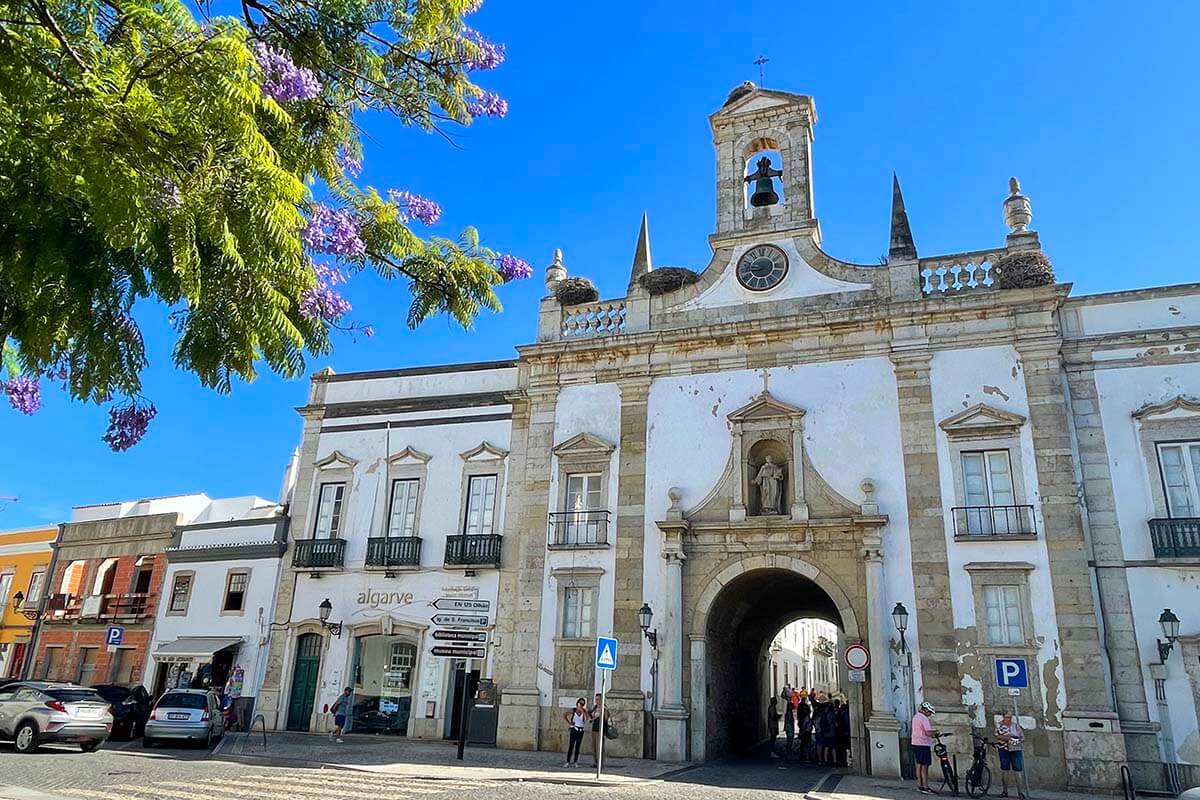
Soon, you’ll reach Largo da Sé . This town square is home to Faro Cathedral and a few other points of interest. There are several museums in this area, and also cafes and restaurants.
You can also see an old Beer Factory here, at the site of old fortifications. Together with the city walls, it looks a bit like a castle from a distance, but it’s far from that.
The building is only used once in a while, for temporary exhibitions or other cultural events. If it’s miraculously open on the day of your visit, you may want to take a look inside. We heard that you can walk up to the top and enjoy nice views of the city and the lagoons around it.
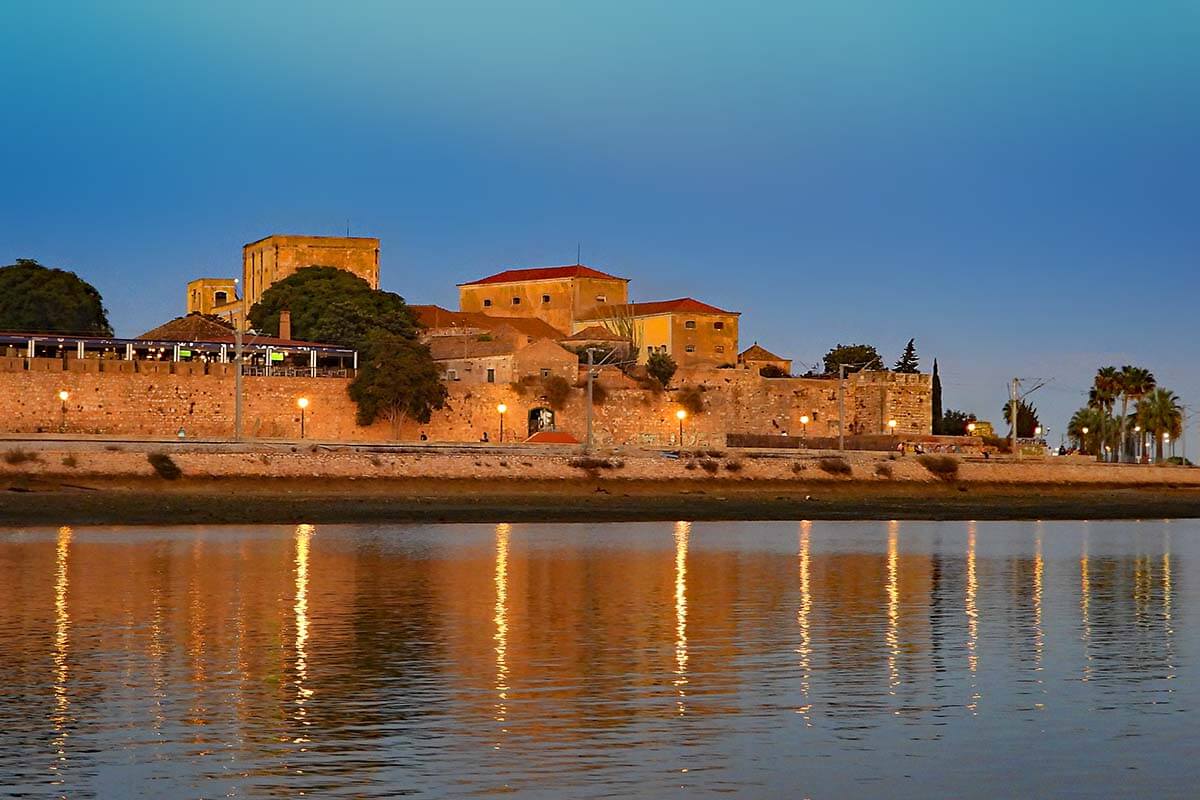
If you go further west, you’ll leave the walled city center and find yourself on the waterfront with several fishermen’s cabins and a ferry to the nearby beaches.
If you remain within the city walls, you can explore the narrow streets a bit further. Here, you’ll also find the Municipal Museum of Faro which is well worth checking out (more info below).
Afterward, you can leave the walled part of the old town via Arco do Repouso , which is another impressive city gate.

After leaving the city gate, turn left and walk next to the walls.
There are some azulejo tiles here and there depicting historical scenes. Next to the old town walls, you can also find the beautifully restored building of Palácio Belmarço .
I indicated all these places on our map of Faro attractions. But this part of the old town is quite small, so you can’t really miss them.
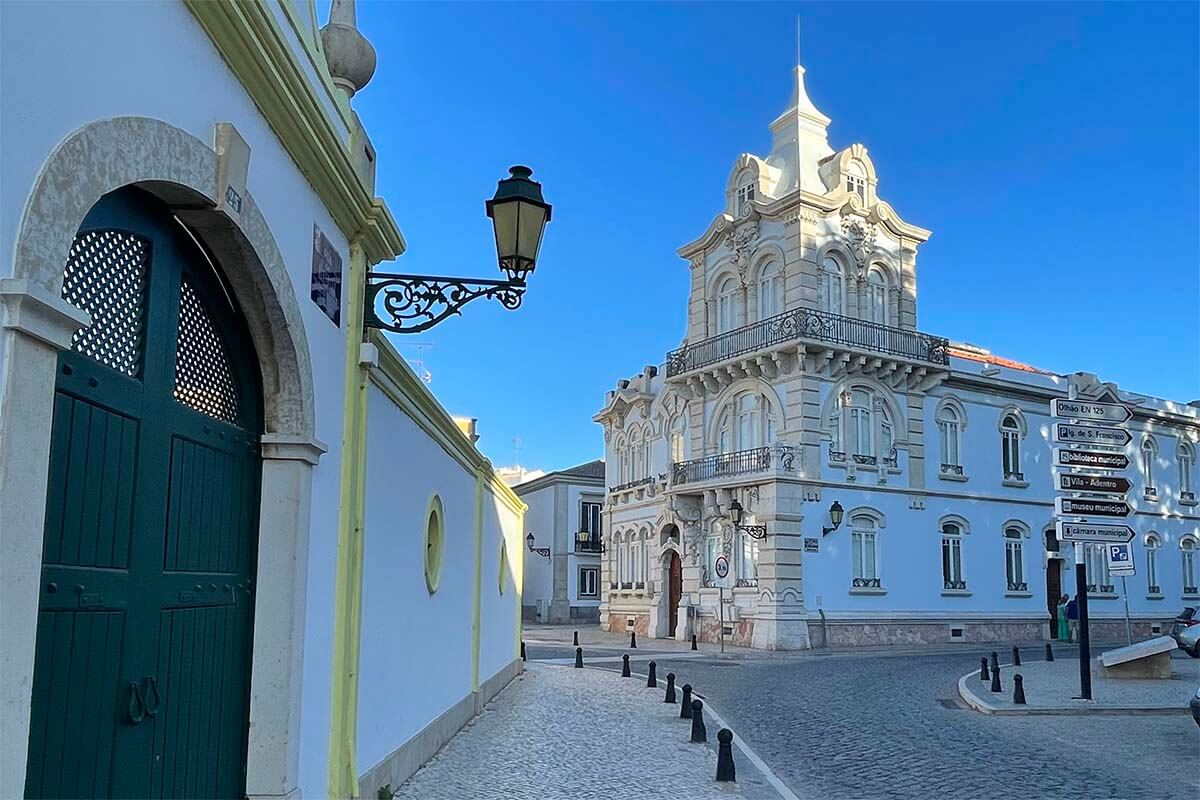
2. Faro Cathedral & Bell Tower
Located within the city walls, on the square of Largo da Sé, you’ll find the Cathedral of Faro , aka Igreja de Santa Maria. If you are looking for the best things to do in Faro, a visit here should be high on your list.
Faro Cathedral is one of the oldest and most important buildings in the city, with its history going back to Roman times when there was a Roman temple here. During the Moorish reign, the church was transformed into a Mosque… The current building dates from the end of the 16th – beginning of the 17th century, with multiple improvements over the centuries. Most wall tiles inside are from 1694.
There are a couple of things to see here. First, the interior of the church itself with multiple chapels, each in a different style.
You can’t really miss the impressive 18th-century organ . It’s quite large and strikes with bold red color and Chinese decorations. Quite an unusual sight.
TIP: Take the stairs to the 1st floor from where you get a closer view of the organ. On the first floor, you’ll also find a small Museum of Sacred Art . These rooms date from 1697 and 1813 and are worth a quick look even if you are not interested in the collection.
Outside, you can visit the Cloister garden , which used to be a cemetery and a few chapels. Be sure to check out the Bones Chapel from 1664. Please note that this is NOT the famous Faro Chapel of Bones which is located in another church in the city (you can find more information about it below).

Another reason to visit the Cathedral is its Bell Tower . You can climb all the way to the top of the roof where you can get close to the bells and enjoy a nice elevated view of the city and its surroundings. This is the best place from where you can better appreciate the unique location of Faro town, encircled by the lagoons of Ria Formosa.
The good thing is that the tower is really not that high so it’s absolutely doable for most people. Just keep in mind that the stairs are rather steep and narrow.
Practical information: Faro Cathedral is open daily except on Sundays, with hours varying depending on the season. In the main tourist season, it’s open on weekdays from 10 AM to 7.30 PM and on Saturdays from 9.30 AM to 4 PM; the last entry is half an hour before the closing time. There is a small entry fee which goes towards the repairs and upkeep of the building. They accept cash and cards.
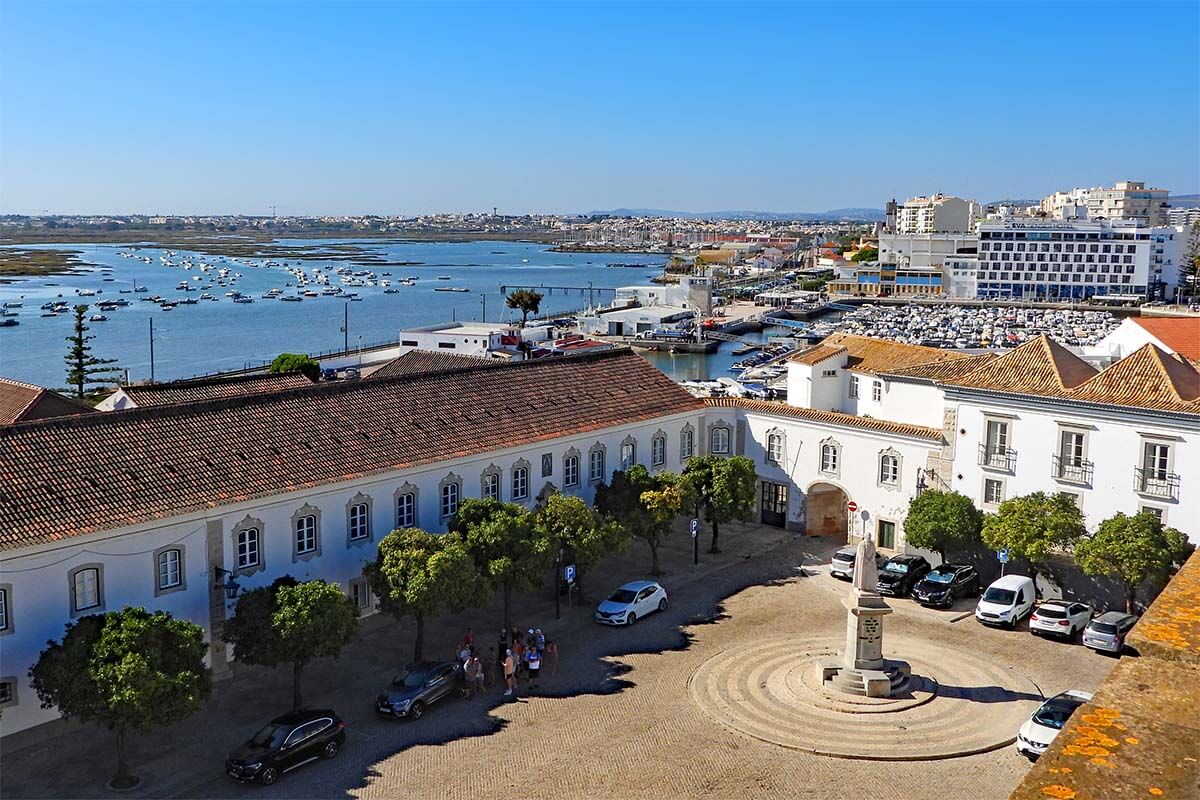
3. Chapel of Bones & Carmo Church
Capela dos Ossos de Faro (the Faro Bones Chapel) is one of the most famous landmarks in Faro.
It’s located on the grounds of Igreja do Carmo (the official name – Igreja da Ordem Terceira de Nossa Senhora do Monte do Carmo), about 10-15 minutes walk from the main part of the old town.
The Carmo Church with its gold-plated altars is well worth a visit in its own right. Dating from the 18th century, the building is very impressive both – from the outside as well as on the inside. But the main reason people come here is the unique little chapel located in the gardens of the church.
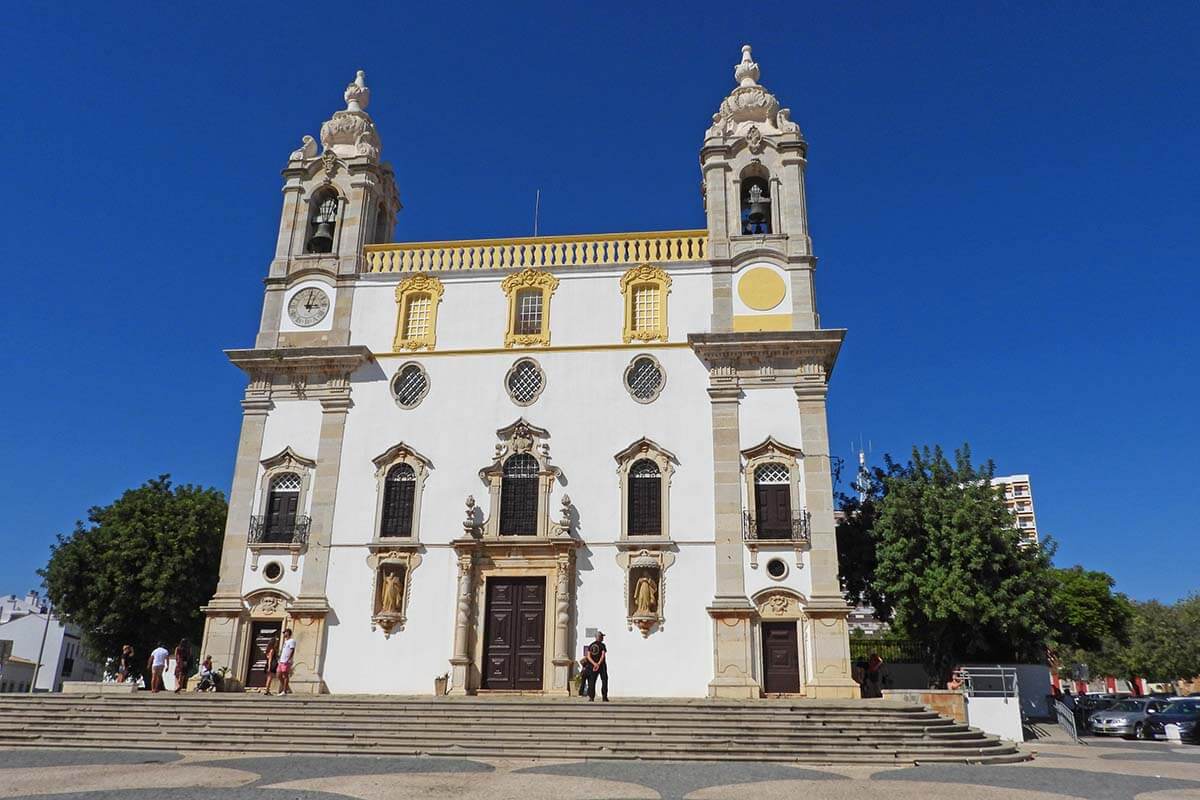
Just as its name suggests, the Chapel of the Bones is decorated using human skeletons. The bones and the skulls that you see here come from an old dismantled cemetery of over 1200 Carmelite monks. While some skulls have been lost (or stolen) over the centuries, the chapel is still very impressive.
While it’s much smaller than Portugal’s most famous Chapel of Bones in Évora, the Faro Bones Chapel is quite well preserved and is certainly worth seeing. In fact, it’s the most visited Faro attraction, so expect it to be busy.
Practical information: The Bone Chapel can only be accessed via the Church and there’s a small fee to visit (cash only). The Church is open daily except on Sundays. On workdays, it’s open from 9 AM to 1 PM and from 3 PM to 5 PM, and on Saturdays – only in the morning.

4. Faro Marina
Faro Marina is located in the heart of the old town and is a lively area that you’ll definitely pass when sightseeing in Faro. If you arrive in the city by train, this will likely be your first introduction to the city (the railway station is just nearby).
Here you will find the Love Faro Sign and several interesting sculptures. There are also numerous cafes and restaurants in this area and it’s a great place for a leisurely stroll or to enjoy a meal with a view.
Various tour operators offering all kinds of boat trips and excursions in the area are also located around Faro Marina. (You can find more info about the best tours further below).
TIP: Some of the nicest hotels in Faro – Eva Senses and Hotel Faro & Beach Club – are also located here. They both have stunning rooftop pools, plus, Hotel Faro also has a rooftop bar which is a great place for a (sunset) drink.

5. Jardim Manuel Bivar
Jardim Manuel Bivar is a small public garden located just across the street from Faro Marina. It’s basically a shaded plaza with several big trees, benches, a small playground, etc. The main city gate – Arco da Vila – is located at the southern end of this square.
Being right in the center, this is a popular place for all kinds of events and fairs, e.g. live concerts, annual Christmas Markets, etc.
On weekends, there is usually an arts and crafts market which is well worth checking out. You can buy some traditional souvenirs here, not just the usual stuff that you find in most tourist locations in Algarve.
Good to know: This is also a popular meeting place – for locals, but also for all kinds of tours, etc. Faro Tourist Hop-on Hop-Off Train also stops here (although I’m really not sure if it’s worth it). On the square, you can also find a drinking water fountain where you can refill your bottles.

6. Municipal Museum of Faro
For a rather small town, there are quite a few museums in Faro. You can find a list of the main ones below. But if you visit just one museum in the city, make it the Municipal Museum of Faro (Museu Municipal de Faro).
Located in an old convent building inside the walled part of the old town, this is by far the most interesting museum in Faro.
This museum features some impressive archeological exhibitions found in the Faro area. The must-see is the Mosaic of Oceanus which dates from the 2nd to 3rd centuries. It was discovered during the works next to the current train station and is incredibly well-preserved.
The museum also has temporary exhibitions and also organizes Fado concerts . Depending on the season, there are concerts quite frequently, several times during the day. You can check availability and book tickets here .
But it’s worth coming here even if just to see the building where the museum is housed – The Convent of Our Lady Of The Assumption . It was first commissioned in the 16th century by the Queen of Portugal and has been restored and remodeled multiple times throughout the centuries.
Practical information: Faro Municipal Museum is open daily except Mondays, from 10 AM to 6 PM (10.30 AM to 5 PM on weekends). You need about half an hour for a visit. There is a small fee to visit and they do accept cards.
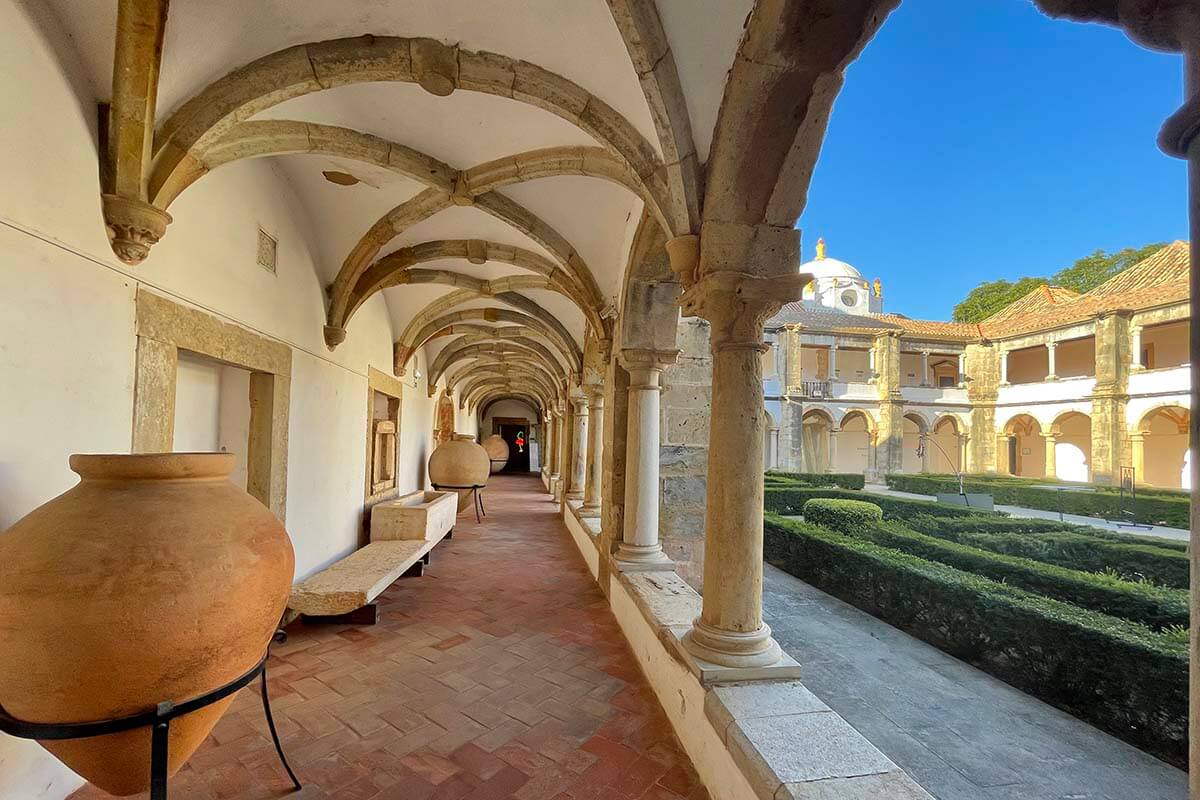
7. Faro Story Spot
Faro Story Spot is one of the newest attractions in Faro. It’s an immersive multimedia experience that takes you on a journey through the centuries-old history of the city, until today.
It’s really nicely done and gives you a good overview of the origins of the city, the main points of interest to visit in Faro today, as well as some info about the marine life of the Ria Formosa Nature Reserve. It also briefly introduces you to local gastronomy, and you can also opt to taste some local specialties at the end of the tour.
The whole experience is a bit of a mix of everything related to Faro, but since you go from one themed room to another, it somehow fits together and has a very positive vibe. It takes about 45 minutes and is suitable for all ages (but will be most enjoyable for families).
We really enjoyed a visit here. The only negative is that the price is quite steep compared to all other landmarks and sights in Faro. But it sure makes your visit to the city a bit more special by giving a very different view of it compared to just seeing churches and traditional museums.
Practical information: Faro Story Spot is open daily from 10 AM to 10 PM (!) during the peak summer season (June through September). The rest of the year, it closes at 5.30 PM and is closed on Sundays and some public holidays. The tour is available in four languages including English. You can find more info on their website , or simply pop in and check it out. It’s located next to the Cathedral, so you’ll pass here anyway.
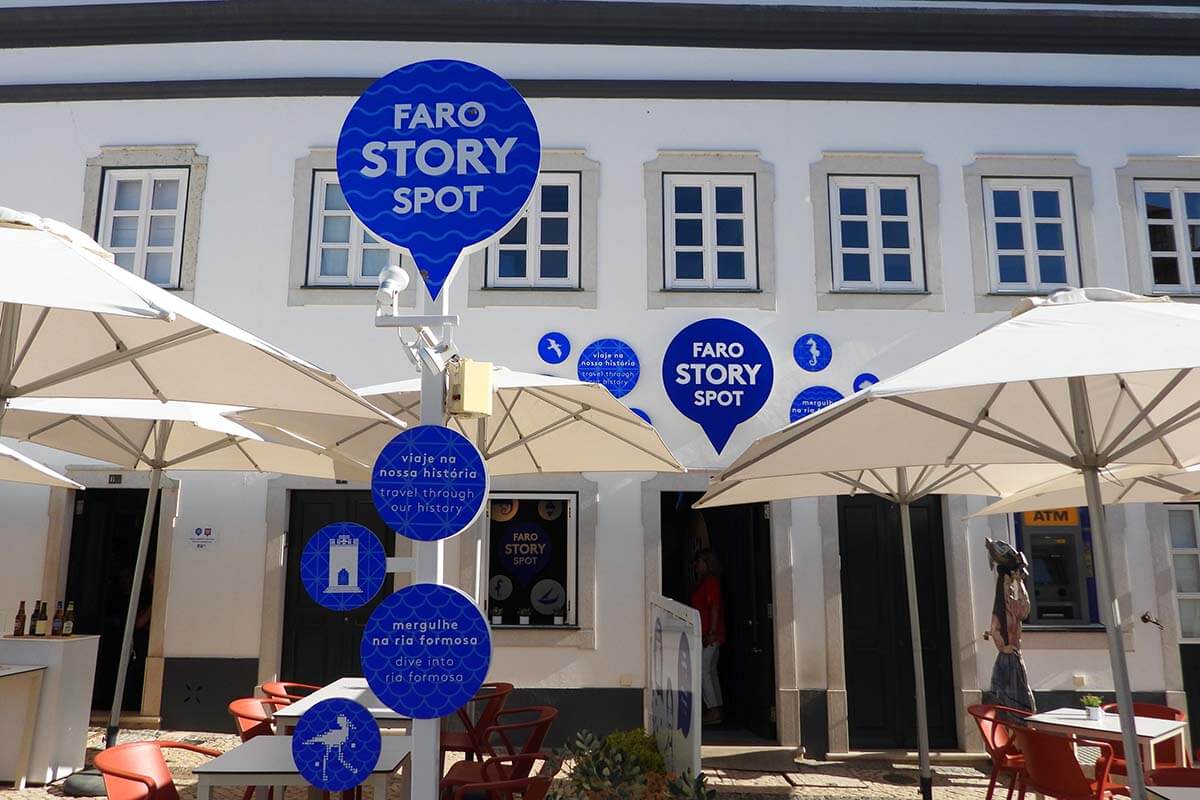
8. Ria Formosa Natural Park
Ria Formosa is a natural reserve that stretches through a big part of eastern Algarve, also around Faro.
This stunning coastal lagoon is protected from the ocean by several islands and is home to diverse bird species and unique ecosystems. This vast area encompasses different canals, salt marshes, and tidal flats. A visit here is a serene escape from the city, plus, you have fantastic birdwatching opportunities.
There are several ways to visit Ria Formosa from Faro, most of them involve taking a boat. But there are also segway tours and bike tours available.
If you have half a day or even a whole day to spare, you can take a ferry to one of the nearby beaches (more info below) or opt for a hop-on hop-off islands tour which allows you to visit several islands of Ria Formosa at your own pace.
Alternatively, if you want to see a lot in a short time, consider one of the boat tours . They typically take about 3-4 hours and bring you to several islands. This highly-rated tour on a small modern catamaran is the most popular excursion in Faro. It passes several really nice areas and stops at two islands – Farol and Deserta.
TIP: If you are short on time, consider a 1-hour sunset tour . I recently did it with my mom and we both absolutely loved it. There is just something about the sunsets in Algarve – they are absolutely magical! We did this tour after the whole day of sightseeing in Faro and I can’t imagine a better and more relaxing way to end the day. The water was like a mirror…
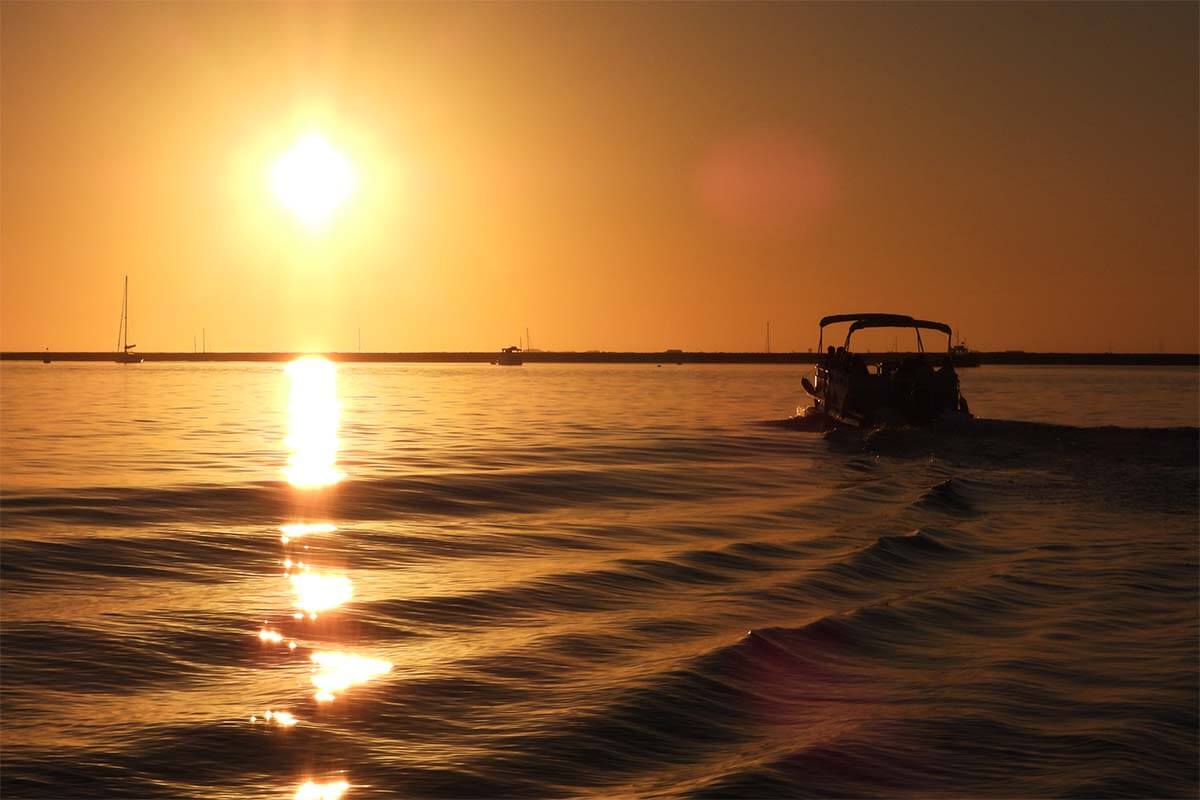
9. More Churches
In addition to the Cathedral and Carmo Church which you absolutely shouldn’t miss, there are quite a few other churches in and near Faro.
Whether you want to see more of them, I’ll leave it up to you. It will also depend on how much time you have.
But if you have time, here are our top 2 recommendations that we think are well worth it:
- Igreja de São Pedro. This is a very nice church located between the main sights of Faro Old Town and Carmo Church (the one with the Bone Chapel). When walking there, you’ll likely pass this church anyway, so check if it’s open and take a look inside. There is no fee to visit.
- Igreja de São Lourenço . This is the most beautiful church in Algarve. The azulejo tiles here are incredible! Unfortunately, they don’t allow pictures inside… Anyway, this church is located outside of the city, about 15 minutes drive from Faro old town. But I really want to mention it because it’s very impressive. If you have a car and are road-tripping in the area, you’ll likely pass here anyway – be sure to check it out.
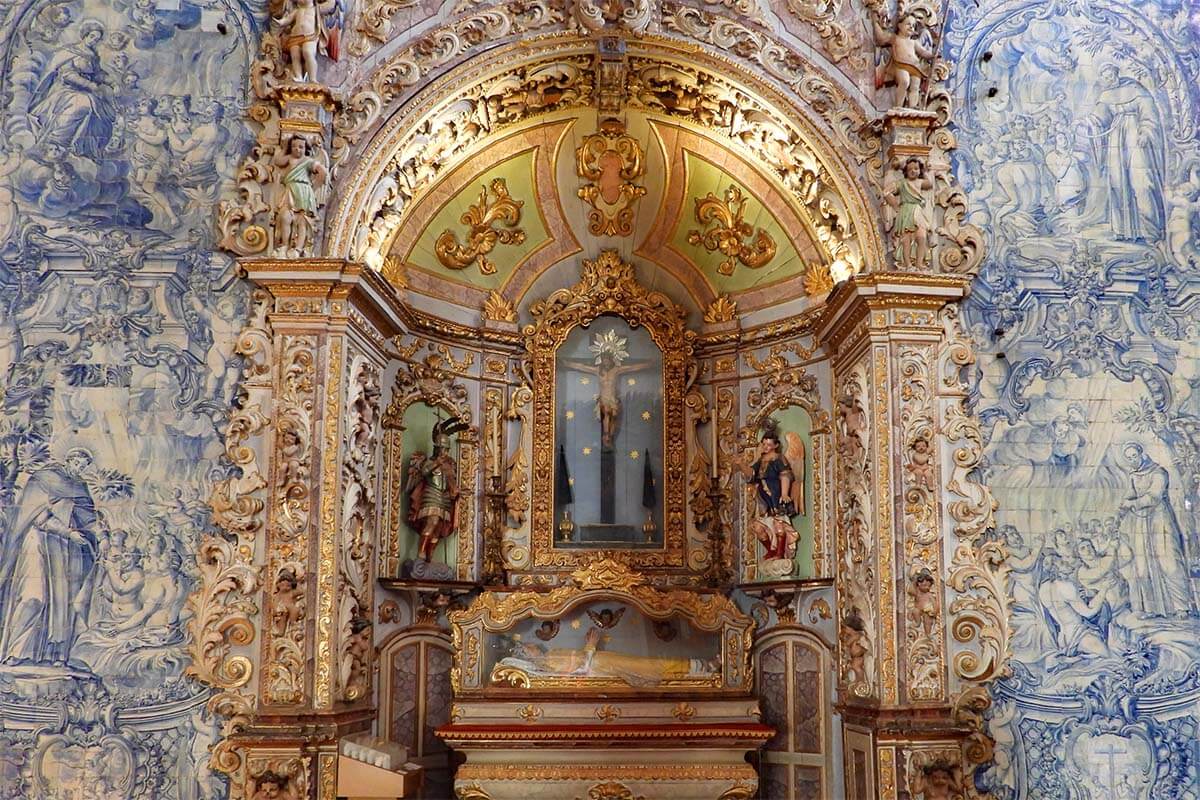
10. More Museums
For a rather small town, there are quite a few museums in Faro. Here’s an overview of the main ones apart from the ones already mentioned above:
- Museu Regional do Algarve , located in the old town. This museum is dedicated to the Algarve region. It’s a low-key ethnographical museum featuring some local artifacts and showcasing daily life in the past.
- Museu Marítimo Almirante Ramalho Ortigão is located at the Marina. This small museum is dedicated to maritime history and features some ship models, etc.
- Centro Ciência Viva do Algarve (Algarve Life Sciences Center) is located at the waterfront, just outside of the city walls and a short walk from the Cathedral. This is a natural history museum + aquarium + kids’ science center in one place. If you are looking for something fun to do in Faro with kids, you’ll want to check it out!
READ ALSO: Best Things to Do in Algarve with Kids
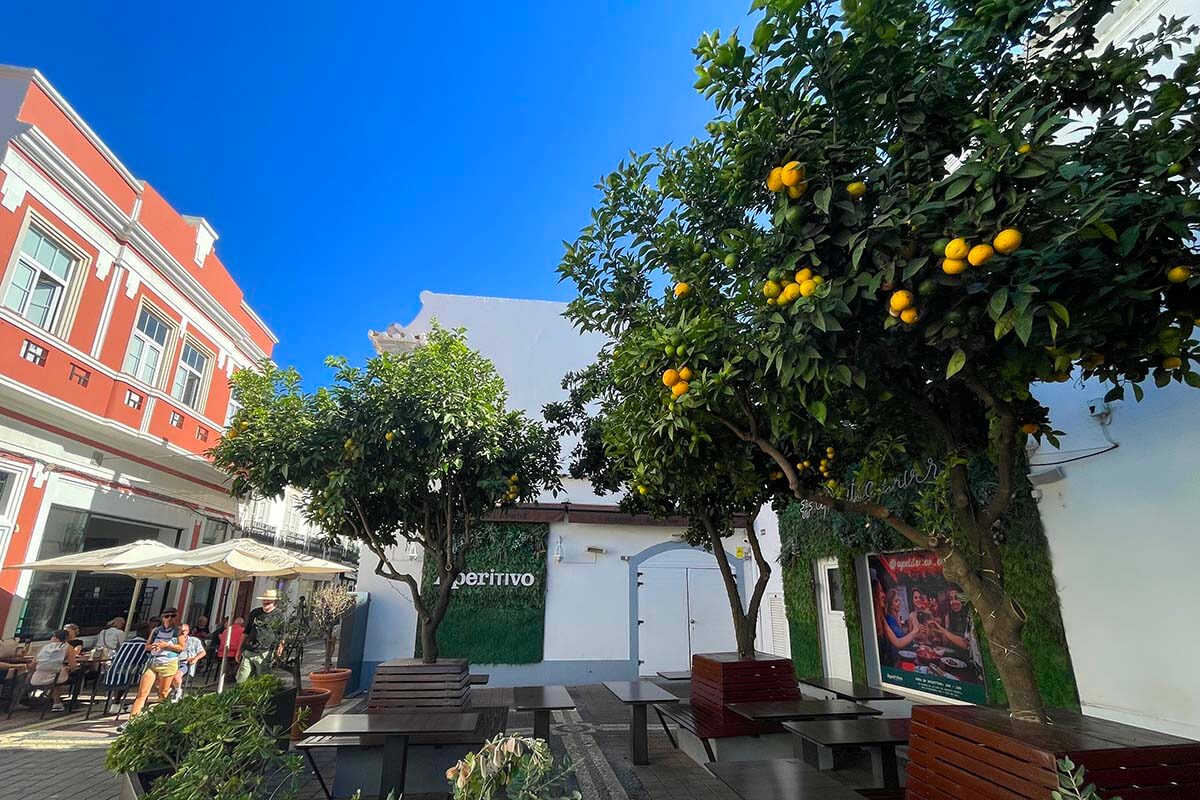
11. Faro Beach
Praia de Faro is the main beach of the city. It’s located on one of the barrier islands of Ria Formosa reserve, outside of the town, and next to the airport.
This beach can be reached by car or by ferry from the old town (I indicated the location on the map). The ferry takes about 25 minutes and costs about 4 euros for a return journey. Along the way, you can also see the lagoons of Ria Formosa.
Faro Beach is a rather simple, flat white-sand beach that stretches for several kilometers. There are numerous restaurants and cafes there, water sports rentals, etc. Most places are only open during the main tourist season (+- April to the end of October – beginning of November).
It’s a popular place for locals to escape the city for a few hours. But if I’m completely honest (and locals agree too), this is not the nicest beach in the area (not even to mention the airplane noise).
If you decide to come here, it’s best to combine a visit to the beach with some exploration of the Ria Formosa, see some birds, enjoy a nice meal at a local restaurant, etc. There is a nice segway tour in this area that offers a combination of all of the above.
TIP: If you are looking for a nice beach to visit in this part of the Algarve, the beaches on the Deserta, Farol, and Culatra islands are much better (those are the beaches where most boat tours go to, and where you can also visit with the hop-on-hop-off boat ).
READ ALSO: Most Beautiful Beaches in Algarve (hint – they are all located much further west)

12. Local Food
No guide to Faro would be complete without mentioning local food . There are tons of nice restaurants and eateries in town (and on the beaches), so you won’t have difficulties finding something nice.
Try dishes like grilled fish, sardines, cataplana (seafood stew), and Algarvian desserts with figs, carob, and almonds. Algarve’s restaurants offer some of the freshest seafood you’ll ever taste. The flavors are rich, and the ambiance is often relaxed and welcoming.
Just be sure to check the reviews (we usually use Google Maps) and remember that things are laid back in the Algarve. It’s usually not the best idea to go to a restaurant if you are short on time. Sometimes it works out and you get quick service, but it can also take a lot longer than anticipated and ruin your mood… If you are in a hurry, it’s better to get something on the go for lunch and then sit down for a long quiet meal in the evening.
TIP: This highly-rated old town walking food tour is a nice way to explore Faro and its food with a local. We absolutely love food tours when we travel – it’s such a great way to experience a new place.
If you like visiting local markets, check out the Faro Municipal Market . On the same site, you’ll find a food market, but also a supermarket and lots of cafes and restaurants. It’s a good place to sample local specialties or get some traditional treats to take home with you.
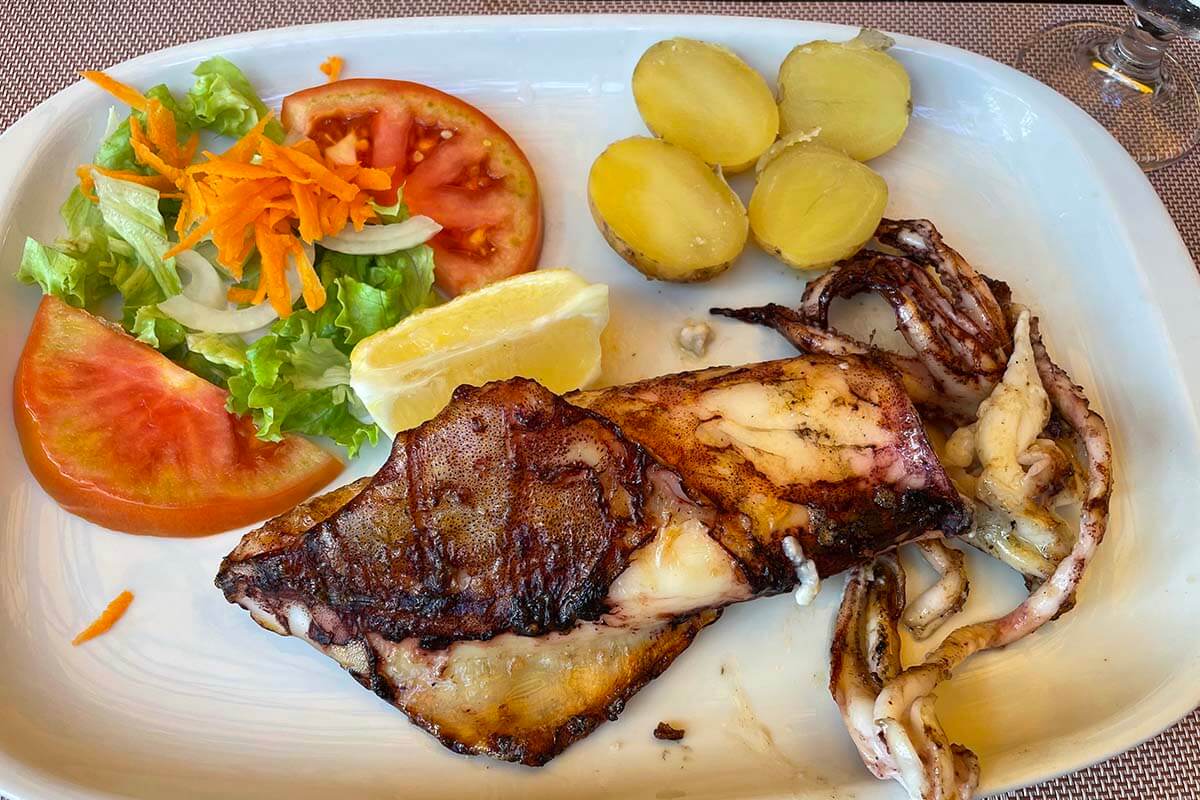
13. Shopping
As far as shopping goes, apart from souvenirs in the old town, shopping in Faro isn’t that great. However…
There are a couple of really good places to go shopping near Faro. One of them is Forum Algarve 5-10 minutes drive from the center. And the other one – even bigger – is the MAR Shopping Center that is located 10-15 minutes drive from the city center.
MAR is a multi-storey indoor shopping mall that also has a food court, a cinema (with movies in the original language), and several restaurants. The shopping mall is also interconnected to a big IKEA. Just next door, you will also find the Algarve Designer Outlet.
If you are in Faro for a longer vacation, check it out. It’s also a nice place to spend a couple of hours when it’s too warm for sightseeing.
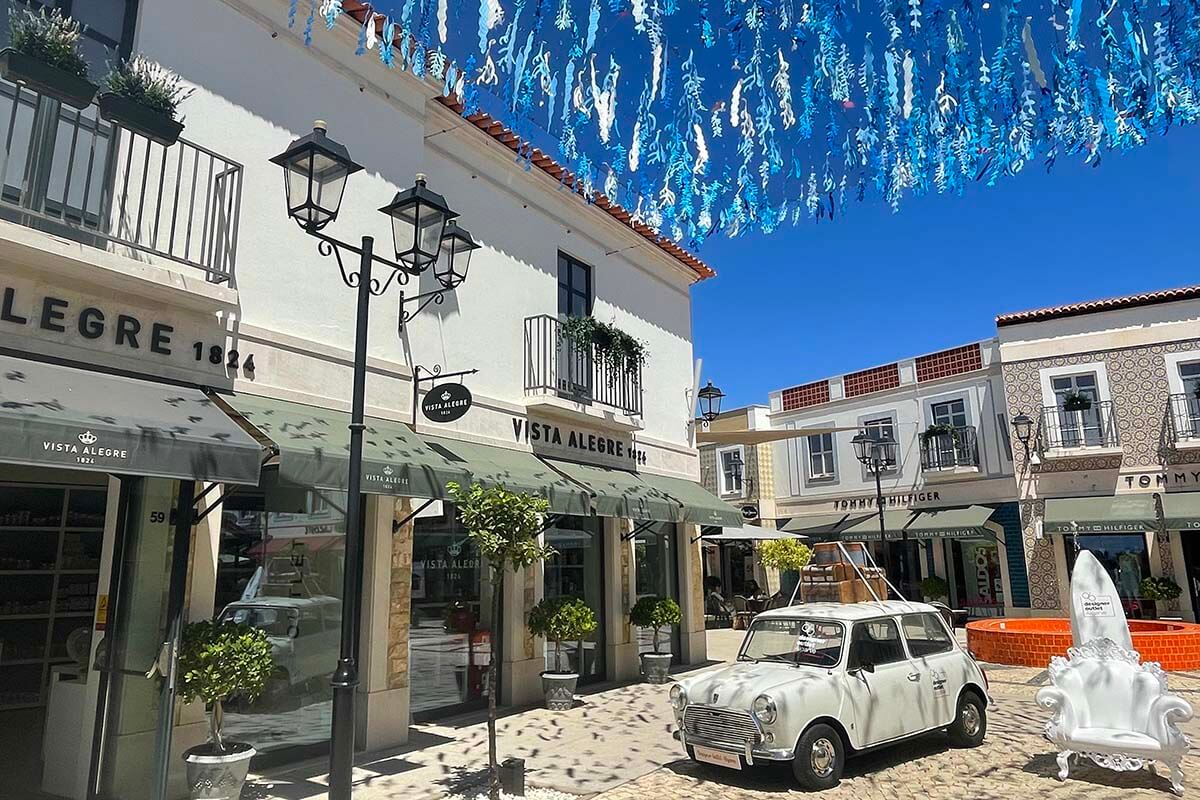
14. Excursions & Day Trips from Faro
In addition to all the nice things to do in Faro, there is so much more to see and experience in the Algarve region. If you have a car, you can easily spend several weeks exploring the region and still not see it all.
But also without a car, you can still see a lot. There are boat tours to some of the nicest places along the coast and bus/jeep tours inland. You can also simply get a taxi/Uber if you want to visit some places near Faro (taxis are very affordable in Algarve).
Here are some of the best tours that we recommend near Faro:
- Ria Formosa boat tours (already mentioned before).
- Benagil Cave tours ( by boat and/or land ).
- Winery tours .
- Salt mines in Loulé .
- Cork factory tour .
We did most of these tours and really enjoyed them all. Benagil Cave is a must, of course, and Ria Formosa too – if you are in the eastern Algarve anyway. The cork factory is surprisingly interesting (and fascinating how they still do everything by hand!), and we also really enjoyed the winery tour and tasting.
TIP: We recommend renting a car if you want to explore more of Algarve. Except for the winery tour where it’s safer to take a taxi ;).
In addition to guided tours, you can also visit some of the nicest towns nearby: Tavira, Olhao, and Loulé are all very close to Faro and all worth a few hours of your time.
READ ALSO: Best Things to Do in Tavira
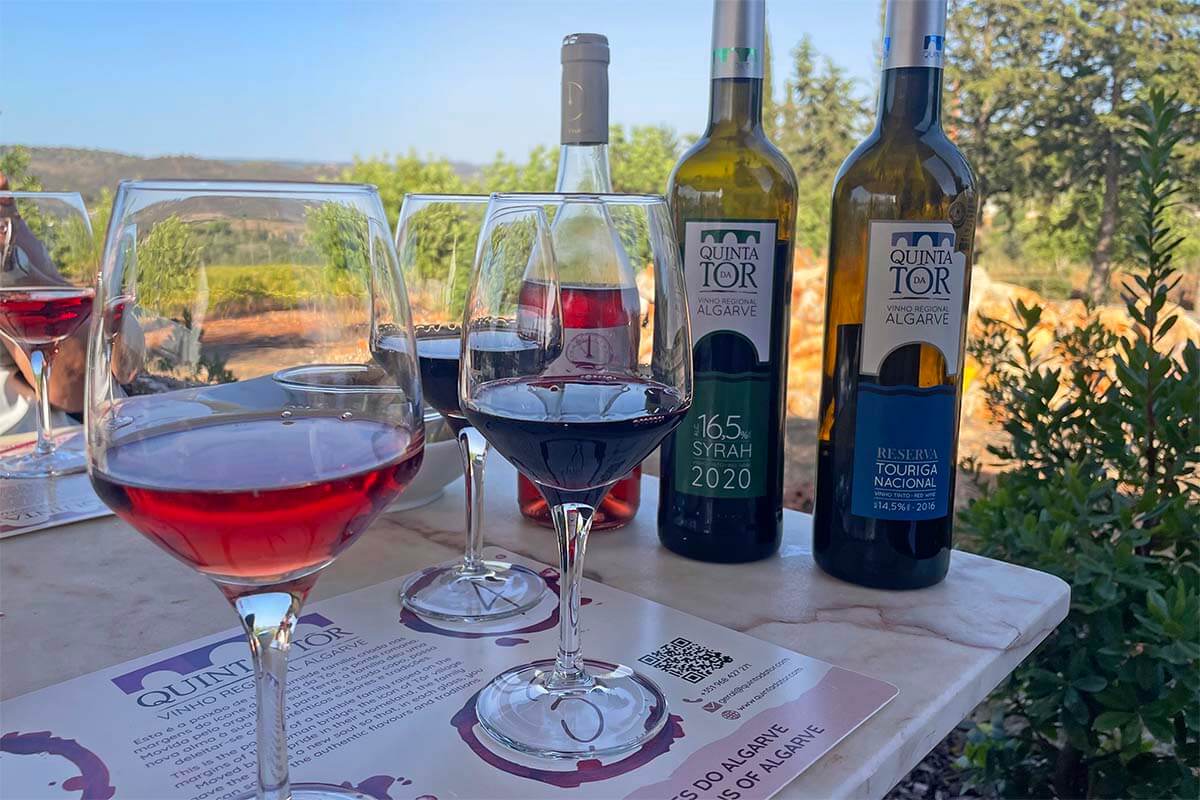
Where to Stay in Faro
While you don’t absolutely have to stay in Faro in order to explore the best of the city, it can also be a good base for sightseeing in the eastern Algarve.
Because of its proximity to the airport and good transport connections (also by train), Faro is also a popular place to stay for those who decide not to rent a car.
Here are some of the best-rated hotels in Faro:
€€€€€ 3 HB Faro – a modern 5* luxury hotel. €€€€ Hotel Faro & Beach Club – located in the heart of the old town, this mid-budget hotel offers great value (+ an amazing rooftop bar and pool!). €€€ AP Eva Senses – located at the Marina and just a few minutes walk from the station, this is one of the most popular hotels in the city. €€€ Roots Hotel – this highly-rated hotel offers a very good price/quality ratio. €€ Hotel Sol Algarve by Kavia – a very nice lower-budget hotel close to the station and the old town.
READ ALSO: Where to Stay in Algarve
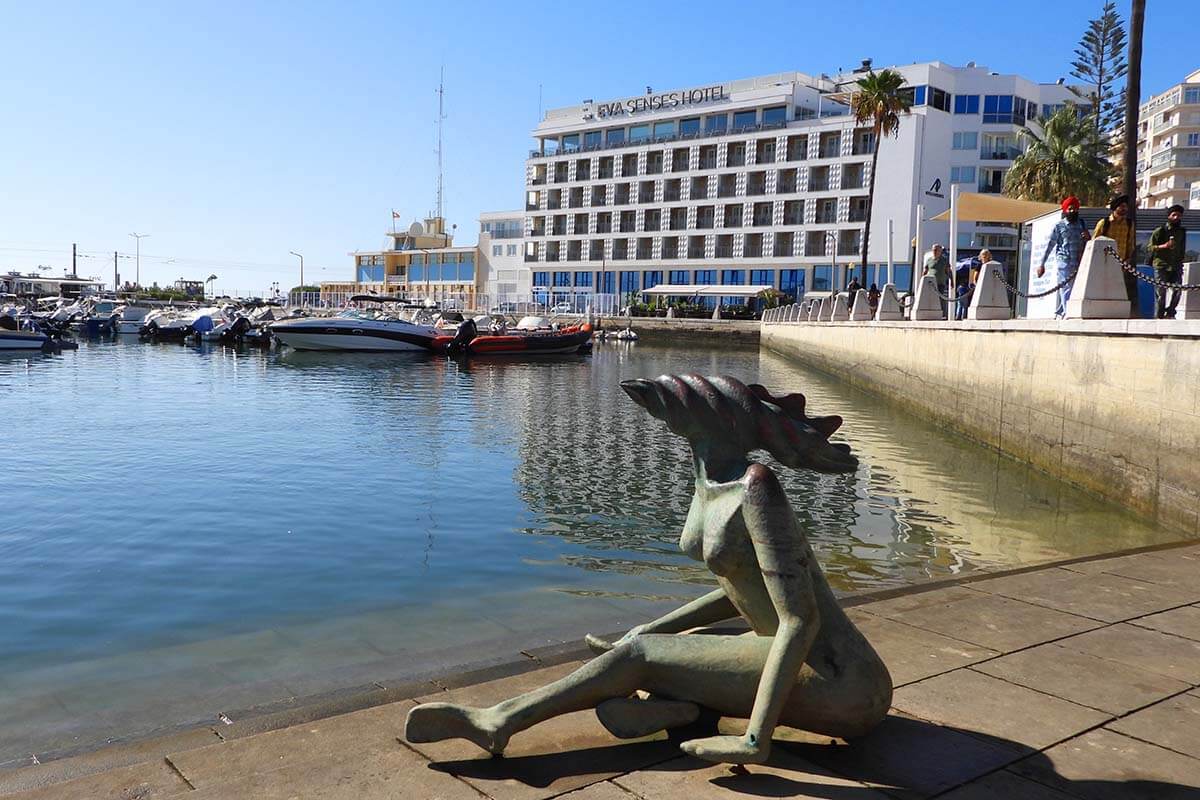

Where to Park for Sightseeing in Faro
If you are visiting Faro by car, you might be wondering where to leave your car. This highly depends on the season when you visit and parking can be a bit challenging in the old town. But in general, if you don’t mind walking 10-15 minutes from the main tourist areas, you can find some convenient parking areas and it shouldn’t be an issue. (We personally never had trouble finding a spot).
TIP: Be sure to check if you have to pay for parking before leaving your car. Many parkings are free, but some have a small fee (usually not even a euro per hour).
I indicated some of the best car parks in Faro on our map above. The parking at the Marina is very central but is not the easiest to get to (and some streets are quite narrow). For that, the area parking on the eastern side of the city walls (near the Church São Francisco) is better.
We also found the parking near Carmo Church very convenient and easy to get to. It was quite an entertaining experience too. Upon arrival, the guy issued us a ‘ticket’ with the entrance time written on it by hand and passed it to us via a long stick without having to get up from his desk. Unfortunately, by the time we got back from the sunset boat tour, he was long gone and there was nobody to collect the fees anymore…
I kept that hand-written ticket as a souvenir – see the picture below. Nowadays, when everything is automated and digitalized, travel experiences like this are becoming very rare. But you often remember these trivial things much longer than the churches or museums you saw that day…
Oh, and talking about fun travel experiences. We had a ‘day menu’ at one of the local restaurants in Faro where the owner didn’t speak a word of English. After the main meal, you could choose a dessert. I took the cake of the day and my mom thought she chose an orange cake. But they simply brought her an orange and a knife. It was absolutely delicious, but you should have seen her face. 🙂
My best tip is to embrace these quirky travel experiences rather than getting frustrated about things being different from what you expect. You’ll enjoy your trip to Algarve so much more if you just take things as they are.
READ ALSO: Algarve Travel Tips
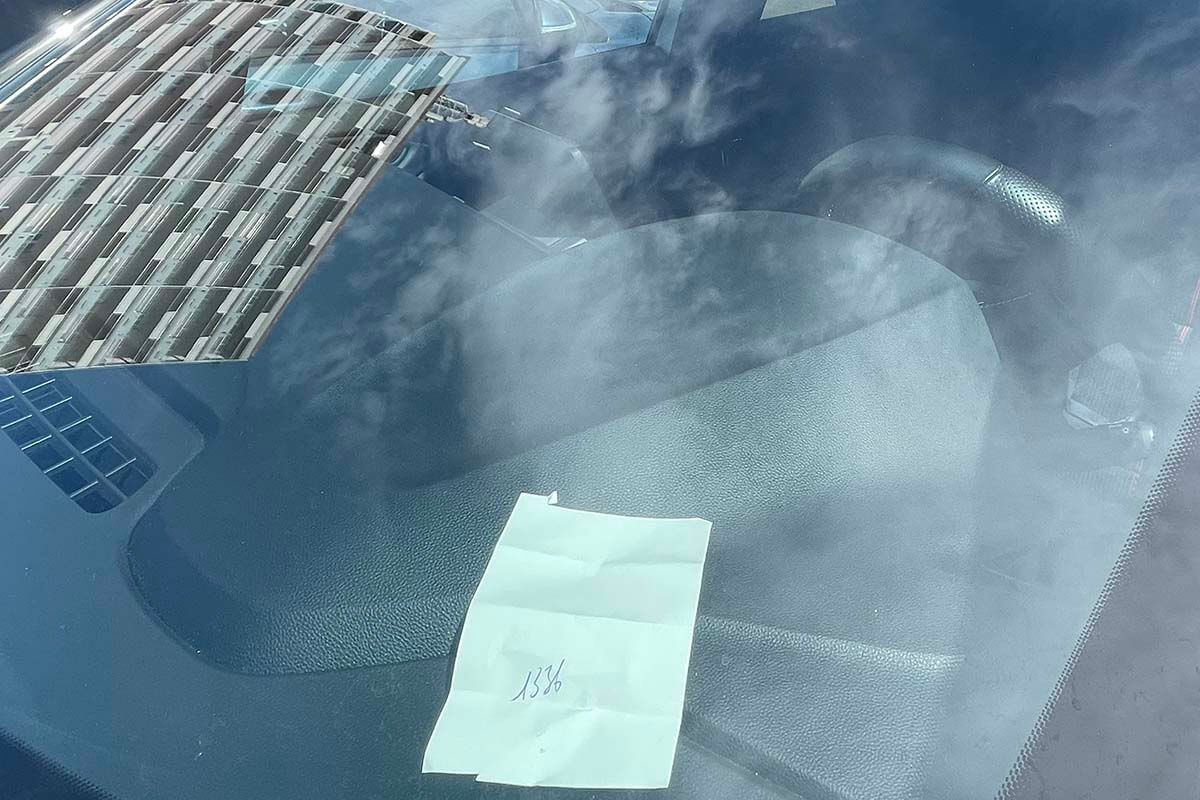
So, this is our guide to some of the best places to see and things to do in Faro.
I hope that this gives you a better idea of what to expect and make the most of your visit to the capital city of the Algarve. Have a great trip!
READ ALSO: Best Places to See & Things to Do in Algarve
More inspiration and tips for your trip to Algarve:
- Best Towns in Algarve
- Best Water Parks in Algarve
- Best Things to Do in Sagres
- Best Things to Do in Albufeira
- Best Beaches in Albufeira
- Best Things to Do in Lagos
- How to Visit Ponta da Piedade
- Kayaking at Ponta da Piedade
- Best Things to Do in Alte
- How to Visit Benagil Cave
- Seven Hanging Valleys Hike
- Best Places to Go Kayaking in Algarve
- Algarve in April
- Algarve in November
More travel inspiration for Portugal:
- Best Towns to Visit in Portugal
- Best Things to Do in Lisbon
- Best Day Trips from Lisbon
- Best Things to Do in Sintra
- Portugal 10-day Itinerary
- Best Things to Do in Madeira
- Best Things to Do in Funchal
- Best Things to Do in Sao Miguel, Azores
- For more destinations and tips, please see our Portugal travel guide .
If you found this post helpful, don’t forget to bookmark it and share it with your friends. Are you on Pinterest? Pin this image!
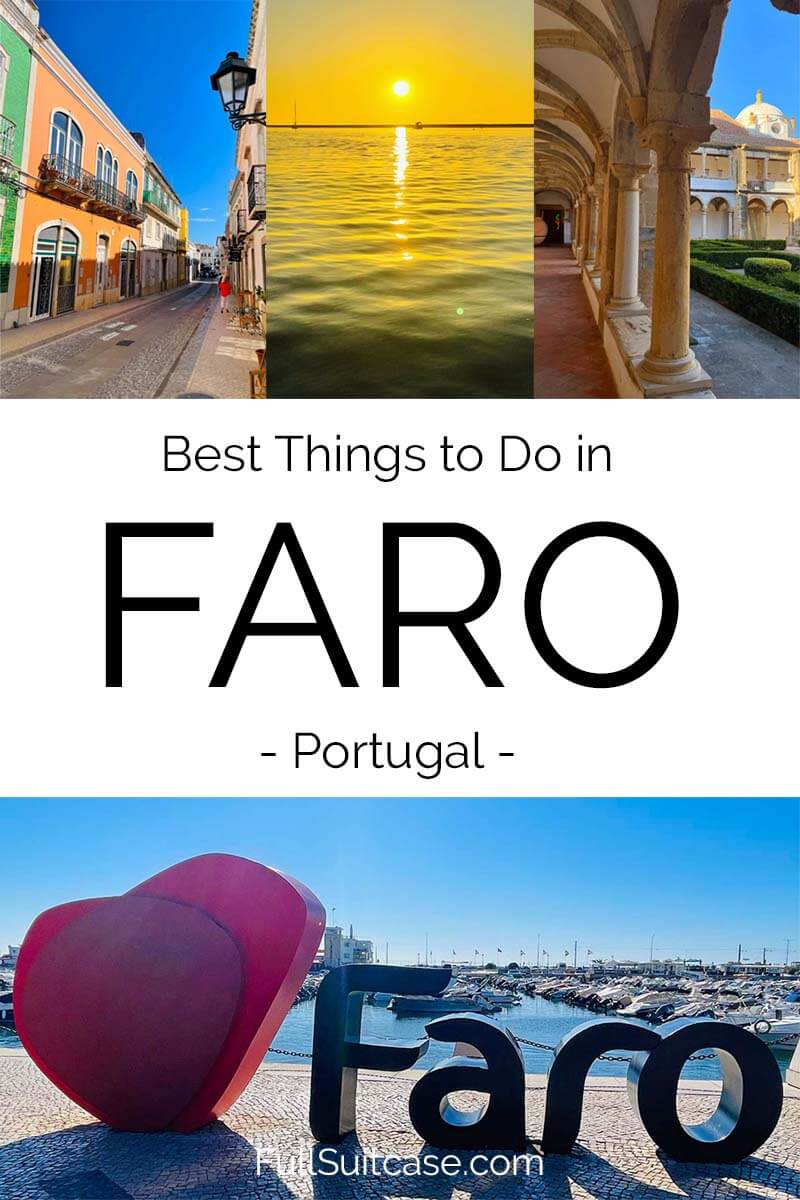
This site uses Akismet to reduce spam. Learn how your comment data is processed .

Home » Travel Guides » Portugal » 15 Best Things to Do in the Algarve (Portugal)
15 Best Things to Do in the Algarve (Portugal)
A soft climate tempered by the Atlantic, soft sandy beaches, mouth-watering cuisine, exhilarating coastal scenery; it’s no wonder that Portugal’s Algarve is one of Europe’s favourite holiday destinations.
We’ll run our finger over the best things to do in the Algarve, from unwinding on dreamlike beaches to exploring coastal caves, teeing off at some of Europe’s leading golf courses and getting lost in charming old towns.
We’ll also add some heritage to track down, like the Church of São Lourenço, decorated with exquisite blue tiles, or Faro’s monumental Arco da Vila gate.
Lets explore the best things to do in the Algarve :
1. Ponta da Piedade

The headland south of Lagos is nothing short of stunning.
The tortured limestone stacks and cliffs have a reddish tone and are honeycombed with natural arches and caves.
You can take the steps down to the clear water, which is completely protected by the rocks and has an enchanting emerald colour.
To experience it all you can gaze at the view from the headland, which stretches all the way to Cape St Vincent in the west and then head back to Lagos to board a motorboat for a voyage exploring the caves and creeks.
2. Praia da Falésia

Pushing on for almost seven kilometres is a golden sandy beach traced by cliffs streaked with various ochre hues.
The competition is stiff, but this may be the greatest beach in the Algarve and is also one of the longest in Portugal.
Those cliffs have a lot to do with it, as the combination of the pale sand, azure sea and russet red rocks make this a beautiful walking destination in the off season.
There’s a cliff-top path through pine groves and with panoramic views.
Come at sunset when the light is phenomenal.
3. Cape St Vincent

At this cape in Sagres you’ll be standing at the southwesternmost point in Europe.
Beyond geographical significance, it’s also a jaw-dropping setting, with cliffs 75 metres above the ocean and cinematic views of the rocky seascapes to the north and also to the east towards Sagres Point.
A ton of naval battles have been fought in the ocean off the cape, and there’s a lighthouse here, built in 1846 on the foundations of a derelict convent.
There are now a couple of gift shops, as well as a small but worthwhile museum about the cape and its history.
4. Praia da Rocha

Another awesome beach, Praia da Rocha combines the Algarve’s craggy coastal scenery with its pristine sands and rolling surf.
You can get to the foot of the strange rock formations for photos, and if you don’t mind the climb can follow the coast around to discover secret beaches framed by these hulking sculptured rocks.
The main stretch is a vast, low-shelving beach with consistent waves that surfers can ride.
Behind and to the east is the 17th-century Fort of Santa Catarina, designed by the Neapolitan military mastermind Alexandre Massai.
5. Church of São Lourenço

In Loulé there’s a Baroque church from the 18th century that you owe it to yourself to see.
If the whitewashed exterior is unassuming, the inside will just blow you away.
The walls and ceiling are completely clad with fabulous blue azulejos (traditional tin-glazed ceramic tiles) dating to the 1730s.
They are so extensive that the church is often called Igreja de Louça (Church of China). The tiles were crafted by Policarpo de Oliveira Bernardes, recognised as one of the masters of the art and depict scenes from the life of St Lawrence.
6. Algar Seco

Another spot to admire the Algarve’s gnarled red rock formations can be found in Carvoeiro, a little way east of the resort’s centre.
The ocean has eroded out the cliffs here to form little hollows, caves and small rocky outcrops.
There’s a boardwalk at the top of the cliff presenting you with some great photo opportunities of the grottoes being buffeted by the ocean.
More intrepid visitors can negotiate the steps that have been etched into the rock to get down for a better view of the caves.
7. Tavira Island

This is a long, narrow barrier island a few hundred metres off the city of Tavira.
You can get there by boat, which leaves from the city’s marina and nearby Quatro Águas, or cross the bridge at Santa Luzia and catch a tourist train that runs in the summer.
You’ll know why you made the crossing as soon as you arrive; the Blue Flag beaches on Tavira Island are out of this world, even by the high standards of the Algarve.
They go on for 11 kilometres and have a wide strip of soft white sand bordered by dunes.
8. Dolphin Watching

At all of the main marinas along the Algarve you’ll see ocean boat trips advertised.
There’s deep sea fishing for instance, but the experience you’ll really treasure is dolphin spotting.
There are large numbers of common and bottlenose dolphins in the ocean off the Algarve, so you’re almost guaranteed to have a successful expedition.
This is also made easier by the creatures’ inquisitive nature, and before you know it pods of up to 50 will be keeping you company.
The best companies bring a marine biologist along to give you added insights about the dolphins habits and physiology.
9. Lagos Old Town

The historic centre of Lagos is a joy to roam through.
It is encircled by large chunks of its old walls, which were updated in the 1500s on top of much older Moorish defences.
Between the 16th and 18th centuries Lagos was the capital of the Algarve, and you’ll be aware of its status at the town’s museum, which has hundreds of years or artefacts including coins dating to the 4th century.
You can devote the rest of your time to just ambling around the narrow cobblestone streets, happening upon historic buildings like the 15th-century slave market (Lagos was once the centre of Europe’s slave trade) and the Baroque Church of Santo António, which is also festooned with blue azulejos.
10. Arco da Vila

In 1812 one of Faro’s Moorish waterfront gateways was given a Neoclassical update.
It was commissioned by Francisco Gomes de Avelar the Bishop of Faro and drawn up by the Italian architect Francisco Xavier Fabri.
There’s a belfry (crowned with a stork’s nest), clock, balustrade and in an alcove above the portal is a statue of Thomas Aquinas hewn from marble.
And as you walk through the portal you’ll still be able to see traces of the original Moorish stonework.
It’s quite a thrill to know that you’re treading the same path as hundreds of years-worth of visitors to the city.
11. Forte de Nossa Senhora da Rocha

Capping a promontory near Lagoa is a fortified enclosure that dates back to before the arrival of the Moors in the 8th century.
There isn’t much evidence of the fortress as it was pulled down in the 19th century, but you will find an old hermitage with a terracotta tile roof.
The whitewashed walls and cliff-top position create an almost ethereal scene.
You can peek through the gates of the chapel or bask in the majestic ocean vistas and look down at the neighbouring Praia Nova and Praia da Senhora da Rocha beaches.
12. Monchique

So far nearly everything has been on the coast, but the Algarve has an extensive inland region.
This is most picturesque around the Serra de Monchique, a mountain range acting as a buffer between the Algarve and Alentejo to the north.
This includes the Pico da Foia, which at just over 900 metres is the tallest mountain in southern Portugal.
Outside the summer Monchique is the best place in the region for walks, in cool hills coated with strawberry trees.
One hillside above the town has the remnants of a 17th century convent, while the centre of Monchique is also a joy for its cobblestone streets and whitewashed houses with colourful window and doorframes.

Up to the 1960s the game of golf was practically unheard of on the Algarve.
Fast forward 50 years and it’s a very different story.
This is up there with the best golfing destinations in Europe.
Considering the size of the region, the choice is unbelievable: There are 42 courses at 35 different clubs, so it’s fair to say that wherever you are in the Algarve you’ll never have to travel far for a round.
A few of the best to keep in mind are Oceanico in Vilamoura, Palmares near Lagos, Quinta da Ria and the pair of innovatively designed courses at Quinta do Lago.
14. Waterparks

These are always obligatory if you’re holidaying with children, and fortunately the Algarve has a few waterparks competing with the best in Europe.
Side & Splash in Estômbar is the largest in Portugal, and one of the largest on the continent, with 16 slides and pools and almost two hectares of open grassy areas for sunbathing.
Aquashow Park in Quarteira is maybe for older children as some of the slides are not for the faint-hearted, like FreeFall, the highest slide in Europe at 32 metres.
Zoomarine Algarve meanwhile has an animal park with live shows together with its new “Beach” area with a wave pool, fine white sand and waterslides.
15. Algarve Food and Drink

On the Atlantic it will come as no surprise that the fish and seafood is divine in the Algarve, whether it’s crab, oysters, squid or a shellfish medley in rice dishes.
But the fish that shows up the most is the humble sardine, which is just right grilled and served with salad and a white wine.
Chicken piri-piri is another star; it’s barbecued chicken marinated in a sauce made with the piri-piri chilli, which was first imported by Portugal from its former colony in Mozambique.
For an authentic accompaniment to your morning coffee you can grab a pastel de nata at a bakery.
This is a tasty custard tart flavoured with almonds.
15 Best Things to Do in the Algarve (Portugal):
- Ponta da Piedade
- Praia da Falésia
- Cape St Vincent
- Praia da Rocha
- Church of São Lourenço
- Tavira Island
- Dolphin Watching
- Lagos Old Town
- Arco da Vila
- Forte de Nossa Senhora da Rocha
- Algarve Food and Drink

14 Top-Rated Attractions & Places to Visit in the Algarve
Written by Paul Bernhardt Updated Dec 22, 2023 We may earn a commission from affiliate links ( )
The Algarve is Portugal's southernmost region, and one of the most popular vacation destinations in Europe. Blessed with a superb coastline and some of the country's loveliest beaches , the province enjoys hot, dry summers and short, mild winters. Warm sea temperatures and gentle winds add to its allure.
The Algarve is a land of contrast, and there's plenty of things to do. More than fifty percent of all visitors to Portugal spend their holidays here. The popular and more developed central region offers lively coastal resorts, first-rate tourist amenities, and some of Portugal's best golf courses .
Farther east, a string of sandbar islands and lagoons form part of a beautiful and protected natural park, and a distinctly Spanish atmosphere pervades the border towns and villages. Over to the west, a very different Algarve beckons. Wilder and more remote, this is a place to escape the crowds and where surfers seek communion with a restless Atlantic Ocean.
For more sightseeing ideas, see our list of the top attractions and places to visit in the Algarve.
2. Vila Real de Santo António
3. alcoutim, 7. vilamoura, 8. albufeira, 10. portimão, 11. serra de monchique, 14. the west coast, tips and tours: how to make the most of your visit to the algarve, map of attractions & places to visit in the algarve, exploring more of the sun-soaked algarve.
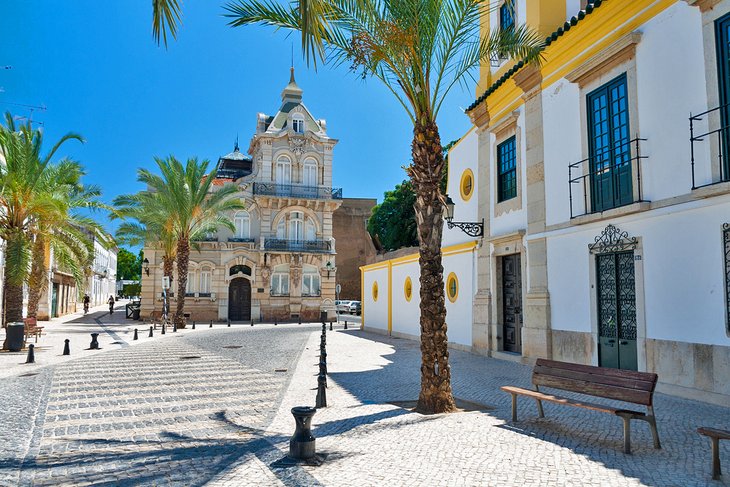
Busy Faro is the capital city of the Algarve, and its international airport is the gateway for many tourists arriving in southern Portugal. As the largest city in the region, Faro accommodates around 50,000 inhabitants and is a modern industrial and manufacturing hub.
It is the Old Town , however, that sightseers will want to visit. Enclosed by sturdy defensive walls, Faro's Cidade Velha sits on Roman and Moorish foundations. The town was badly damaged by the great earthquake of 1755, and what you see today dates mostly from the 18th and 19th centuries.
A warren of cobblestone streets and leafy squares surround the landmark cathedral . Explore farther, and you'll find a number of cafés and restaurants tucked discreetly between rows of tidy houses and artisans' workshops. An excellent museum exhibits treasures unearthed in the area and further afield.
The nearby esplanade harbors a small marina, beyond which lies an expanse of lagoons and wetlands teeming with marine life. This beautiful natural park is also composed of numerous islets and enormous sandbars with their own fabulous beaches , including one named after the city.
- Top-Rated Tourist Attractions in Faro
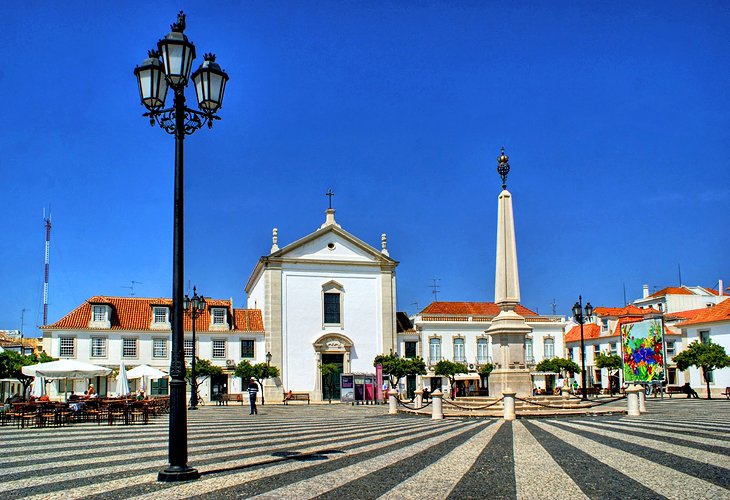
You're as likely to hear Spanish spoken here as Portuguese for this is about as near to Spain as you can get without actually crossing the frontier. Indeed, the shops and markets of Vila Real de Santo António are geared towards visiting Spaniards, but this pleasant border town also has a number of tourist attractions worth investigating.
The excellent Arquivo Histórico Municipal on Avenida da República chronicles the region's almost vanished sardine and tuna canning industry with a spirited interactive exhibition that's free to visit.
The handsome main square, Praça Marques de Pombal , features an eye-catching mosaic sun burst radiating from a central obelisk and is ringed by orange trees and plenty of inviting cafés and restaurants. A fun-filled diversion is to take the ferry from the quay near the marina to the Spanish border town of Ayamonte , with its colorful tapas restaurants and traditionally styled delicatessens. The ferry, which also carries cars, takes around 20 minutes to cross the River Guadiana.
A 10-minute drive north of Vila Real is the spruce village of Castro Marim , which is dominated by an imposing 13th-century castle . Open to the public, its massive ramparts afford fine views over the surrounding coastal Reserva Natural do Sapal nature park.
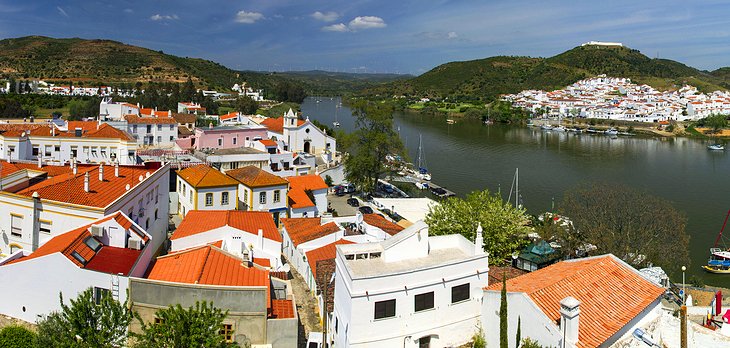
The eastern Algarve's barren and sparsely populated interior is rarely visited, and for the most part remains well off the tourism map. But some 40 kilometers north of Vila Real is the wonderfully scenic border village of Alcoutim.
The drive alone is worth the detour. Rather than using the IC27 dual carriageway, follow the road that hugs the Guadiana River , a broad, meandering waterway that provides a natural border between Spain and Portugal. A smudge of whitewash announces this riverside gem, and the tiny hamlet looks as though it has been created from the imagination of an exceptionally talented artist.
Once a strategic river port controlled in turn by Greeks, Romans, and, notably, Arabs, Alcoutim later played a role as the setting for the peace treaty signed in 1371 between King Fernando I of Portugal and Enrique II of Castile.
It's still a sleepy and tranquil Alcoutim that greets visitors today. The best way to begin sightseeing is by exploring the 14th-century castle (the entrance fee includes access to a small archaeological museum by the main gates). The castle walls afford stunning views of the vicinity and take in the Spanish village of Sanlúcar de Guadiana , set on the opposite bank of the river.
A regular ferry service shuttles between the two villages, but there is an alternative and absolutely exhilarating way to cross the river. On the Spanish side, high above Sanlúcar, is the only cross-border zipline operator in the world. As well as speeding from one country to another, you also cross a timezone - there is a one-hour time difference between Spain and Portugal.
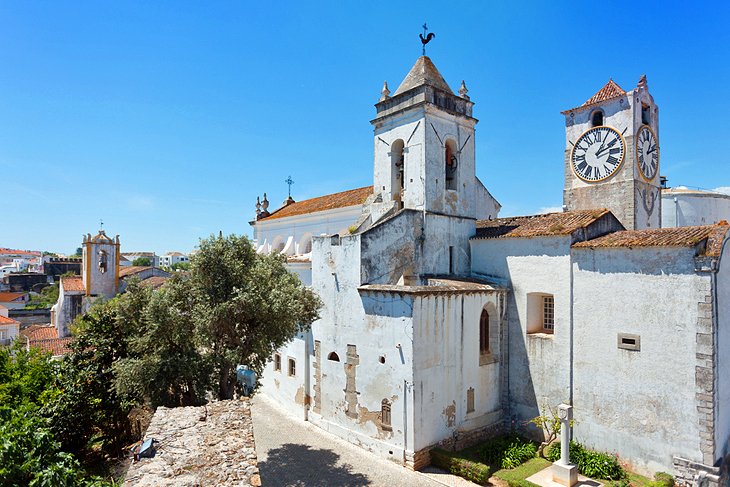
Near the coast in the eastern Algarve, Tavira is one of the region's prettiest towns. Sited on both sides of the broad River Gilão , this is a destination celebrated for its historical legacy, a past shaped by the Romans and later by the Moors, whose settlement by the river was topped by a castle , still visible today.
The hipped roofs that define much of Tavira's architecture are unique to this part of the Algarve. So, too, is the number of churches - 21 in all - that embellish the old town. Straddling the river is an elegant bridge , built in the 17th century on Roman foundations.
An amble along the riverfront is one of the best ways of appreciating Tavira; the palm-lined gardens are flecked with color in the summer months, and a nearby market brims with fresh fruit and vegetables.
Ferries depart from the quay to the Ilha de Tavira , a favorite destination for sun seekers and one of the few islands in the area where camping is permitted. Alternatively, you can join a sightseeing cruise along the Ria Formosa , a beautiful and unspoiled waterway and part of a protected natural park.
- Top-Rated Tourist Attractions in Tavira & Easy Day Trips
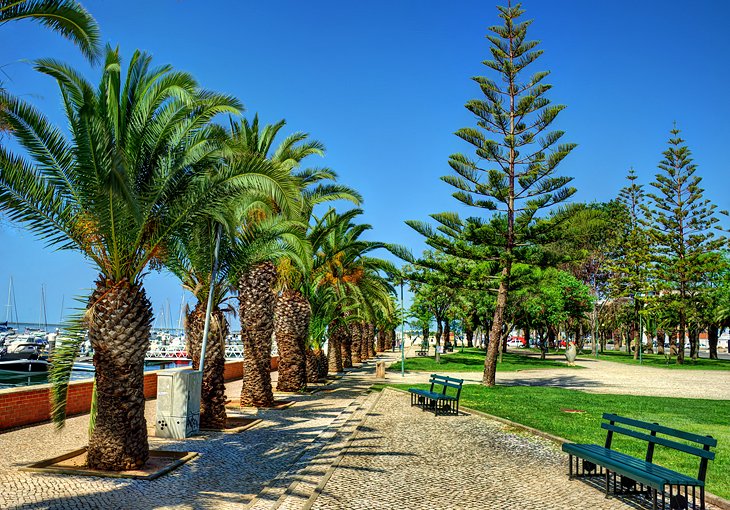
The Algarve's busiest fishing port, Olhão is all about the ocean, and some of the best seafood restaurants in the region are on Avenida da República , the town's vibrant thoroughfare.
Another reason for paying Olhão a call is to browse its incredible harbor front market - the biggest and most animated on the coast. Open at daybreak, the fish market is filled to the gills with an extraordinary array of produce, sleek and silver, and the freshest you're ever likely to taste. Complementing this Atlantic harvest is a rural riot of just-picked fruits and vegetables, a farmer's choice of delicious country fare.
While it radiates a palpable North African atmosphere with its casbah-cluster of whitewashed flat-roofed houses, Olhão is bereft of any major tourist attractions. However, the waterfront town is a great base from which to explore the pristine Parque Natural da Ria Formosa . Visitors can follow a wonderful network of nature trails and discover a wealth of wildlife within its various habitats.
For others, it's Olhão's proximity to the fantastic near-deserted sandbar islands of Armona , Culatra, and Farol that lures them to this particular pocket of Portugal.
- Top-Rated Tourist Attractions in Olhão
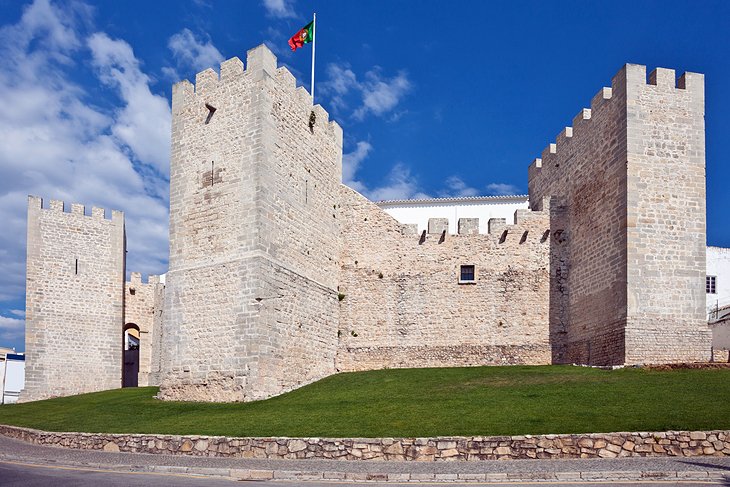
Far from the coast, Loulé is a busy market town of singular character and a fascinating past. The town is best known for its covered fruit and vegetable market , one of the busiest and most entertaining in the Algarve. The sprawling collection of stalls, cabins, and kiosks are arranged in a late 19th-century red-domed building with distinctive horseshoe-shaped windows. On Saturday mornings, the market spills out into the surrounding streets when farmers from outlying districts come to sell their crops.
Loulé has always been a lively commercial hub. The Moors built on Roman foundations to create a thriving center of commerce and constructed a castle here in the 12th century to protect their interests. You can walk the ramparts for fine views over the old town, and there's a small museum set within the grounds.
Arab influence is everywhere. Wander Loulé's backstreets, and you'll discover the ruins of an Islamic bathhouse , the hammam de Al-'Ulyà . In the beautiful 16th-century Capela Nossa Senhora da Conceição , decorated with stunning azulejos tiles, part of the floor reveals the foundations of a 12th-century Moorish house . Explore further, and you'll stumble upon the Igreja Matriz de São Clemente . The church's lofty bell tower originally served as a minaret.
About 25 kilometers northwest of Loulé, Alte is a picturesque village snuggled in the foothills of a mountain range and dotted with flower-filled gardens. To absorb the town's quaint local color, sightseers can stroll along the narrow cobbled streets with their charming white-washed houses or relax at one of the many cafés.
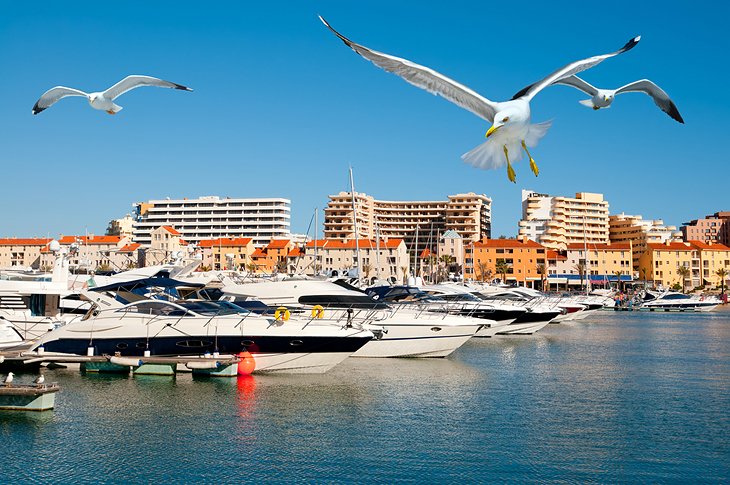
No less than five championship golf courses cluster in and around Vilamoura, making this upmarket coastal resort a favorite with those who want to practice their swing or improve their handicap. Some hotels offer their guests preferential green fees and other inducements such as free shuttle services to and from the clubhouses.
Vilamoura is also synonymous with Portugal's largest marina facility, which offers 825 berths and can accommodate vessels up to 60 meters in length. The esplanade is lined with designer boutiques and pricey restaurants, and is fabulous for people watching, especially in August when Lisbon's jet set tread the boards clad in their designer best.
This is a family-friendly destination with plenty of activities for kids. The boardwalk is the jumping-off point for coastal cruises and other water sports activities, and you can hire pedalos on the sand at Praia da Marina . Elsewhere, the family golf park is an 18-hole mini-golf layout themed around ancient Rome.
Actually, the Romans were here, and the area features the ruins of a 2nd-century villa complex, Museu Cerro da Vila , complete with sunken baths, salt tanks, and striking mosaics.
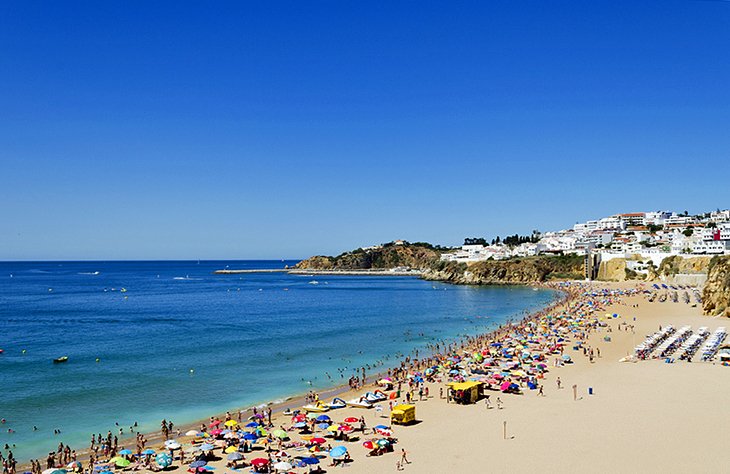
Albufeira is the destination of choice for many Algarve holidaymakers. Its central location on the coast of southern Portugal makes it one of the region's most accessible resorts, and it's a favorite with tourists from across Europe and beyond.
Set on sandstone cliffs above a wide sandy bay, the Albufeira of old was once a quiet fishing village, nothing more than a cluster of whitewashed cottages, a chapel, and a church. Step back further, and it was the Romans who built a castle here, strengthened later by the Moors .
Little remains of their presence, but what Albufeira lacks in historical interest it more than makes up for with its animated spirit and vacation-time atmosphere. The resort's neon-lit streets illuminate a plethora of hotels, cafés, restaurants, and entertainment venues. Top-notch leisure facilities exude an all-round appeal, and Albufeira is often the preferred choice of families.
But the destination's biggest crowd-puller is its beaches . Some of the best stretches of sand in the Algarve are within walking distance of the resort, spectacular cliff-backed coves lapped by warm, shallow water. This is why Albufeira is the tourist capital of the Algarve.
- Top-Rated Tourist Attractions in Albufeira
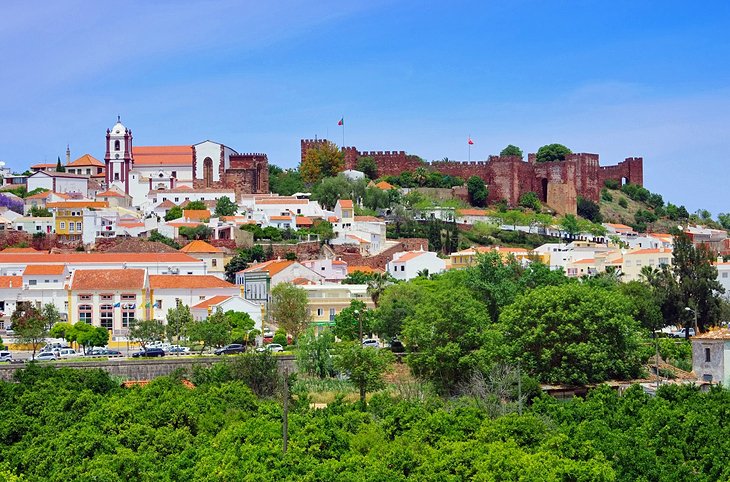
Lying across a hill overlooking a fertile valley embroidered with orange groves, olive trees, and vineyards, Silves is one of the most scenic towns in the Algarve. The landscape, however, is dominated by the town's splendid castle - the grandest monument to Islamic rule in the region.
Built by the Moors in the 11th century on Roman foundations, the castle's dramatic profile is enhanced by its copper-red walls, sections of which extend into the town below. This was Xelb , the Moorish capital of the al-Gharb ("the west"). Another fine example of Islamic presence can be seen in the Museu Arqueológico , where the star exhibit is an impressive Arab water cistern with an 18-meter-deep well.
Silves is worth exploring at leisure. Downhill from the fortress is the Sé (cathedral), built between 1242 and 1577 on the site of Xelb's Grand Mosque. Opposite is the 16th-century Igreja da Misericórdia , replete with a fine Manueline side door.
The town itself is delightful, especially the area along the riverfront, which is lined with a small market and some excellent restaurants. Cruise boats from Portimão tie up here near the old bridge.
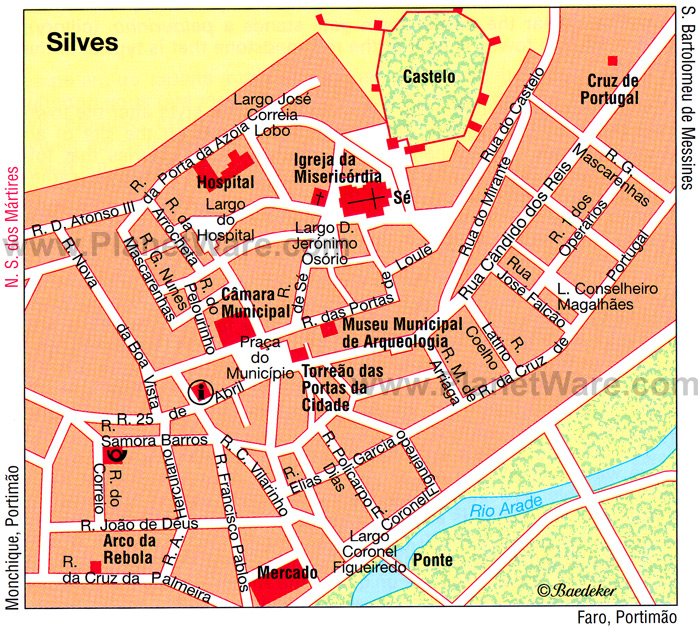
Historically associated with the Algarve's once thriving cannery industry, Portimão has successfully reinvented itself as a destination for tourists who prefer to stay in an urban setting yet remain within shouting distance of a beach resort environment.
The region's second largest city, Portimão enjoys an enviable location overlooking the banks of the River Arade . Endowed with an award-winning museum and a noted theater complex, the city is basking in its reputation as one of the region's liveliest cultural hubs. It's also an international port of call for luxury cruise ships en route to the Mediterranean.
An eclectic choice of tourist attractions and amenities is close at hand. The award-winning Museu de Portimão is one of the region's most engaging visitor attractions . Housed in a former cannery building, the museum chronicles the history of the town's fishing and canning traditions using state-of-the-art interactive effects. Also on display are rare artifacts from pre-historic, Roman, and Islamic periods.
Offshore, a fabulous artificial reef - the first in Portugal - attracts diving enthusiasts from around the world. Inland meanwhile, a Formula 1-standard racetrack hosts sports car championships and other high-profile competitions.
A modern marina set at the mouth of the estuary is within walking distance of one of the Algarve's most famous beaches, Praia da Rocha - a beautiful and alluring stretch of golden sand that fronts the lively tourist resort of the same name.
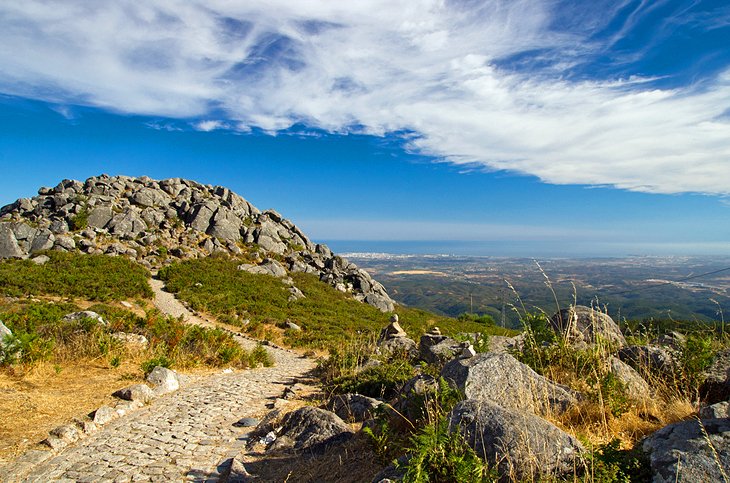
Offering an alternative to the Algarve beach scene is the Serra de Monchique, a rolling mountain range that adds a dramatic perspective to the region's western countryside. Skirted by fragrant meadows of wildflowers, Monchique's slopes bristle with chestnut and eucalyptus, the verdant habitat sustaining an abundance of wildlife.
A network of nature trails snake through the shady woodland; one leads all the way to Fóia , at 900 meters the highest point in the Algarve. On a clear day, the spectacular panorama embraces the region's entire western landmass including Lagos and Sagres, and the Atlantic Ocean beyond.
The pleasant hill town of Monchique is an excellent base from which to explore the area and is noted for its traditional handicrafts: look out for the cadeiras de tesoura , the x-shaped folding wooden chairs based on an ancient Roman design.
And it's the Romans who first took advantage of the warm, curative waters that nourish Caldas de Monchique , a charming spa tucked away in a wooded ravine in the foothills of the Serra. Set around a cobbled square furnished with a restaurant, café-art gallery, and bed and breakfast accommodation, the modern thermal spa offers a tantalizing menu of therapeutic treatments and rituals.
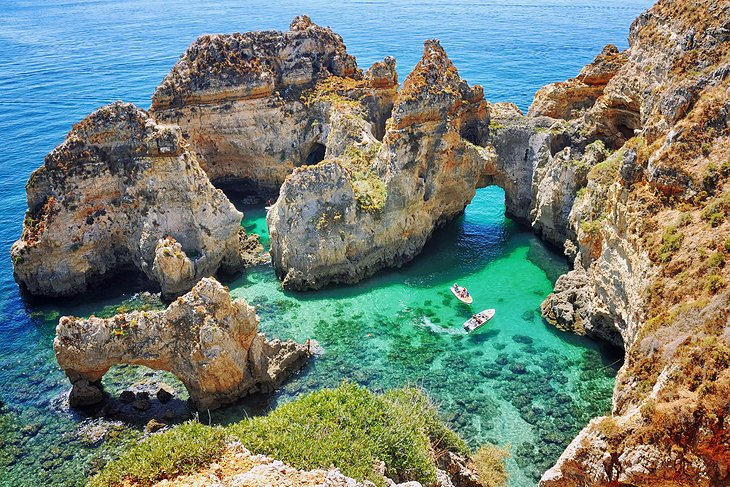
Lagos is the western Algarve's liveliest resort town. It's also of great historical significance. Prince Henry the Navigator launched Portugal's Age of Discovery from Lagos in the 15th century, and the nobleman later became governor of the Algarve. His extraordinary vision, and the bravery of the intrepid explorers who set sail for uncharted waters, helped place Portugal on the world map, and Lagos is proud of its seafaring heritage.
The town's medieval collection of castle walls, graceful churches, and stout sea defenses always captures the imagination of visitors, but it's the coastline that lures holidaymakers. A stunning run of cliffs, caves, and grottoes provide the backdrop to some of the most scenic beaches in the Algarve. A series of spectacular ochre-splashed rock formations contrasts with sparkling azure waters, and the best way to appreciate this idyllic environment is by boat - Lagos's extensive tourist attractions and activities extend to sightseeing cruises and dolphin safaris .
Shopping here is good and inexpensive, and a wide choice of cafés and restaurants provide plenty of culinary distraction.
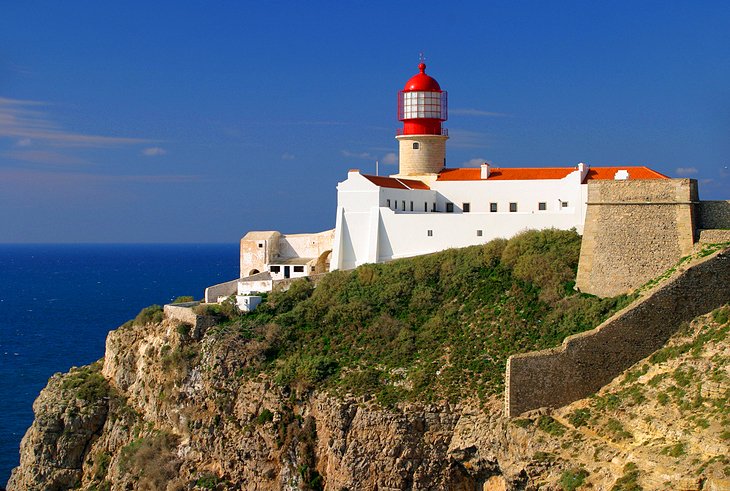
Around 120 kilometers west of Faro, Sagres, continental Europe's southwesternmost community, basks in glorious isolation and is the Algarve's least developed coastal resort. It was here that Prince Henry the Navigator (1394-1460) is believed to have established a school of navigation on a windswept promontory near the town, thus heralding Portugal's remarkable period of maritime exploration.
The chunky walled Fortaleza seen today dates from the 17th-century, but inside the walls, you'll see a giant pebble wind compass, the Rosa dos Ventos , said to have been used by Henry. The adjacent 15th-century chapel of Nossa Senhora da Graça was certainly built on his orders.
Ancient Greek chroniclers described nearby Cabo de São Vicente as "the end of the inhabited earth," such is the austerity of this stark, windblown cape. The lighthouse serves as a navigational beacon, not just for shipping, but also for thousands of migrating birds, and there's a bird-watching festival here every October.
The town itself wakes up in summer to welcome a predominantly young crowd drawn to inexpensive accommodation, simple restaurants, and proximity to some truly fantastic beaches.
Sagres is Europe's surfing capital , and the destination hosts legs of the World Surfing Championships.
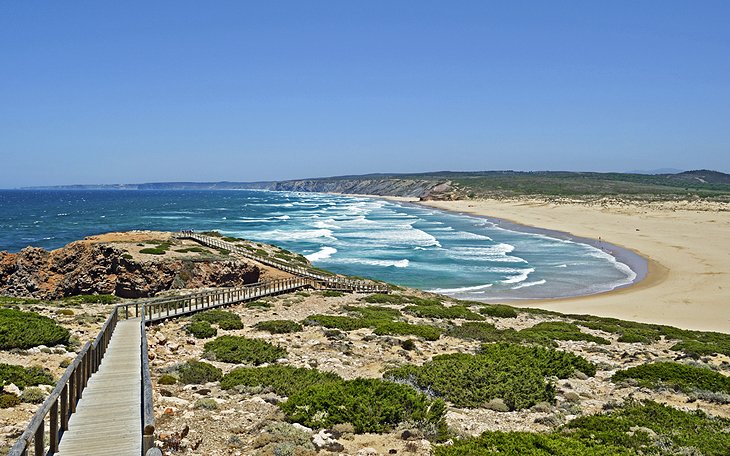
Precipitous sea cliffs, wide-open beaches, and a restless Atlantic Ocean define the character of the Algarve's west coast. Devoid of development, this remote and untamed stretch of coastline is the preserve of the more spirited traveler. Surfers worship the region, drawn by the outstanding rollers that crash onto Praia da Bordeira , Praia do Amado , Praia da Arrifana, and other sandy arenas. Surf schools abound, with many offering free transfers from Faro airport.
Traditional villages untouched by tourism dot the landscape, places like Carrapateira and Odeceixe . Accommodation is scarce, and very often it's the humble campervan that prevails. Unfussy restaurants serve succulent grilled fish and other delicious seafood dishes.
The entire region falls within the boundaries of the Parque Natural do Sudoeste Alentejano e Costa Vicentina , and you can follow a number of footpaths, both inland and along the coast, that showcase its wild and rugged scenery. For a worthwhile cultural diversion, head for the lively town of Aljezur and visit the ruins of an 11th-century Moorish castle , set on a hill with uninterrupted views of the valley below.
Numerous Algarve tours and activity options are available on land and sea, many running throughout the year. These organized tours include expert guides, so you can learn more about the destination while you see the sights.
- Sightseeing by Boat: A popular maritime pursuit is the Kayak and Snorkel Trip in Lagos , a guided excursion along the Atlantic coast. This active three-hour tour delves into sea caves and ancient grottoes for a different perspective of the Algarve. If you prefer not to paddle, the Ria Formosa Natural Park 4 Islands Boat Trip is an excellent choice. Departing Faro, this 4.5-hour tour is conducted at a leisurely pace aboard a 12-person catamaran through one of the most beautiful marine reserves in Europe.
- Sightseeing by Bike: Take a four-hour cycle through the beautiful countryside, past small towns, farmland, and coastal scenery. This Small-group Bike Tour can be tailored to suit your fitness level.
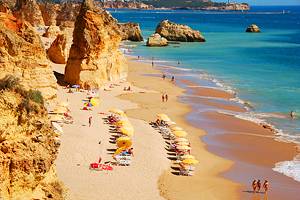
To fully appreciate the Algarve's unique allure, study our Portugal itineraries page for ideas on where to go and what to see . Top tourist attractions in the region include a number of historic castles and world-class golf courses . Several of Portugal's most modern and luxurious beach resorts are found here and of course, the Algarve is renowned for its wide choice of fantastically picturesque beaches .
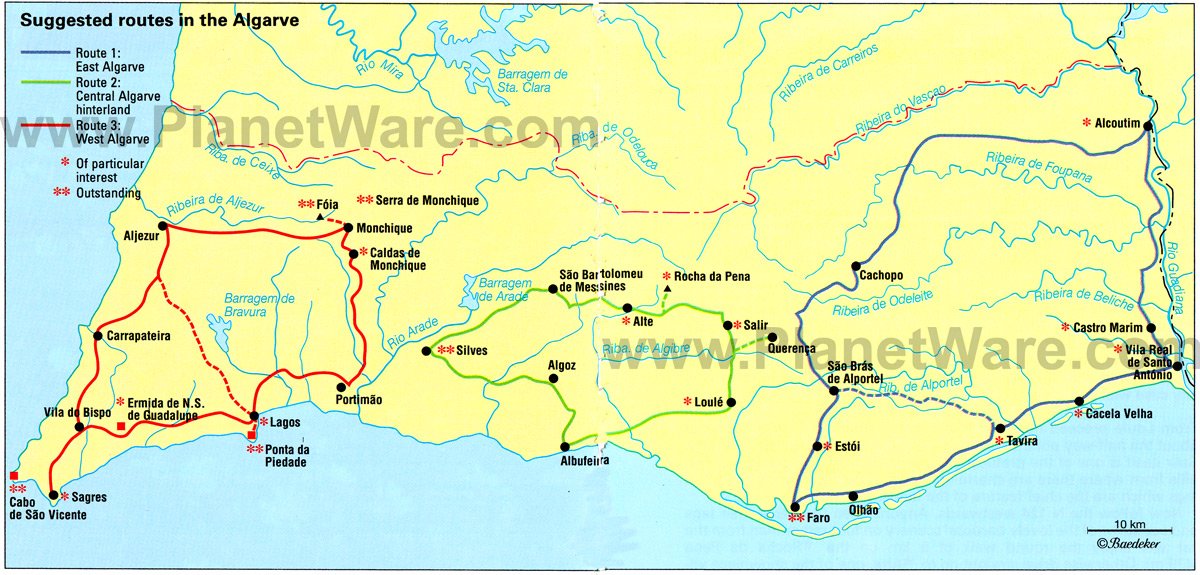
More on Portugal
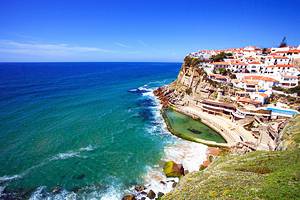
Algarve Tourism Guide
Essential algarve tips, trip planner and complete accommodation guide.
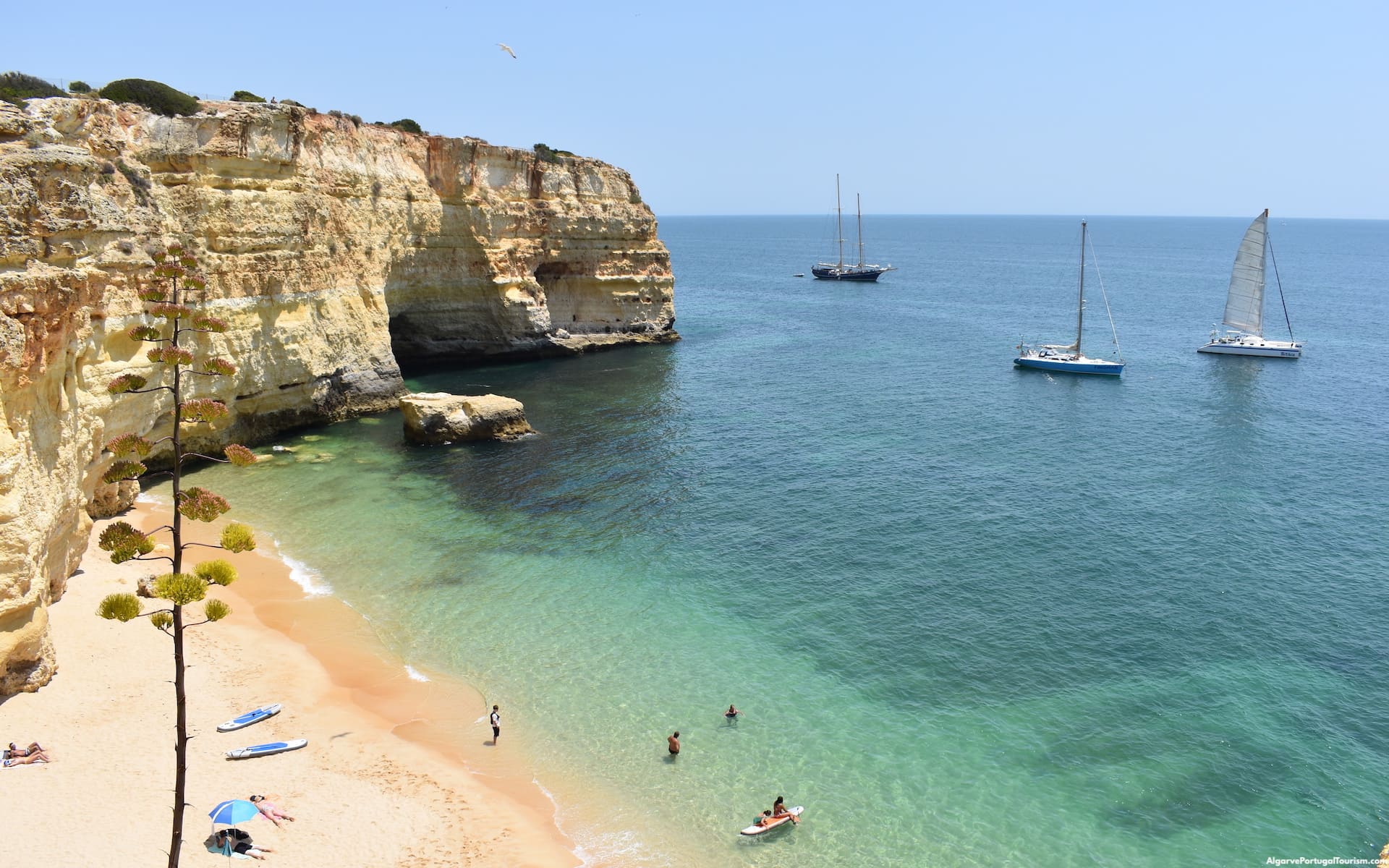
S un-worshippers from all over Europe come to the continent’s southwestern tip for some of its most beautiful beaches , magnificent cliff scenery , fantastic grottoes , world-class golf courses and luxury or family-friendly resorts. Algarve is Portugal’s most visited region, but while it’s a top summer destination for Europeans, it remains a place to be discovered by everyone else. This makes it Europe’s most famous secret, as it’s officially promoted.
Visitors find beaches of every type here -- from people-packed bays with magnificent rock formations to secluded coves, dune islands with golden sand stretching as far as the eye can see, and wild, remote and nearly deserted stretches backed by breathtaking cliffs for nature lovers (and naturists). The waters are shallow and calm for swimming or have the perfect waves for surfers (novices and pros alike). The entire coast is very clean, as certified by the Blue Flag flying at almost every beach.
This was considered the edge of the Earth before sailors ventured into the unknown during Portugal’s golden age of exploration, and there’s something thrilling about standing on what was once considered the end of the world . Windswept capes and pristine landscapes still make it feel that way today, giving it a romantic atmosphere. Although one of the most devastating earthquakes in history destroyed almost everything in the region in 1755, it preserves exotic and traditional architecture , and there are historic sites worth exploring. Then there are the reasonably-priced resorts, the golf, the water parks and surfing that made it a hotspot, and you have a destination for all types of travelers, of all ages and tastes, who want to return time and again.
Algarve Travel Planner
Helpful insider tips to plan the perfect days in the region:.
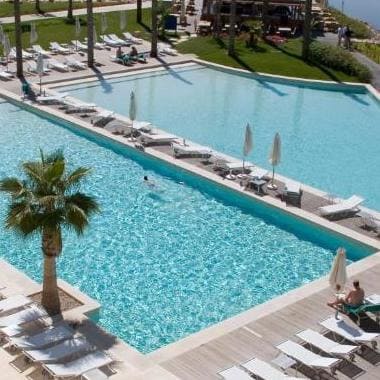
Where to Stay The Best Areas and Hotels
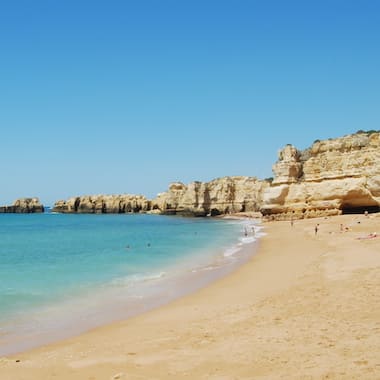
The Best Beaches Choose the Right Beach For You
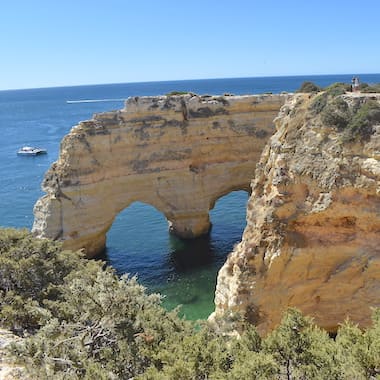
Top 10 Attractions The Best Things to See and Do
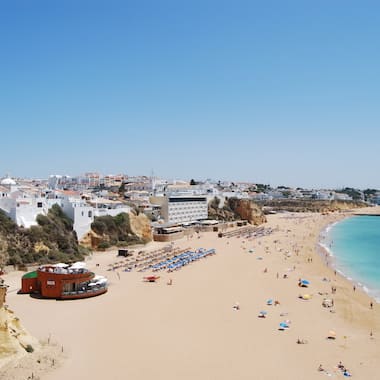
Top 10 Destinations The Best Cities and Villages to Visit
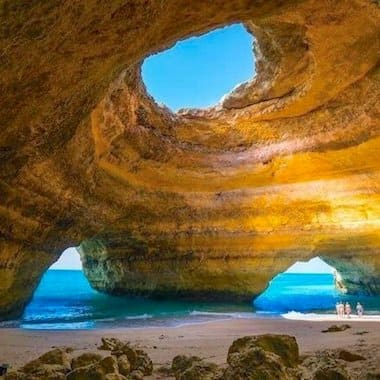
The Best Caves Must-See Natural Wonders
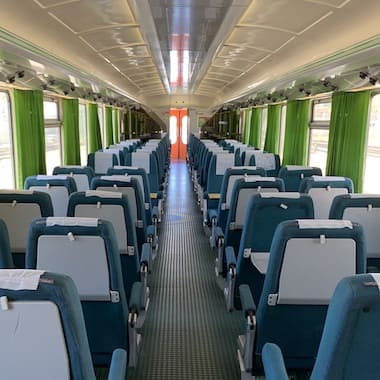
Transportation Guide How to Get There and Around
Which part of algarve is best.
The Algarve region could be divided into three sub-regions -- the east, central, and western Algarve. Each offers a different experience, so where you go depends on what type of holiday you want to have:
Central Algarve
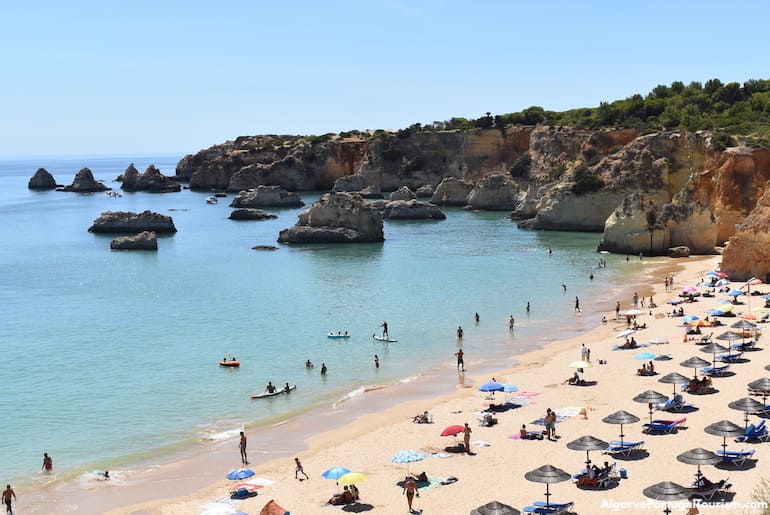
This is where tourism in Algarve was born in the 1960s and the favorite area of British, German and Dutch tourists . It goes from Faro to Portimão and is the most developed area . Some former fishing villages are now major resorts with high-rise apartment buildings and hotels, looking more like Miami or Costa del Sol in some parts (such as Praia da Rocha and Quarteira ). However, there are some extraordinary beaches and caves , including many of the region’s most beautiful (by Lagoa , Carvoeiro and Alvor ), some crowded, others secret, only accessible by boat and waiting to be discovered. Vestiges of a more traditional Algarve can be found in narrow whitewashed streets and on quiet coves. This is where you also find the most luxurious resorts ( Quinta do Lago , Vale do Lobo and Vilamoura ), the water parks and the liveliest nightlife (in Albufeira ). Inland is the historic town of Silves , with the Algarve’s best-preserved castle. Due to the variety of attractions for all budgets, it’s the most visited part of the region.
Eastern Algarve
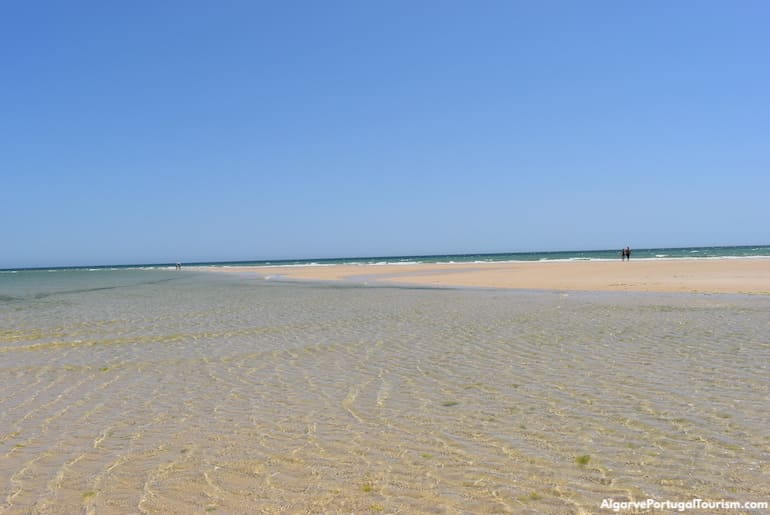
It goes from the Spanish border to the main city and regional capital (Faro, where there’s the international airport), and is mostly visited by Portuguese and Spanish tourists . The coastline says goodbye to caves and cliffs and hello to miles of dunes, lagoons, marshes and a series of sandy islands in the Ria Formosa Natural Park , home to some of the region’s best and most spacious beaches. It’s quieter than the central region and has charming small towns and villages like Tavira , Cacela Velha , Castro Marim and the fishing port of Olhão . These preserve traditional architecture of Roman and Moorish influence and are more typically Mediterranean when it comes to climate and water temperature.
Western Algarve
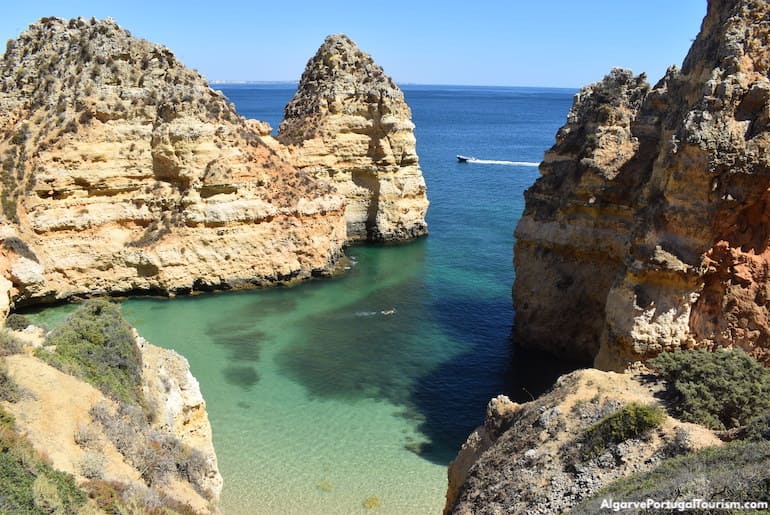
From Lagos to Sagres are small fishing villages and scenic beaches with golden rock formations . In Sagres the landscape changes, with soaring cliffs hiding breathtaking beaches for surfing and naturism . This west coast is the Costa Vicentina , considered the wildest in Europe . While Lagos has become popular with young tourists for its photogenic beaches, Sagres and Costa Vicentina still enjoy relative obscurity and remain the almost exclusive destination of surfers, hippies and naturists.
Algarve Tourism - Frequently-Asked Questions
When is the best time to visit algarve.
Algarve’s Mediterranean and Atlantic climate gives it pleasant weather throughout the year, with warmer and sunnier winters than elsewhere in Europe, but it’s never warm enough for the beach between November and March. However, temperatures and the sea are just fine for golfers and surfers in spring and autumn. The height of the tourist season is July and August (especially August, when families from around Portugal descend to the southern shores), so that’s when you find the beaches at their most crowded and prices at their highest. The best time to go is therefore late June or early September , especially for couples who prefer child-free environments at the beaches and hotels. The weather is suitable for sunbathing from late April to early October . The driest months are July and August, with an average of just one day of rainfall in July and zero days in August. June averages two rainy days and September has about five. There are twelve daily sunshine hours from June to August. High temperatures average 28C (82F) in June, 33C (91F) in July and 32C (90F) in August.
What is Algarve known for?
Algarve is known as one of the sunniest regions in Europe and with some of the continent’s finest beaches , extraordinary rock formations , amazing caves and golden cliffs . It is also one of the most beautiful places in the world ! It was first settled by the Phoenicians, Greeks, Carthagianians, and later by the Visigoths, but it was the Romans and the Moors who most left their mark. There are traces of Roman villas and mosaics around the region, while the many almond, fig and orange trees; latticed chimneys and white domed buildings reflect the Moorish heritage. When the kingdom of Portugal was founded in the 12th century in northern Iberia, it expanded south and conquered “Al Gharb” (“the West”). It was officially made part of Portugal in 1267. Two centuries later it played a major role in the Age of Discovery , when Prince Henry the Navigator established a pioneering navigation school in Lagos and Sagres, where ships were built and expeditions launched. The most visited monument in the region is the prince’s fortress in Sagres , which is a European Heritage Site for its significant role in European history and culture.
What is the most beautiful town in Algarve?
Most people will agree that Tavira is the best-preserved Algarve town and therefore the most beautiful. Others prefer Lagos, since its coastline is stunning and its beaches some of the most photogenic in the region. Carvoeiro is the winner of the smaller towns, serving as a gateway to some of the best and most famous beaches.
How many days should I stay in Algarve?
While many people do head to Algarve for just a weekend, it’s a destination for an extended holiday in the sun. The average length of a trip to Algarve is two weeks . Many people stay for a week, but there are families that stay the entire month of July or August. If you just want to get to know the region, five to seven days will be enough to experience the highlights, including the more famous caves, beaches, islands and monuments. In a grand tour, stopping at the main destinations, we recommend two days in Faro (including a trip to one or more of the islands), two days in Albufeira (beach-hopping), three days in Tavira (including a trip to Cacela Velha), two days in Carvoeiro (for the famous caves and beaches nearby), two days in Lagos, and two days in Sagres (which should include the beaches of Costa Vicentina).
Is Algarve Expensive?
Algarve has always been known as a budget-friendly destination , but that of course depends on where you stay and dine. There are luxury resorts and Michelin-starred restaurants, but also budget apartments and hotels for families, and restaurants serving good-value meals of fresh fish and other local delicacies. It’s certainly cheaper than St. Tropez, Sardinia, Ibiza, Mallorca and the other Balearic islands, or the Greek islands. In fact, it consistently ranks at the top of best-value beach destinations for travelers from the UK and around Europe. It’s considered the most affordable destination for summer holidays in the Eurozone, with prices about 25% lower than on the Costa del Sol, across the border in Spain.
Is Algarve Safe?
Portugal is a very safe country (it consistently ranks in the top 5 in the annual list of world’s most peaceful countries), but, naturally, in a major tourist destination like Algarve, unfortunate episodes do occur. Violent crime is very rare and the vast majority of tourists have a problem-free holiday, but always use common sense as you would back home. Always be aware of petty crime like pickpocketing in crowded places and never leave valuables in your car. It’s also a good idea to head back to your hotel as soon as you spot rowdy tourists and drunken behavior in nightlife areas, where trouble sometimes arises.
How to Go to Algarve
Algarve can be reached by regular flights from most major European capitals, and low-cost airlines also offer seasonal services from smaller cities. The international airport in Algarve is in Faro, which is roughly at the center of the region. There are also 30-minute flights and trains from Lisbon (the slower Intercidades train service takes 3 hours and 30 minutes and the faster Alfa Pendular takes 3 hours).
Do you need a car in Algarve?
You don’t need a car in Algarve if you stay in the major towns of Albufeira, Lagos, Faro, Vilamoura, and Tavira, where beaches are within walking distance and there are good public transportation links (trains, buses or ferries). However, to explore some of the best beaches and the smaller towns, you do need a car, have to rely on taxis or Uber (which will increase the cost of your holiday significantly), or have to plan your itinerary very carefully and use the often very infrequent buses.
Is English spoken in Algarve?
You’ll find that Portugal is the southern European country where English is better and more widely spoken, especially in the cities of Lisbon and Porto , and in Algarve. The British make up the biggest percentage of tourists in the region, so you can expect no problems communicating in English at hotels, most restaurants and shops.
Algarve Tourism - Quick Tips
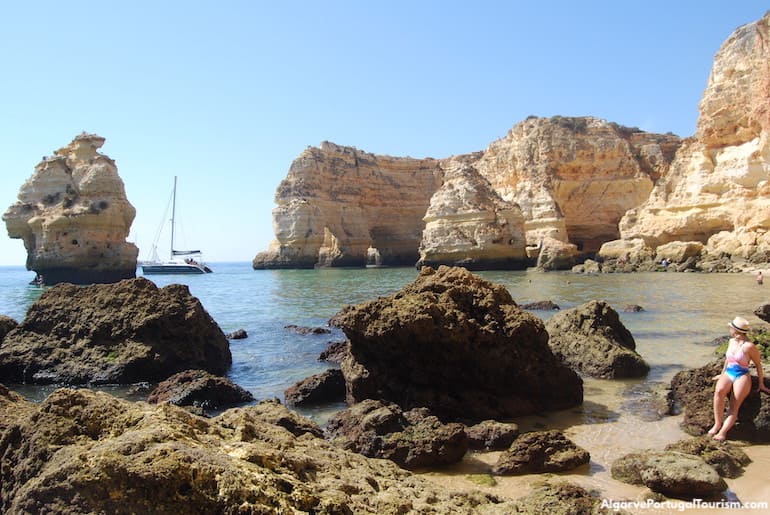
(See links to the different destinations at the bottom of this page)
Best Large Resort Towns - Albufeira, Lagos, Vilamoura
Best Small Resort Towns - Alvor, Carvoeiro
Best Small Villages - Burgau, Salema
Best Destinations for Families - Albufeira, Praia da Luz
Best Destinations for Young Tourists - Albufeira, Lagos, Praia da Rocha
Best Destinations for Mature Tourists - Albufeira, Alvor, Carvoeiro, Tavira
Best Destinations for Surfing - Costa Vicentina, Sagres
Nightlife Destinations - Albufeira (Praia da Oura), Praia da Rocha, Vilamoura
Luxury Resorts - Quinta do Lago, Vale do Lobo
Low-Cost Destinations - Armação de Pêra, Quarteira, Monte Gordo
Best Destinations for Culture and History - Faro, Lagos, Tavira
Golf Destinations - Praia dos Salgados (Albufeira), Quinta do Lago, Vale do Lobo, Vilamoura
Winter Destinations - Faro, Tavira
Official Algarve Tourism Office
Everything you need to plan your visit to Algarve is on this website. It offers complete and entirely independent information from locals and travel experts, not sponsored by or associated with any local institution or organization. However, if you still have any questions when you arrive, pass by the official tourist office at Faro airport. If you’re not arriving by plane, you’ll find tourist offices in all of the region’s main towns. They’re usually found in or around the main squares or pedestrian streets.
Algarve Map
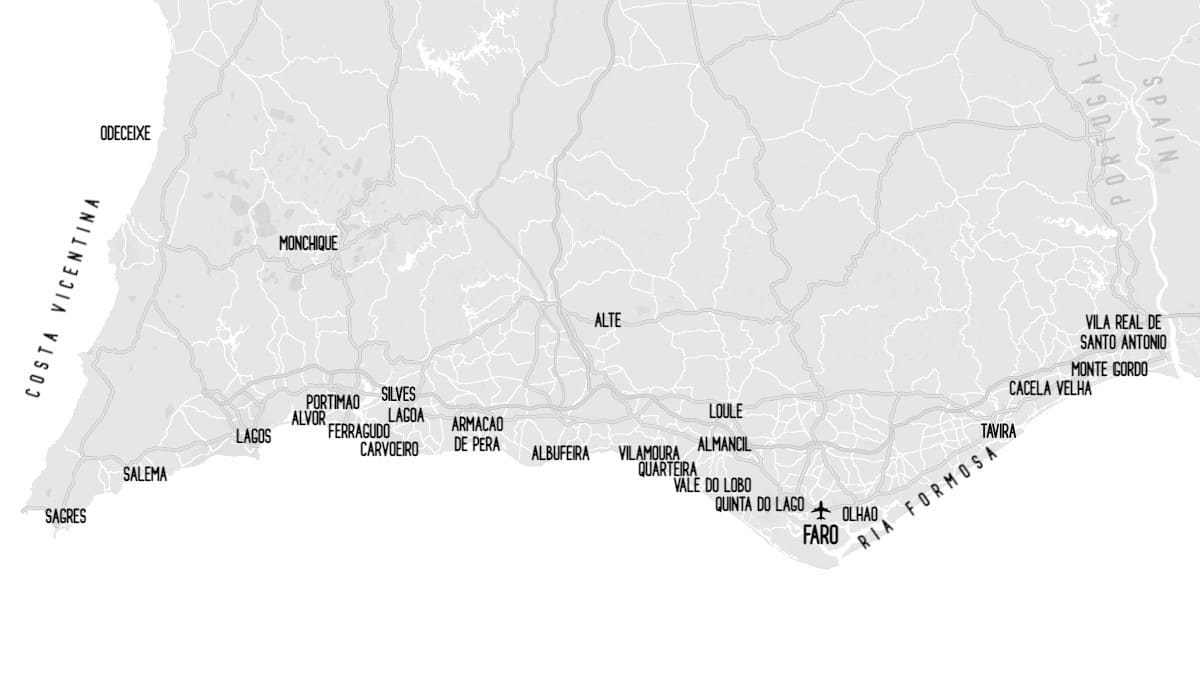
Complete Algarve Guide
Where to stay.
Top 10 Hotels
Beach Hotels
All-Inclusive Hotels
Hotels with Pool
Romantic Hotels
Design & Boutique Hotels
Luxury Hotels
Best Hostels
Budget Hotels
Family Hotels
Best Apartments
What to See and Do
Top 10 Attractions
Top 10 Places to Visit
Top 10 Monuments
Best Caves and Cliffs
Romantic Places
Algarve in Winter
50 Best Beaches
Nude Beaches
Secret Beaches
Surfing Beaches
Gay Beaches
Albufeira Beaches
Alvor Beaches
Carvoeiro Beaches
Costa Vicentina Beaches
Faro Beaches
Lagos Beaches
Olhão Beaches
Portimão Beaches
Sagres Beaches
Tavira Beaches
Transportation
Algarve Transportation
Faro Airport
From Lisbon
Other Portugal Destinations
Lisbon Beaches
Places in Algarve
Armação de Pêra
Cacela Velha
Castro Marim
Costa Vicentina
Monte Gordo
Quinta do Lago
Ria Formosa Natural Park
Vale do Lobo
Vila Real de Santo António
Algarve-Tourist.com
The best independent guide to the Algarve
Faro Introduction - Day trip to Faro - Top 10 Faro - Faro Beaches - Airport to Faro - Bone Chapel
Faro, Portugal: an independent tourism guide for 2024
Faro is a historic and culturally rich city that boasts a variety of fascinating tourist attractions. Sadly, Faro is often overlooked, considered only for its airport, but if you spend time in Faro, you will discover a charming Portuguese city.
Found within the historic quarter (the Cidade Velha) is a Gothic cathedral, the Paço Episcopal palace and the decorative Arco da Vila gateway. Outside of the city walls is a vibrant city, with pedestrianised shopping streets, characterful plazas and a wide variety of restaurants and bars.
To the south of Faro is the Parque Natural da Ria Formosa, a series of saltwater lagoons and waterways, which is an important ecosystem for migratory birds and marine life. On the seaward side of the Ria Formosa are three sandbar islands, and these are the location of Faro’s pristine beaches.
There is a lot to like about Faro, and it makes for an enjoyable day trip or destination during a touring holiday of the Algarve. This article will show you why you should visit Faro and how to get the most from the city. Related articles: Introduction to the Algarve – Top 10 Algarve
Highlights of Faro
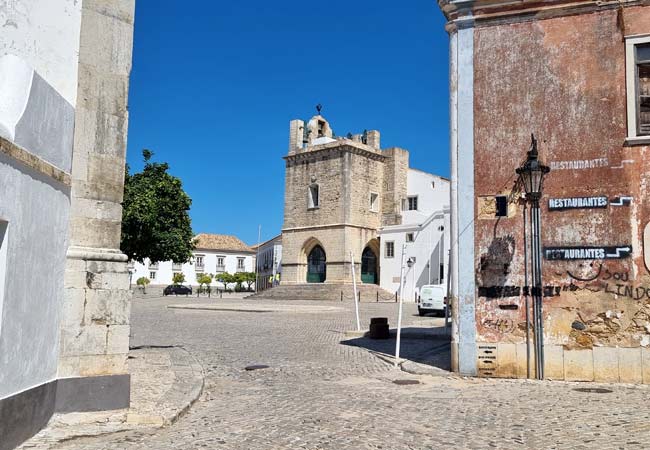
The Largo da Sé is a charming cobbled plaza located in the center of Faro's historic district, and is home to several important landmarks, including the old cathedral, the bishop's palace, and the city hall.
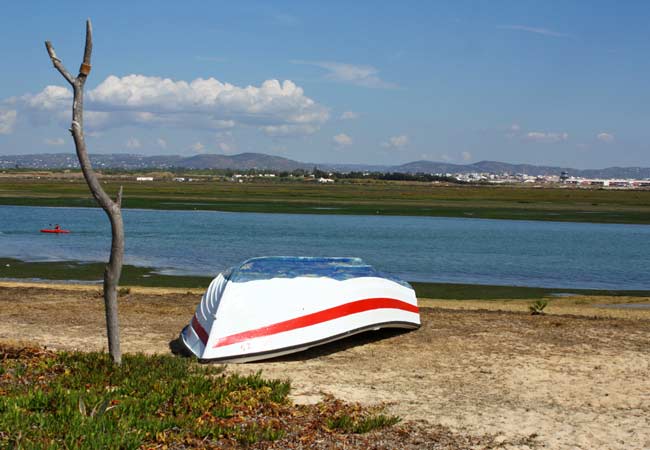
The Parque Natural da Ria Formosa, a network of saltwater lagoons and sheltered waterways, rich with aquatic life and best explored by a boat tour or kayak trip.
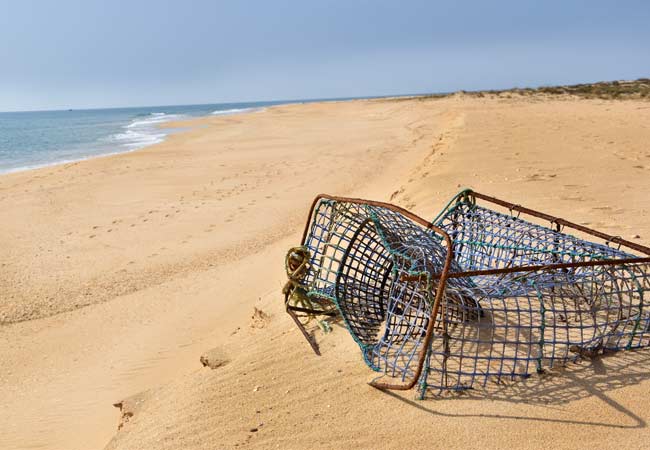
The Ilha Deserta, a deserted sandbar island on the southern side of the Parque Natural da Ria Formosa, known for its unspoiled, 6km-long coastline of sandy beaches. Along this coastline is the Cabo de Santa Maria, the most southernly point of Portugal.
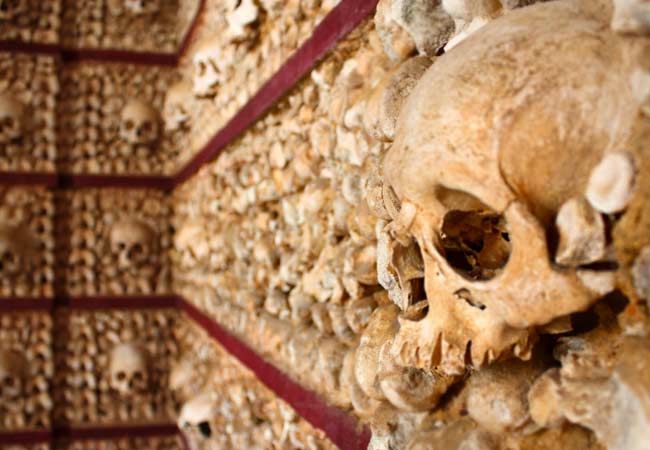
Faro Bone Chapel (the Capela dos Ossos) – A ghoulish chapel decorated with the bones of 1,200 monks who were excavated from the graves of the Nossa Senhora do Carmo church.
Faro as a day trip
Faro is the best day trip of the central Algarve region, especially if you are staying in Albufeira , Vilamoura or Quarteira . The city is home to many fascinating historical landmarks and has a unique Portuguese atmosphere that sets it apart from the surrounding resort towns.
Insight: The central Algarve region boasts many interesting day trips, such as the fishing port of Olhão and market town of Loule . However, Faro is the better day trip destination because it has more sights and attractions.
To fully discover Faro, plan at least four hours of sightseeing. The first half of your day could be dedicated to exploring the Cidade Velha, and the second half visiting the modern area of Faro, which includes the Capela dos Ossos (Bone Chapel).
Boat tours of the Parque Natural da Ria Formosa are typically full day activities, but there are shorter trips to the Ilha Deserta, if you wish to see the nature park in your day trip.
Being the largest city of the Algarve, Faro has excellent public transport from the surrounding region (details later in this guide). If you have a car, there is a large car park to the southeast of the city ( GPS: 37.011799, -7.932085 ).
Below is an interactive map for a suggested day trip to Faro. The green line shows a walking tour of the city, which starts from the bus station. ( Note: zoom out to see all of the points)
Sights of the tour: 1) Faro Marina 2) Manuel Bivar plaza 3) Igreja da Misericórdia (church) 4) Arco da Vila (gateway) 5) Porta Nova 6) Se Cathedral 7) Câmara Municipal (City Hall) 8) Faro Museum 9) Arco do Repouso (gateway ) 10) Rua de Santo António (shopping street) 11) Igreja de São Pedro 12) Igreja do Carmo 13) Capela dos Ossos Sights around Faro: 14) Cabo de Santa Maria 15) Ilha Deserta 16) Culatra fishing village 17) Forum Algarve (shopping centre) 18) Start of the N2 road * Beaches: 19) Praia de Faro 20) Praia Da Ilha Deserta 21) Praia do Farol 22 ) Praia da Ilha da Culatra * The N2 is the scenic road that extends along the entire length of Portugal, and is popular for road trips and biker-trips.
Sights for a day trip to Faro Faro Marina - here moors a mix of fishing boats and pleasure craft, but the height of the boats is severely restricted due to the railway bridge at its entrance!
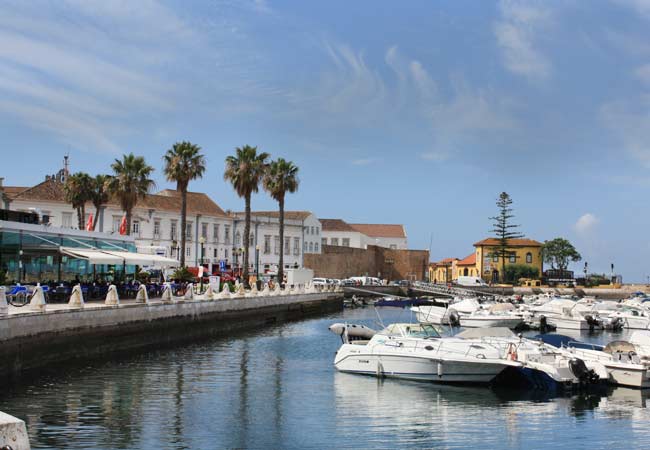
Arco da Vila - The decorative Baroque gateway which was constructed over the original Arabic gateway, and leads into the Cidade Velha. The towers of the Arco da Vila are a favourite nesting site for Faro’s Storks
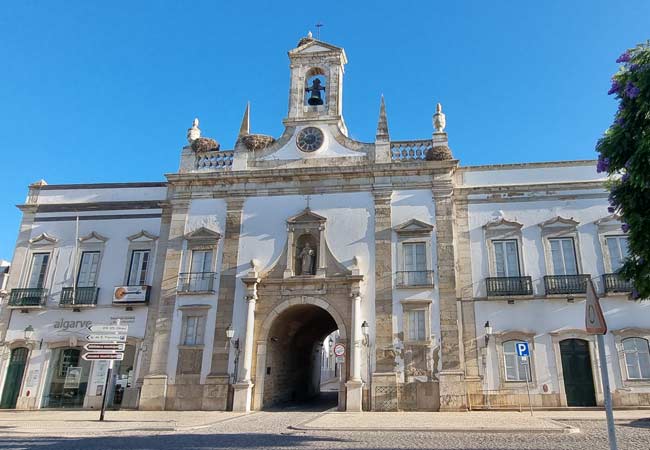
Porta Nova is the tiny gateway that leads down to the waterfront and the “Cais de embarque de Faro”, where the ferries and boat tours depart from.
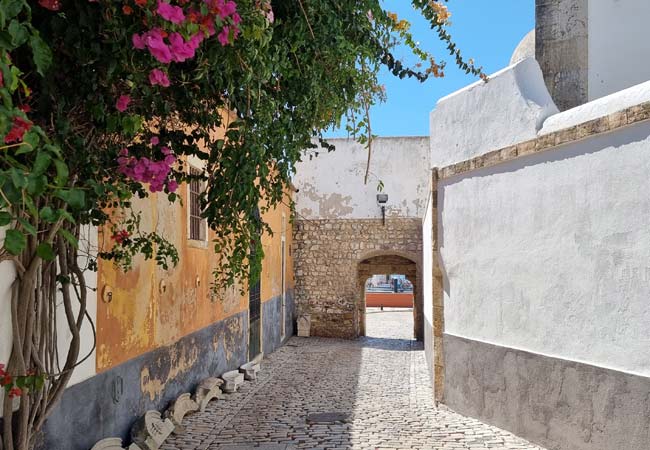
Rua de Santo António – The characterful shopping street of central Faro
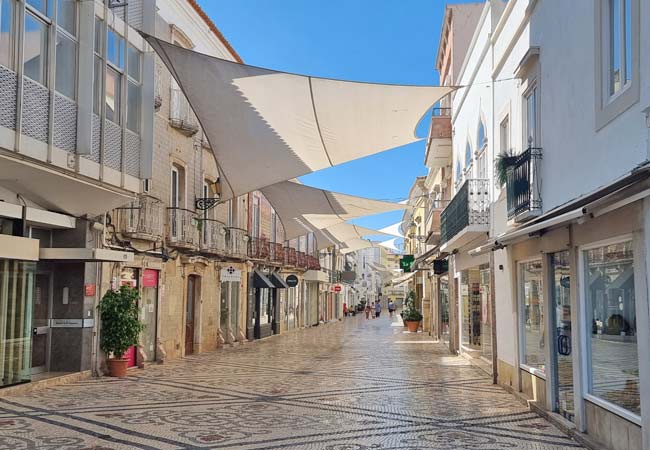
The view from the top of Faro cathedral , with views over the city and the Parque Natural da Ria Formosa
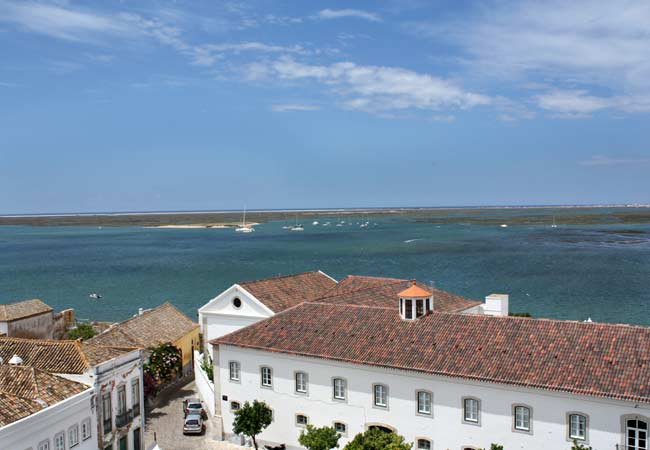
Igreja do Carmo – This grand Baroque church was funded by the spice trade from Brazil, and in the rear courtyard is the Capela dos Ossos
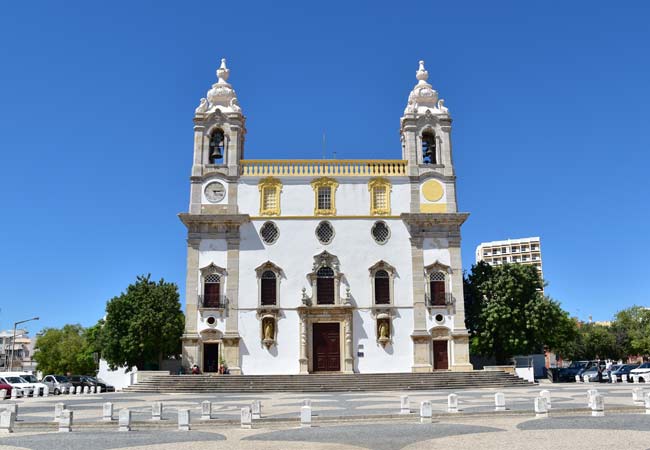
Faro holiday score and ratings
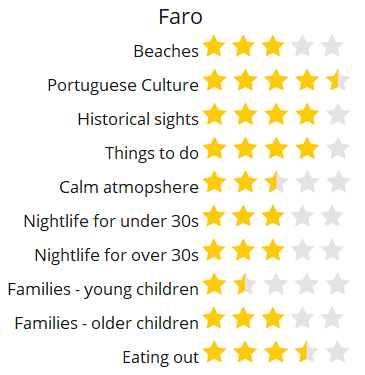
Faro activities and tours
There are many excellent tours and activities in Faro. The Parque Natural da Ria Formosa and the Ilha Deserta are often the focus of these tours, as they can only be reached by boat. Some of the best activities provided by GetYourGuide include: • A boat tour of Ria Formosa visiting two islands and a traditional fishing community • A nature tour of the Ria Formosa on a solar-powered boat • A dolphin watching tour departing from Faro harbour
Faro for a holiday
Faro makes an enjoyable, if slightly alternative, holiday destination. The city is ideal if you want an authentic Portuguese experience, in preference to a beach holiday.
Faro offers history and culture, along with a varied selection of cafes, restaurants and bars. Being a major city, there is decent nightlife, and this tends to be aimed at Portuguese patrons, rather than foreign tourists. By day Faro has an unhurried and calm ambience, but by night there is a surprising buzzing and social nightlife.
Insight: Faro has no beaches which are within walking distance of the city centre, and a bus (to the Praia de Faro) or ferry (Praia Da Ilha Deserta) must be caught. Faro is not a destination for a beach focused holiday.
Faro is a good base from which to explore the Algarve by public transport. Tavira is only 40 minutes by train to the east, Vilamoura is 30 minutes by bus to the west, and even Lagos at the very western edge of the Algarve, can be reached by a direct train.
If you are considering a holiday to Faro, you should be aware that this is a major residential city, and not some beautified or manicured resort town. Some sections of the city are dilapidated (but are perfectly safe), and unfortunately, are on the main bus route into the city, which gives a bad first impression of Faro. This opinion always changes when the historic centre and harbour are discovered!
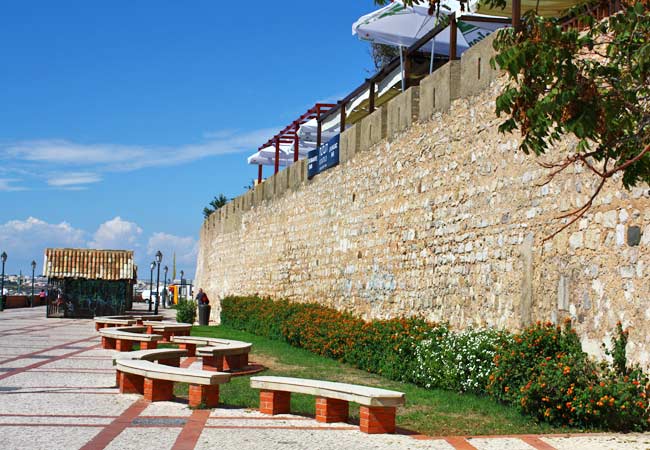
The city walls of Faro date from the Moorish era and encircle the entire Cidade Velha
How long to spend in Faro?
There are three different suggested lengths for a visit to Faro; one day, three days or a week.
The one-day stay is recommended if you arrive on a late flight and need a short stopover before heading to your main holiday destination. Faro can be easily explored in a single day and makes for an interesting introduction to the Algarve, before catching the train or bus to your next location.
A stay of three nights allows Faro and the surrounding region to be fully discovered. This length provides you time to explore historic centre, tour the Parque Natural da Ria Formosa, relax on the Praia de Faro or Ilha Deserta beaches, and have a day trip to Estoi or the Ilha da Culatra. Three nights is the ideal length of stay if you are touring the Algarve and are not rushed for time.
A seven-night stay in Faro is perfect if you wish to spend your entire holiday based in Faro. This holiday makes use of the excellent public transport from Faro to explore the entire central Algarve via day trips, while being based in a cosmopolitan city.
From Faro, it is possible to take day trips to Olhao, Tavira, Loule, Albufeira and Vilamoura, and longer train journeys connect to Silves and Lagos.
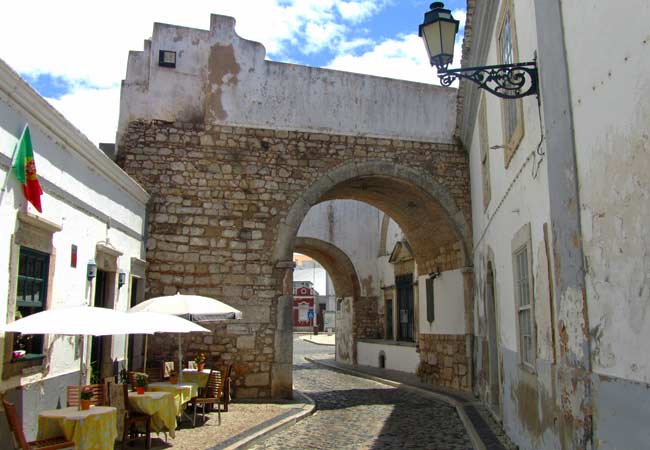
The Arco do Repouso gateway leading into the Cidade Velha
Where to stay in Faro?
Generally, most tourists book their accommodation within 300m of the Jardim Manuel Bivar plaza and the Doca de Faro. Faro is a compact city, and this area covers the main tourist sights, the bus and train stations and popular restaurants.
As for hotels; the Hotel Faro and Eva Senses Hotel are both highly regarded, have roof terraces and are centrally located. A recommended cheaper alternative is the Stay Hotel Faro Centro. If you need a hotel close to Faro airport, consider the Hotel 3k.
The map below shows the location of hotels and rental rooms in Faro, and by altering the date to your holiday, the map will display current prices:
The beaches of Faro
Faro city should not be considered as a beach holiday destination. The beaches of Faro are found on the southern side of the three sandbar islands (Ilha de Faro, Ilha Deserta and the Ilha da Culatra), and cannot be walked to.
The Ilha de Faro has a 5km coastline of golden sands, and this beach is referred to as the Praia de Faro. The Praia de Faro has low-key tourist development, with relaxed cafes and small beach bars. This is surprising considering it is less than a five-minute drive from Faro airport.
There is a direct bus (route 16) from the Próximo Bus Station (in Faro) to the Praia de Faro beach; this route also serves the airport.
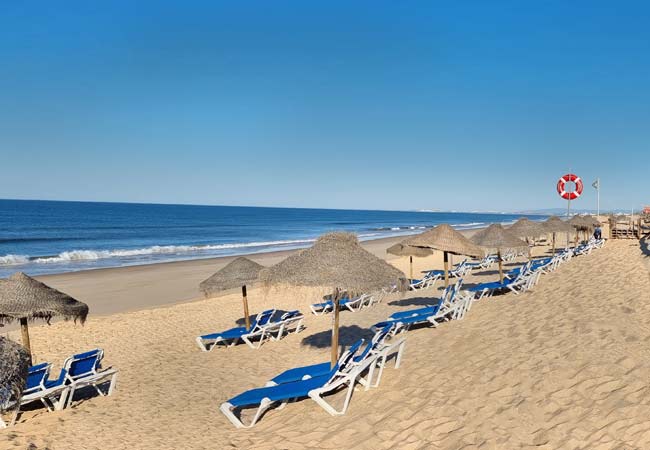
Praia de Faro, just a short bus ride from Faro
Ilha Deserta, as its name suggests, is an uninhabited sandy island that can only be accessed by boat. The southern part of the island features a beach called Praia Da Ilha Deserta, which stretches for over 6km and is known for its pristine, unspoiled sands. Midway along the beach is Cabo de Santa Maria, the southernmost point of Portugal.
A wooden boardwalk runs along the northern side of the island, passing through a sparse vegetation of beach scrub. Despite its beauty and seclusion, the Praia Da Ilha Deserta is not the most convenient destination for a beach trip, and many visitors opt for the more accessible Praia de Faro instead.
The Ilha da Culatra has similar beaches to the Ilha de Faro and on the northern side of the island is the traditional fishing village of Culatra. On Ilha da Culatra, the main beaches are the Praia da Ilha do Farol and the Praia da Ilha da Culatra. Farol beach is next to the lighthouse and is closer to Faro. Again, a ferry is needed to travel to the Ilha da Culatra, so for most beach day-trippers, the Praia de Faro is the better destination. Related articles: Faro beaches
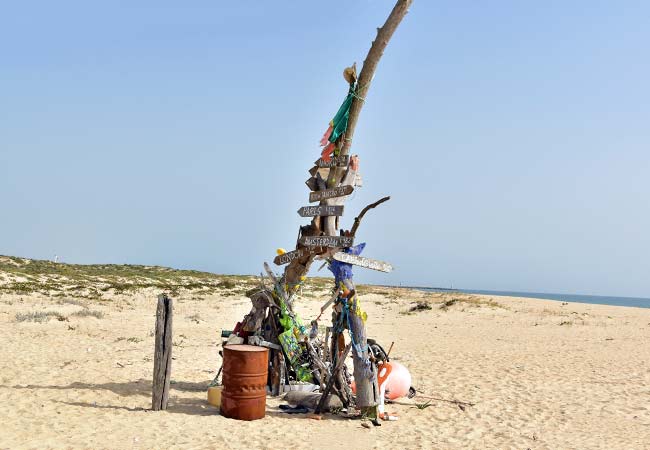
The Cabo de Santa Maria is marked by a driftwood and sea-waste monument
Faro weather
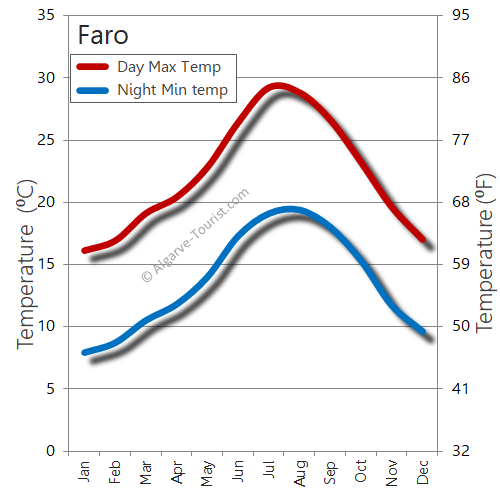
The daytime maximum temperature of Faro (as measured in the shade) and night-time minimum
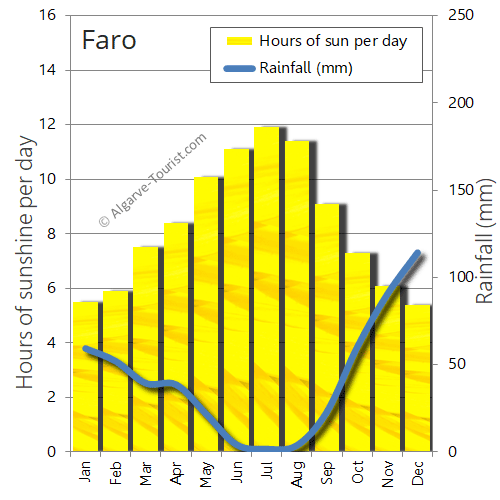
The average hours of sunshine per day and monthly rainfall for Faro
Faro is the Algarve’s transport hub
Faro airport is the main international airport of southern Portugal, and is situated 7km southwest of the city. Faro bus and train stations are located in the centre of Faro city, and departing from here are regional services covering the whole of the Algarve, along with routes to Lisbon and northern Portugal.
Useful public transport websites include: • Comboios de Portugal (trains) - www.cp.pt • Vamus (regional buses) - vamusalgarve.pt • Rede Expressos (intercity buses) - www.rede-expressos.pt
Unfortunately, none of these public transport services connects directly to the airport. Therefore, if you wish to head to your holiday destination using public transport, you will have to travel into Faro city first.
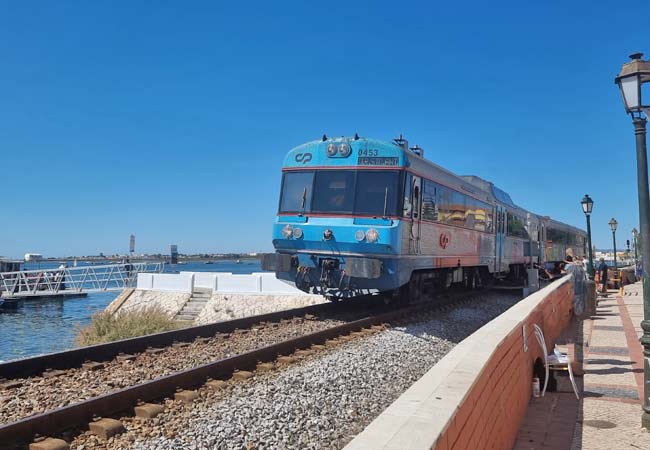
The Algarve regional railway, slow but inexpensive
How to Travel from the airport to Faro city?
There is very limited public transport from Faro airport to Faro city. There is a single bus service (€2.60 adult) that departs every 30-40 minutes between 6am and midnight. This bus (route 16) terminates at the Proximo bus station, and is next to the intercity bus station or 200m from the train station.
A taxi from the airport to Faro is a more convenient and faster option, costing €15-20. Uber operates in the Algarve, but there can be high demand during the summer months. The price for a private transfer (with a driver waiting at the airport for you) to Faro, is from €25 and more details can be found here . Related articles: Faro airport to Faro city
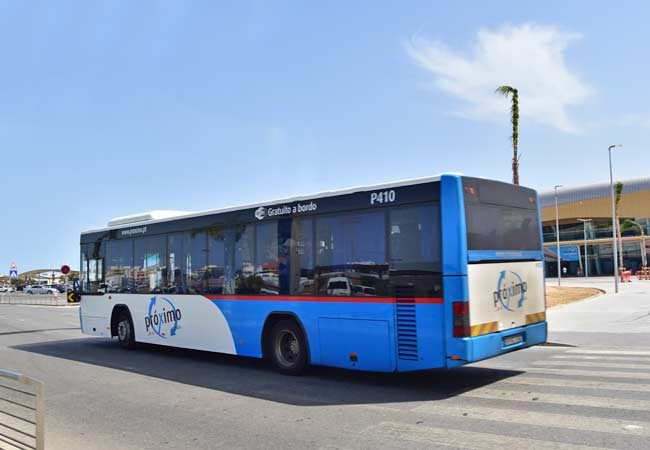
The number 16 bus heading to Faro bus station
Day trips from Faro
Popular day trips from Faro include; the fishing town of Olhão, the market town of Loulé or the fishing communities on the Ilha da Culatra island.
An alternative day trip is to the pretty village of Estoi. Found in Estoi is the pink Estoi Palace, the finest example of Rococo architecture in the Algarve, while just outside of the village are the Milre Roman ruins, of a once-grand villa Related Articles: Day trip to Estoi – Loulé guide
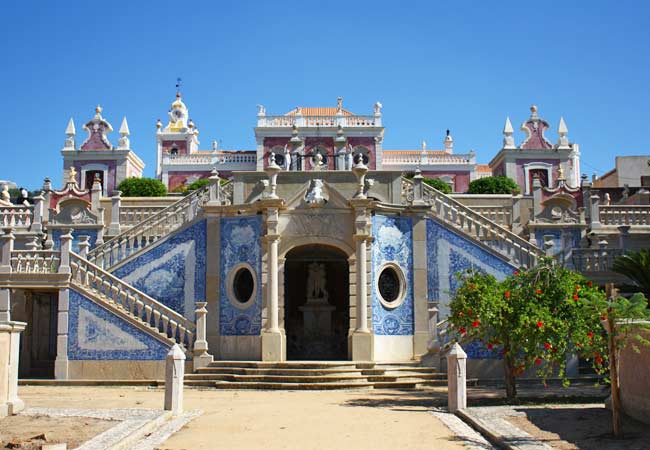
The beautiful azulejos tiles of the Palácio de Estoi gardens
Our most popular guides for Faro and the Algarve

Home page and introduction to Faro
Faro top 10

What are the best sights and activities in Faro?

How to get the most from your day trip to Faro
Faro Beaches

Discover the pristine beaches hidden within the Faro region
Need a Hotel?

Reviews of Faro's hotels and book to get the lowest price!
Estoi Day Trip

Small village with many sights that is enjoyable day trip from Faro
Ria Formosa Tour

A guide to the boat tours of the Natural da Ria Formosa
Praia de Faro

The best beach of the Faro region, and only short bus ride from Faro
Airport to Faro

How to travel from Faro airport to the city of Faro?
Bone Chapel

Faro's most unusual chapel is lined the bones of 1,000 skeletons
Where to stay?

What Algarve town is the best for your holiday?

The largest and liveliest resort town of the Algarve

The most charming town of the eastern Algarve

The Algarve's slice of sophistication and exclusivity

Experience authentic Algarve in this pretty market town
All of our guides to the Algarve
Faro - Getting Started
Faro Introduction Faro's best hotels Faro in 3 Days Day Trip to Faro Faro Weather Faro Airport to the city Faro or Tavira ?
Vilamoura guides
- Vilamoura introduction
- Things to do and see
- 1 week in Vilamoura
- Vilamoura best hotels
- Vilamoura Beaches
- Airport to Vilamoura
Lagos guides
- Lagos Introduction
- 1 Week in Lagos
- The Ponta da Piedade
Praia da Rocha
- Introduction to Rocha
- Sights & activities
- Portimão city
- Rocha beaches
Sights and Beaches
Faro Sights and Attractions Faro beach guide Ilha da Barreta Ilha da Culatra Bone Chapel Day trip to Estoi Praia de Faro Faro to Silves
Algarve guides
- Algarve Introduction
- Best town in the Algarve?
- Itineraries and tours
- Algarve for Families
- Day trips in the Algarve
- Algarve for Christmas
- Slow travel in the Algavre
- Algarve's best golf courses
- Lisbon to the Algarve
- Praia da Marinha beach
- Praia da Falésia
- The Algarve in September
Carvoeiro guide
- Carvoeiro introduction
- Carvoeiro beaches
- Sete Vales Suspensos hike
- Ferragudo day trip
Albufeira guides
- Albufeira introduction
- 1 week in Albufeira
- Albufeira beaches
Portugal guides
- Where to go in Portugal?
- Top 10 Portugal
- 1 week in Portugal
- A weekend in Portugal
- Top 10 beaches
Tavira guides
- Tavira Introduction
- Tavira top 10
- 1 Week in Tavira
- Tavira beaches
- Tavira day trips
- Anchor cemetery
Algarve Towns
- Armação de Pêra
- Monte Gordo
- Olhos de Água
- Praia de Luz
- Vila Nova de Milfontes
The best tourist destinations in Portugal
Aveiro , Braga , Batalha , Cascais , Coimbra , Estoril , Evora , Guimaraes , Lisbon , Nazaré , Obidos , Madeira , Peniche , Porto , Sesimbra , Setubal , Sintra , Tomar , Troia Peninsula , Viama Do Castelo
Faro Portugal Algarve Tourist © 2024 Algarve-Tourist.com - Privacy Policy & Contact Page

The Best Guide to Faro
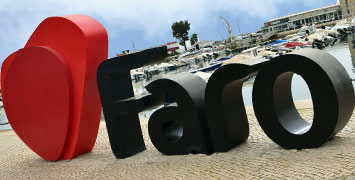
5 Towns You Should Visit in the Algarve
:max_bytes(150000):strip_icc():format(webp)/Dave-yachtheadshot-668px-5b7324c6c9e77c0025c497d1.jpg)
Stuart Black/Getty Images
If you think all there is to the Algarve is sun umbrellas and crowds of holidaymakers, it’s time to think again. Rent a car or jump on a bus or train, and whether you’re heading along the coast, into the interior, or up into the mountains, there are many towns and villages that have a culture and history all their own.
When you're heading to southern Portugal , these are five cliché-defying towns absolutely worth visiting.
Regularly described as the prettiest town in the Algarve, if you’re going to pick just one place to check out during your trip, Tavira is it. All white walls and red terracotta roofs, cobblestones small fishing boats, Tavira is the kind of traditional Portuguese town that tourist brochures are made of.
Sitting on either side of the picturesque Gilão river, with a so-called “Roman” bridge linking the two sides, Tavira lies just inland from the Atlantic Ocean, with several attractive beaches nearby. A ruined castle overlooks the town from a convenient hilltop and is well worth the sweaty walk uphill to visit for an hour or two.
With plenty of restaurants, both along the riverfront and on surrounding streets, finding a good meal is far from difficult. While much of the town was destroyed in the huge earthquake that shook the region in 1755, there are still plenty of historic spots, including a rebuilt church that originally dated from the thirteenth century, to satisfy history buffs.
Speaking of history buffs, visitors with an interest in Moorish art and architecture should head inland and straight for Silves, a former capital of the Algarve.
The Silves Castle looms from a nearby hilltop, and it’s worth visiting the town just to check it out. You’ll pay less then three euros for an entry ticket, a bargain considering the well-preserved walls and gardens of this impressive fortress.
Archaeological remains place fortifications on the site as far back as the Bronze Age, but what remains today dates from the Moorish occupation of the castle between the eighth and 12th centuries. Excavation of the area continues to this day, with additional buildings and artifacts being regularly discovered.
Other sites of note in the town include parts of the old city walls, attractive churches, an archaeological museum, and the Silves Cathedral, a former mosque that is now on the Portuguese register of national monuments. Surrounding the town are valleys full of orange groves.
Vila Real de Santo Antonio
Right on the border with Spain sits Vila Real de Santo Antonio, a relatively new town (by Portuguese standards) that dates back to "only" 1773.
Formerly a major fish-canning center, industry is now more diverse, split between tourism, fishing, and trade, often with Spanish visitors who cross the Guadiana river to take advantage of cheaper prices.
There’s more to the town than inexpensive fish and textiles, however. Accessible by bus, train, car or ferry (from Spain), Vila Real de Santo Antonio is less than two miles from Monte Gordo, a small village with a long stretch of white sandy beach, and several woodland trails to explore. If you’re looking for an excuse to jump in the ocean, sea temperatures are typically a few degrees warmer here than elsewhere on the Portuguese coast.
Coupled with an attractive riverfront, large central square, and several tempting restaurants, a visit to Vila Real de Santo Antonio is a highly-worthwhile day trip, far away from the crowds of the western Algarve.
Most visitors would find the small town of Estoi easy to overlook. Sitting inland, northeast of Faro and just off the A22 motorway that bisects the Algarve, Estoi’s main claim to fame actually lies half a mile or more from the town itself.
The oldest parts of the Milreu Roman ruins date back to a farmhouse from the first and second centuries AD, but the most interesting buildings were constructed a century or two later. A large, opulent villa, complete with thermal baths and underfloor heating, was later coupled with a temple, complete with mosaic floors that are still visible today.
The temple’s usage changed over the centuries, in line with the dominant religion of the day. Initially thought to be used for a water cult, it had become Christian by the sixth century and switched to a mosque after the Moors invaded in the eighth century.
While much of the site collapsed and was abandoned after the 1755 earthquake, the farmhouse itself was occupied until relatively recently, and is still used for art exhibits today.
With entry a very reasonable two euros (half that for senior citizens), there’s little excuse not to take a detour via Estoi to check out this fascinating slice of Roman history on the Iberian peninsula.
If your tastes lean more towards epic views to lapping waves, forget the coastline and head for the hills . Monchique, in the Algarve’s mountainous interior, is the ideal base for delicious regional food and an endless array of hiking opportunities.
The town is best approached by car, but once you’ve arrived, you’ll find it much easier to park up and explore the narrow, steep and winding streets on foot. Meat-lovers should be sure to order some of the spicy local chouriço sausages and morcela (black pudding), and the medronho liqueur is a regional specialty that's also well worth trying. Beware, though – it’s often described as firewater by the unwary!
To work off all that food and drink, pick one of several walking trails. The steep paths will get the heart pumping, for anything from short nearby hikes to multi-day treks on the Via Algarviana that passes right through the town.
A popular round-trip walk takes you to Foia, the highest point on the Algarve, with views as far as the Atlantic Ocean on a clear day. It’s ten sweaty miles to the top and back again, but if you don’t fancy hiking quite that far, there’s a road that goes all the way to the summit, and local taxi drivers will be more than happy to take you up there.
November in Portugal: Weather, What to Pack, and What to See
San Gabriel Mission
The Top 8 Attractions in Lisbon's Baixa Neighborhood
Your Trip to Morocco: The Complete Guide
15 Top Things to Do in Lisbon, Portugal
The 9 Best Day Trips From Faro, Portugal
One Week in Portugal: The Perfect Itinerary
A Guide to Faro Beaches
The 18 Top Things to Do in Meknes, Morocco
Visit the East Coast of Spain
Batalha Monastery: The Complete Guide
48 Hours in Casablanca: The Ultimate Itinerary
The 7 Most Beautiful Buildings in Porto
The 12 Best Things to Do in Casablanca
10 of the Best Places to Visit in Morocco
Tarquinia Travel Essentials

IMAGES
VIDEO
COMMENTS
The Algarve region and its beaches are a top tourism destination in Portugal. Our map shows the best cities to visit. Wandering Portugal > maps. The Algarve is a popular tourist region in the south of Portugal; tourism makes up the bulk of the Algarve's economy, along with fruit and almonds. Faro is the regional capital of the Algarve Region.
All year round, the region's beaches, nature reserves, typical villages, golf courses, castles and fortresses stand before you in all their splendour. This map shows you all of the different options. For more information and to download other brochures and maps about the Algarve region, please see https://www.visitalgarve.pt. IDIOMA: PT EN.
The Best Places to Visit in the Algarve. 1. Praia da Marinha. Praia da Marinha ranks among the 100 most beautiful beaches in the world, thanks to its exceptional setting and impressive rock formations. This rock formation in the photo is called "Arco Natural".
7. Seven Hanging Valleys Trail. Seven Hanging Valleys Trail is the most popular coastal hike in Algarve. It follows the coastline between Praia da Marinha and Praia do Vale de Centeanes. On the way, you also pass Benagil Cave, Benagil Beach, Carvalho Beach, and Alfazina Lighthouse, to mention just the main highlights.
Map showing the Algarve region of Portugal. Click on major towns for more information. +. Algarve map showing all major towns and cities and road links.
8. Galé. Best place for couples. The quiet village of Galé is one of the best places in the Algarve for a romantic getaway. The town's picturesque beach ( Praia da Galé) is an obvious choice for a day on the waterfront, and even more secluded spots (like Praia das Salamitras) are a short hop from town.
map to travel: algarvepromotion.pt. Wikivoyage. Wikipedia. Photo: Stevenfruitsmaak, CC BY-SA 3.0. Photo: Inkey, CC BY-SA 3.0. Popular Destinations. Faro. ... Portimão is the second biggest city in the Algarve, Portugal, and famous for its fresh fish restaurants, grilled sardines being the most famous dish. Lagos. Photo: ...
Get to the heart of The Algarve with one of our in-depth, award-winning guidebooks, covering maps, itineraries, and expert guidance. Portugal. $ 24.99. Pocket Madeira. $ 14.99. Pocket Lisbon.
1. Cliff walk at Praia da Marinha. Arguably the most picturesque beach in Portugal; Marinha Beach and its surrounding cliffs are one of the things you must do in the Algarve. The beach is a stretch of soft sand surrounded by limestone cliffs and turquoise waters. Here are all your hotel options in Algarve.
Algarve. It was here that, in the 15th century, the Portuguese set off on the epic journey that led them to discover other peoples and cultures… and it is in the Algarve that we cheerfully welcome many of our visitors. Even the climate is mild and sunny all year round! There's no shortage of high quality beaches either.
Description: This map shows cities, towns, villages, resorts, railroads, highways, main roads, secondary roads, marinas, airports, beaches, golf courses in Algarve.
This is our recommended Algarve itinerary for first trip: DAY 1: East Algarve. DAY 2: Central Algarve + Benagil Caves & dolphin-watching. DAY 3: Most Beautiful Coastlines. DAY 4: Ponta da Piedade & Lagos. DAY 5: Sagres & West Coast. Below, you can find a detailed day-by-day itinerary with more info, tips, and photos.
Here are the best things to do in Faro: 1. Faro Old Town. When you first arrive in Faro, the best place to start your visit is the historic Old Town.This picturesque maze of narrow cobbled streets, white-washed buildings, and charming plazas is like a step back in time where you can catch a glimpse of the authentic Algarve.
The Algarve - an independent tourism guide for 2024. The Algarve is the beautiful southern coastline of Portugal. It is a region blessed with glorious sandy beaches, picturesque fishing towns and a glorious climate, all of which combine to create the perfect holiday destination. The Algarve is wonderfully varied; there are pristine beaches for ...
2. Praia da Falésia. Source: Katvic / shutterstock. Praia da Falésia, Algarve. Pushing on for almost seven kilometres is a golden sandy beach traced by cliffs streaked with various ochre hues. The competition is stiff, but this may be the greatest beach in the Algarve and is also one of the longest in Portugal.
8) The Bone Chapel in Faro. 7) The Cabo de São Vicente. 6) The fishing village of Ferragudo. 5) The Anchor cemetery at Barril beach. 4) The Praia da Marinha beach. 3) The Castelo de Silves and Silves. 2) The Ponta da Piedade headland. 1) The traditional town of Tavira. Top 10 activities for your holiday to the Algarve.
1. Faro. Faro's Old Town. Busy Faro is the capital city of the Algarve, and its international airport is the gateway for many tourists arriving in southern Portugal. As the largest city in the region, Faro accommodates around 50,000 inhabitants and is a modern industrial and manufacturing hub.
The Algarve region could be divided into three sub-regions -- the east, central, and western Algarve. Each offers a different experience, so where you go depends on what type of holiday you want to have: Central Algarve. This is where tourism in Algarve was born in the 1960s and the favorite area of British, German and Dutch tourists.
Being the largest city of the Algarve, Faro has excellent public transport from the surrounding region (details later in this guide). If you have a car, there is a large car park to the southeast of the city (GPS: 37.011799, -7.932085). Below is an interactive map for a suggested day trip to Faro.
View Map. Address. 8800 Tavira, Portugal. Regularly described as the prettiest town in the Algarve, if you're going to pick just one place to check out during your trip, Tavira is it. All white walls and red terracotta roofs, cobblestones small fishing boats, Tavira is the kind of traditional Portuguese town that tourist brochures are made of.